-
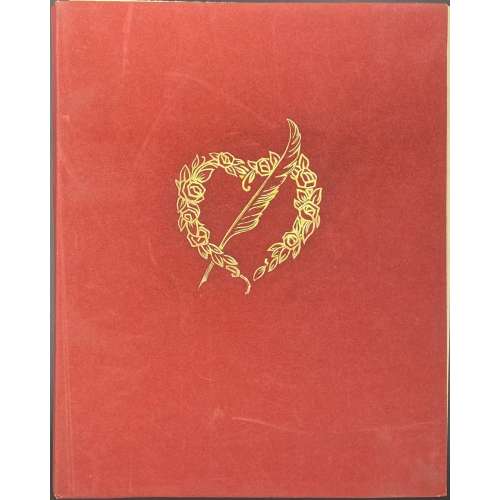 Softcover volume, 24.7 x 19.7 cm, red felt with gilt embossing to front, pages framed in red, watermarked Arches wove paper, lower and outer margins untrimmed; matted original drawing (watercolour, India ink, graphite on Arches wove paper), signed André Collot and dated 36 laid in. Title-page (red and black): ANDREA DE NERCIAT | LE DOCTORAT | IMPROMPTU | ILLUSTRÉ | D’EAUX-FORTES ORIGINALES | PAR | ANDRÉ COLLOT | {publisher’s device} | LA TRADITION | PARIS || Pagination: [2] blank, [1, 2] h.t./limitation, [3, 4] frontis., [5, 6] t.p./blank, 7-125 [126] blank, [2] colophon/blank, [2] blank; 7 full-page (incl. frontispiece) and 9 half-page plates, 2 tailpieces and 2 initials (etching and au pochoir colouring after André Collot); total 132 pages (66 leaves, incl. plates within collation). Limitation: A print run of 500 copies; this is № 268. Colophon: Paul Durupt supervision, text at Coulouma / H. Barthélemy, plates at La Tradition (Paris); date of printing: 30-APR-1935 Contributors: André-Robert Andréa de Nerciat (French, 1739 – 1800) – author. André Collot (French, 1897 – 1976) – artist.
Softcover volume, 24.7 x 19.7 cm, red felt with gilt embossing to front, pages framed in red, watermarked Arches wove paper, lower and outer margins untrimmed; matted original drawing (watercolour, India ink, graphite on Arches wove paper), signed André Collot and dated 36 laid in. Title-page (red and black): ANDREA DE NERCIAT | LE DOCTORAT | IMPROMPTU | ILLUSTRÉ | D’EAUX-FORTES ORIGINALES | PAR | ANDRÉ COLLOT | {publisher’s device} | LA TRADITION | PARIS || Pagination: [2] blank, [1, 2] h.t./limitation, [3, 4] frontis., [5, 6] t.p./blank, 7-125 [126] blank, [2] colophon/blank, [2] blank; 7 full-page (incl. frontispiece) and 9 half-page plates, 2 tailpieces and 2 initials (etching and au pochoir colouring after André Collot); total 132 pages (66 leaves, incl. plates within collation). Limitation: A print run of 500 copies; this is № 268. Colophon: Paul Durupt supervision, text at Coulouma / H. Barthélemy, plates at La Tradition (Paris); date of printing: 30-APR-1935 Contributors: André-Robert Andréa de Nerciat (French, 1739 – 1800) – author. André Collot (French, 1897 – 1976) – artist. -
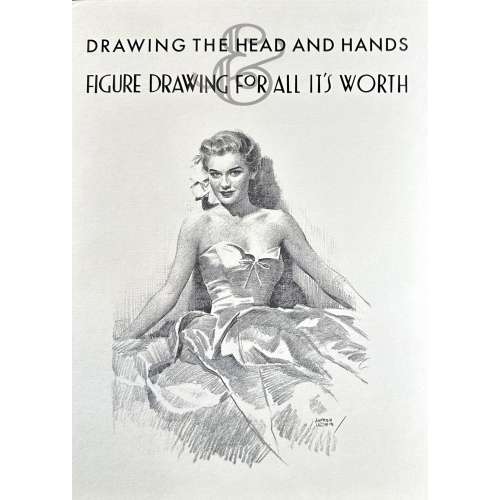 Cardboard box 32 x 23.7 cm with lettering and vignette to front, lettering to spine, and Loomis facsimile and Titan publisher's barcode label to back.
Cardboard box 32 x 23.7 cm with lettering and vignette to front, lettering to spine, and Loomis facsimile and Titan publisher's barcode label to back.- Title-page: Drawing | THE HEAD AND HANDS | BY | ANDREW LOOMIS | {vignette} ||
- Title-page: FIGURE DRAWING | FOR ALL IT'S WORTH | ANDREW LOOMIS ||
-
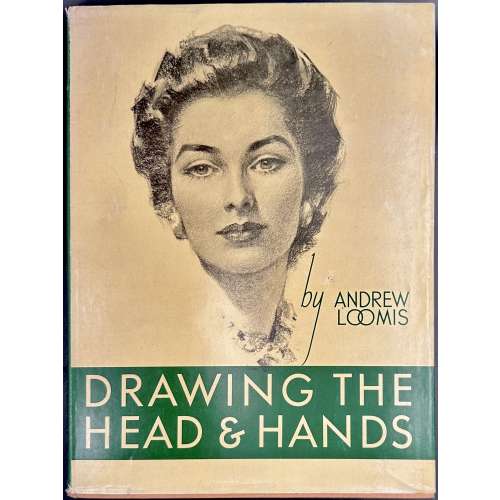 Hardcover volume, 31 x 23.5 cm, peach cloth, with peach lettering to the green label on front board, green lettering to spine, pictorial dust jacket, price unclipped ($4.95); text to flaps; pp.: [1-6] 7-154 [155 plate] [5 blanks], ils. (photomechanical reproductions); magazine clipping laid in. Title-page: Drawing | THE HEAD AND HANDS | BY | ANDREW LOOMIS | {vignette} | NEW YORK • THE VIKING PRESS || Imprint: COPYRIGHT © 1956 BY ANDREW LOOMIS | FIRST PUBLISHED BY THE VIKING PRESS IN JANUARY 1956 | PUBLISHED ON THE SAME DAY IN THE DOMINION OF CANADA | BY THE MACMILLAN COMPANY OF CANADA LIMITED | SECOND PRINTING 1958 | {two paragraphs of copyright statement} | LITHOGRAPHED IN U.S.A, BY W. S. KONECKY ASSOCIATES || Edition: 1st edition, 2nd printing. Andrew Loomis (American, 1892 – 1959)
Hardcover volume, 31 x 23.5 cm, peach cloth, with peach lettering to the green label on front board, green lettering to spine, pictorial dust jacket, price unclipped ($4.95); text to flaps; pp.: [1-6] 7-154 [155 plate] [5 blanks], ils. (photomechanical reproductions); magazine clipping laid in. Title-page: Drawing | THE HEAD AND HANDS | BY | ANDREW LOOMIS | {vignette} | NEW YORK • THE VIKING PRESS || Imprint: COPYRIGHT © 1956 BY ANDREW LOOMIS | FIRST PUBLISHED BY THE VIKING PRESS IN JANUARY 1956 | PUBLISHED ON THE SAME DAY IN THE DOMINION OF CANADA | BY THE MACMILLAN COMPANY OF CANADA LIMITED | SECOND PRINTING 1958 | {two paragraphs of copyright statement} | LITHOGRAPHED IN U.S.A, BY W. S. KONECKY ASSOCIATES || Edition: 1st edition, 2nd printing. Andrew Loomis (American, 1892 – 1959) -
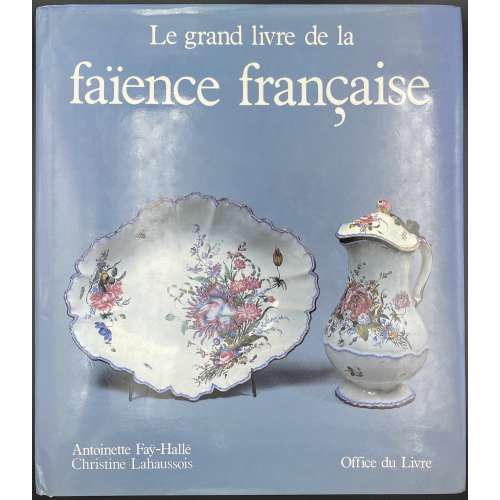 Title: Antoinette Faÿ-Hallé • Christine Lahaussois | Le grand livre de la | faïence française | Office du livre || Dedication (to imprint): A Jeanne Giacomotti (author of French Faience, Oldbourne Press, London, 1963) Pagination: [1-6] 7-242 [2], 300 illustrations, incl. 150 in colour. Binding: 29 x 25.5 cm, grey paper, blind-stamped to front cover, white lettering to spine, pictorial dust jacket. Contributors: Antoinette Faÿ- Hallé (French, 20th century) – Chargée du Musée national de céramique de Sèvres Christine Lahaussois (French, 20th century) – Chargée de conservation, Musée national de céramique, Sèvres
Title: Antoinette Faÿ-Hallé • Christine Lahaussois | Le grand livre de la | faïence française | Office du livre || Dedication (to imprint): A Jeanne Giacomotti (author of French Faience, Oldbourne Press, London, 1963) Pagination: [1-6] 7-242 [2], 300 illustrations, incl. 150 in colour. Binding: 29 x 25.5 cm, grey paper, blind-stamped to front cover, white lettering to spine, pictorial dust jacket. Contributors: Antoinette Faÿ- Hallé (French, 20th century) – Chargée du Musée national de céramique de Sèvres Christine Lahaussois (French, 20th century) – Chargée de conservation, Musée national de céramique, Sèvres -
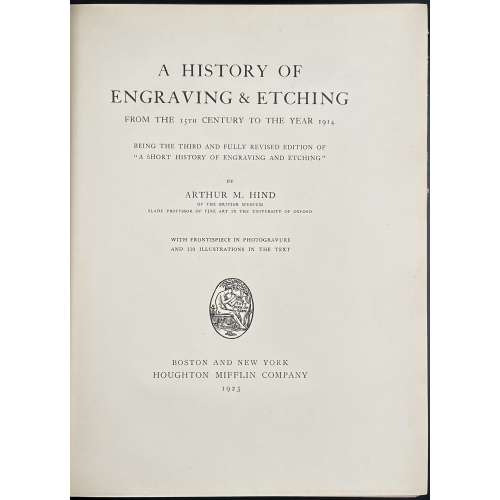 Title: A HISTORY OF | ENGRAVING & ETCHING | FROM THE 15TH CENTURY TO THE YEAR 1914 | BEING THE THIRD AND FULLY REVISED EDITION OF | “A SHORT HISTORY OF ENGRAVING AND ETCHING” | BY | ARTHUR M. HIND | OF THE BRITISH MUSEUM | SLADE PROFESSOR OF FINE ART IN THE UNIVERSITY OF OXFORD | WITH FRONTISPIECE IN PHOTOGRAVURE | AND 110 ILLUSTRATIONS IN THE TEXT | {publisher’s device} | BOSTON AND NEW YORK | HOUGHTON MIFFLIN COMPANY | 1923 || Pagination: [i-iv] v-xiii. [2] – blank / abbrev., [2] 3-487 [488], frontis. w/tissue guard, ills.; Appendices: I. Classified list of engravers (p. 343-392); II. General bibliography (p. 393-419); III. Index of engravers and individual bibliography (p. 420-487). Collation: π10 B-2H8 2I4, frontispiece (extr.), 110 in-text illustrations. Binding: 25.8 x 20 cm, crimson cloth, blind triple-fillet to top and bottom of the front board, same in gilt to spine, gilt lettering to spine, top edge gilt, fore-edge untrimmed. Contributors: Arthur Mayger Hind (British, 1880 – 1957) – author. Houghton Mifflin Company (Boston, 1864) – publisher. R & R. Clark, Ltd. (Edinburgh, 1846) – printer. Note: It is marked as the 3rd edition of A short history of engraving and etching. Indeed, A short history of engraving & etching for the use of collectors and students with full bibliography, classified list and index of engravers was published by Constable in London and Houghton Mifflin Co. in Boston, in 1908 and then in 1911. However, it is hard to consider an almost completely new book "a 3rd edition".
Title: A HISTORY OF | ENGRAVING & ETCHING | FROM THE 15TH CENTURY TO THE YEAR 1914 | BEING THE THIRD AND FULLY REVISED EDITION OF | “A SHORT HISTORY OF ENGRAVING AND ETCHING” | BY | ARTHUR M. HIND | OF THE BRITISH MUSEUM | SLADE PROFESSOR OF FINE ART IN THE UNIVERSITY OF OXFORD | WITH FRONTISPIECE IN PHOTOGRAVURE | AND 110 ILLUSTRATIONS IN THE TEXT | {publisher’s device} | BOSTON AND NEW YORK | HOUGHTON MIFFLIN COMPANY | 1923 || Pagination: [i-iv] v-xiii. [2] – blank / abbrev., [2] 3-487 [488], frontis. w/tissue guard, ills.; Appendices: I. Classified list of engravers (p. 343-392); II. General bibliography (p. 393-419); III. Index of engravers and individual bibliography (p. 420-487). Collation: π10 B-2H8 2I4, frontispiece (extr.), 110 in-text illustrations. Binding: 25.8 x 20 cm, crimson cloth, blind triple-fillet to top and bottom of the front board, same in gilt to spine, gilt lettering to spine, top edge gilt, fore-edge untrimmed. Contributors: Arthur Mayger Hind (British, 1880 – 1957) – author. Houghton Mifflin Company (Boston, 1864) – publisher. R & R. Clark, Ltd. (Edinburgh, 1846) – printer. Note: It is marked as the 3rd edition of A short history of engraving and etching. Indeed, A short history of engraving & etching for the use of collectors and students with full bibliography, classified list and index of engravers was published by Constable in London and Houghton Mifflin Co. in Boston, in 1908 and then in 1911. However, it is hard to consider an almost completely new book "a 3rd edition". -
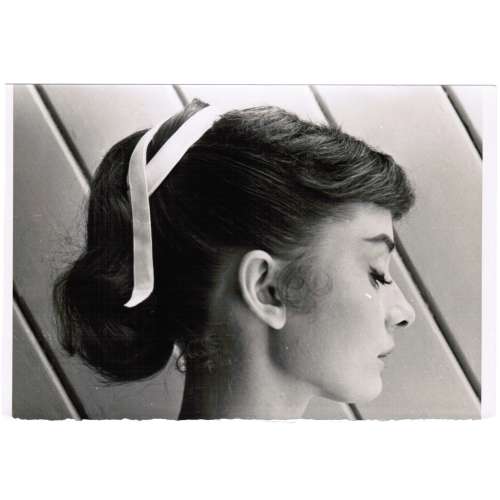 Audrey Hepburn [Audrey Kathleen Ruston] (British, 1929 – 1993) black and white head-shot in profile to right, pre-production photo testing hairstyle. "War and Peace", a 1956 epic historical drama film based on Leo Tolstoy's 1869 novel of the same name. Stamp on verso: Blue ink, in oval, "AUDREY | HEPBURN | The Personal Collection Part III | May 2018 | CHRISTIE'S || Size: 12.0 x 17.5 cm sheet; 12.0 x 16.7 cm image. Condition: small abrasion to cheek and rough lower edge. Certificate of authenticity from John Reznikoff, University Archives.
Audrey Hepburn [Audrey Kathleen Ruston] (British, 1929 – 1993) black and white head-shot in profile to right, pre-production photo testing hairstyle. "War and Peace", a 1956 epic historical drama film based on Leo Tolstoy's 1869 novel of the same name. Stamp on verso: Blue ink, in oval, "AUDREY | HEPBURN | The Personal Collection Part III | May 2018 | CHRISTIE'S || Size: 12.0 x 17.5 cm sheet; 12.0 x 16.7 cm image. Condition: small abrasion to cheek and rough lower edge. Certificate of authenticity from John Reznikoff, University Archives. -
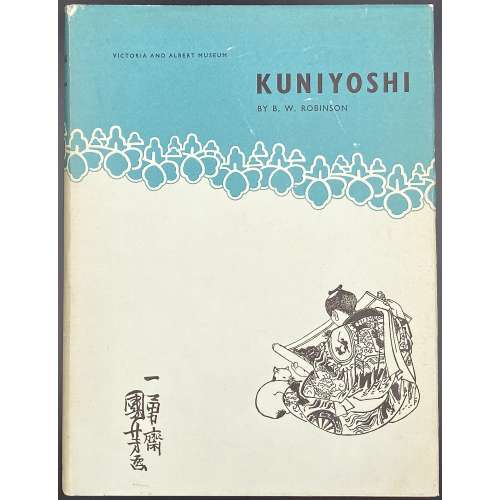 Title-page: VICTORIA AND ALBERT MUSEUM | KUNIYOSHI | BY B. W. ROBINSON | SPACE | LONDON: HER MAJESTY'S STATIONERY OFFICE | 1961 || Description: hardcover, 25.3 x 19 cm, bound in red cloth with embossed vignette to front cover and gilt lettering over the black label to spine, pictorial endpapers, pictorial olive/cyan dust jacket; pp. [i-vi] vii-xv [xvi blank] 1-71 [72 blank] plus frontispiece in colour and 50 leaves of plates (98 pages of b/w ils.) between pp. 64 and 65. Contributor: Robinson, Basil William (British, 1912 – 2005).
Title-page: VICTORIA AND ALBERT MUSEUM | KUNIYOSHI | BY B. W. ROBINSON | SPACE | LONDON: HER MAJESTY'S STATIONERY OFFICE | 1961 || Description: hardcover, 25.3 x 19 cm, bound in red cloth with embossed vignette to front cover and gilt lettering over the black label to spine, pictorial endpapers, pictorial olive/cyan dust jacket; pp. [i-vi] vii-xv [xvi blank] 1-71 [72 blank] plus frontispiece in colour and 50 leaves of plates (98 pages of b/w ils.) between pp. 64 and 65. Contributor: Robinson, Basil William (British, 1912 – 2005). -
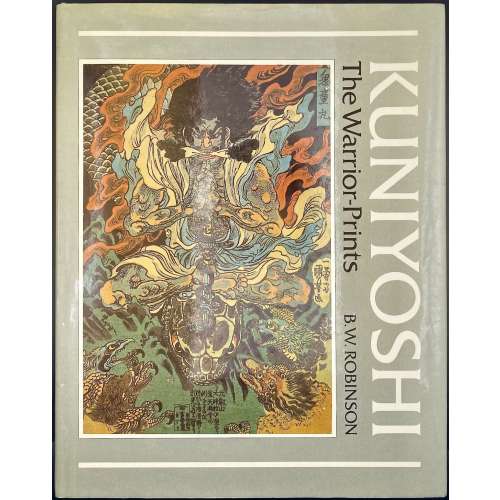 Title-page: KUNIYOSHI | The Warrior-Prints | B. W. Robinson | [space] | PHAIDON | OXFORD || Description: hardcover, 31.7 x 25 cm, bound in olive green cloth with gilt lettering to spine, white endpapers, pictorial olive dust jacket; pp.: [1-6] 7-208 incl. frontispiece, 64 plates, and 30 figs. in the text (total 104 leaves, 205 illustrations, including 32 in colour); catalogue with the list of illustrations, and index of characters portrayed. Inset: A.L.s. on Phaidon letterhead by Sue Moulton; ISBN 0714822272. Edition: 1st edition,1st printing (a review copy). Contributor: Robinson, Basil William (British, 1912 – 2005).
Title-page: KUNIYOSHI | The Warrior-Prints | B. W. Robinson | [space] | PHAIDON | OXFORD || Description: hardcover, 31.7 x 25 cm, bound in olive green cloth with gilt lettering to spine, white endpapers, pictorial olive dust jacket; pp.: [1-6] 7-208 incl. frontispiece, 64 plates, and 30 figs. in the text (total 104 leaves, 205 illustrations, including 32 in colour); catalogue with the list of illustrations, and index of characters portrayed. Inset: A.L.s. on Phaidon letterhead by Sue Moulton; ISBN 0714822272. Edition: 1st edition,1st printing (a review copy). Contributor: Robinson, Basil William (British, 1912 – 2005). -
 An album 45 of 50 prints, 31 photogravures and 14 in raster chromotype after drawings and paintings by Franz von Bayros; most with tissue guards, some in passepartout; colour prints mounted on the same paper that is used for photogravures. Title-page: BAYROS | MAPPE | MIT VORWORT VON | RUDOLF HANS BARTSCH | VERLAG ED. STRACHE / WIEN • PRAG • LEIPZIG || Limited edition of 500 copies. This is copy № 286. Lacking 5 prints: (1) Abschied vom Paradies, (2) Weihnacht, and (3) Harmonie from Symphonie von der Gūte, die Schönheit ist; (4) Divina commedia from Florentiner Phantasien; and (5) Mozart from Varia. Contributors: Franz von Bayros (Austrian, 1866 – 1924) Rudolf Hans Bartsch (Austrian, 1873 – 1952)
An album 45 of 50 prints, 31 photogravures and 14 in raster chromotype after drawings and paintings by Franz von Bayros; most with tissue guards, some in passepartout; colour prints mounted on the same paper that is used for photogravures. Title-page: BAYROS | MAPPE | MIT VORWORT VON | RUDOLF HANS BARTSCH | VERLAG ED. STRACHE / WIEN • PRAG • LEIPZIG || Limited edition of 500 copies. This is copy № 286. Lacking 5 prints: (1) Abschied vom Paradies, (2) Weihnacht, and (3) Harmonie from Symphonie von der Gūte, die Schönheit ist; (4) Divina commedia from Florentiner Phantasien; and (5) Mozart from Varia. Contributors: Franz von Bayros (Austrian, 1866 – 1924) Rudolf Hans Bartsch (Austrian, 1873 – 1952) -
 Paperback reprint on demand, 28 x 22 cm, in green malachite wrappers with yellow lettering to both covers; pp. [i-ii] iii-v[vi] 1-122 [4]. Title-page: Okhrana | The Paris Operations of | the Russian Imperial Police | Ben B. Fischer | History Staff | Center for the Study | of Intelligence | Central Intelligence Agency | 1997 || ISBN-10: 1907521992 Benjamin B. Fischer Contents. Foreword. Preface. Okhrana: The Paris Operations of the Russian Imperial Police. From Paris to Palo Alto. CIA Interest in the Okhrana Files. Origins of the Okhrana and Its Paris Office. Foreign Operations. Change and Continuity Dramatis Personae Conclusions Rita T. Kronenbitter Paris Okhrana 1885-1905. The Illustrious Career of Arkadiy Harting. The Sherlock Holmes of the Revolution. Okhrana Agent Dolin. The Okhrana's Female Agents: Part I: Russian Women. The Okhrana's Female Agents: Part II: Indigenous Recruits. Review of Edward Ellis Smith, The Young Stalin, by Harry Gelman. Commentary by Rita T. Kronenbitter.
Paperback reprint on demand, 28 x 22 cm, in green malachite wrappers with yellow lettering to both covers; pp. [i-ii] iii-v[vi] 1-122 [4]. Title-page: Okhrana | The Paris Operations of | the Russian Imperial Police | Ben B. Fischer | History Staff | Center for the Study | of Intelligence | Central Intelligence Agency | 1997 || ISBN-10: 1907521992 Benjamin B. Fischer Contents. Foreword. Preface. Okhrana: The Paris Operations of the Russian Imperial Police. From Paris to Palo Alto. CIA Interest in the Okhrana Files. Origins of the Okhrana and Its Paris Office. Foreign Operations. Change and Continuity Dramatis Personae Conclusions Rita T. Kronenbitter Paris Okhrana 1885-1905. The Illustrious Career of Arkadiy Harting. The Sherlock Holmes of the Revolution. Okhrana Agent Dolin. The Okhrana's Female Agents: Part I: Russian Women. The Okhrana's Female Agents: Part II: Indigenous Recruits. Review of Edward Ellis Smith, The Young Stalin, by Harry Gelman. Commentary by Rita T. Kronenbitter. -

Bertrand Russell. A history of western philosophy. A Touchstone Book. Published by Symon & Schuster, 2007. [Reprint 1945].
ISBN-10: 1-4165-5477-7
ISBN-13: 978-4165-5477-6.
-
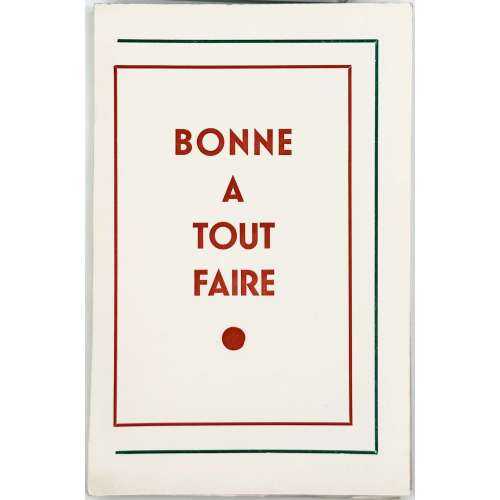 A softcover volume 18.7 x 12.1 cm, in publisher’s cream wrappers, red lettering in red and green frames to front cover, in glassine dustwrapper, uncut, untrimmed, collated in 8vo: 1-98 104, pp. [1-8] 9-151 [152 blank], plus 6 illustrations reproduced in drypoint after Mario Tauzin's lithographs from the album 'Interdit aux adultes' (see SVE-0547.2024). Front cover : BONNE | A | TOUT | FAIRE Title-page : BONNE | A | TOUT | FAIRE Stated limited edition of 900, strictly for subscribers. According to J.-P. Dutel III 1108 (p.66): published by Éric Losfeld in the late 1950s. Bonne à tout faire is a French idiom = maid-of-all-work Éric Losfeld (Belgian-French, 1922 – 1979) — publisher Mario Tauzin (French, 1909 – 1979) — artist
A softcover volume 18.7 x 12.1 cm, in publisher’s cream wrappers, red lettering in red and green frames to front cover, in glassine dustwrapper, uncut, untrimmed, collated in 8vo: 1-98 104, pp. [1-8] 9-151 [152 blank], plus 6 illustrations reproduced in drypoint after Mario Tauzin's lithographs from the album 'Interdit aux adultes' (see SVE-0547.2024). Front cover : BONNE | A | TOUT | FAIRE Title-page : BONNE | A | TOUT | FAIRE Stated limited edition of 900, strictly for subscribers. According to J.-P. Dutel III 1108 (p.66): published by Éric Losfeld in the late 1950s. Bonne à tout faire is a French idiom = maid-of-all-work Éric Losfeld (Belgian-French, 1922 – 1979) — publisher Mario Tauzin (French, 1909 – 1979) — artist -
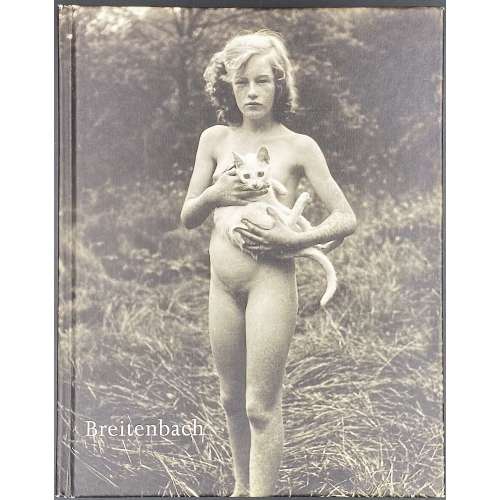 A pictorial photographic album, 19.5 x 15.3 cm, hardcover, paper pictorial covers, pictorial endpapers, pp. [2] 3-39 [40]; total 20 leaves; text by Susan Jacobasch, photographs by Josef Breitenbach. Published in connection with the exhibition "Josef Breitenbach" on October, 10 – November 28, 1998, at Galerie Bodo Niemann in Berlin. Josef Breitenbach (Jewish-German-American, 1896 – 1984).
A pictorial photographic album, 19.5 x 15.3 cm, hardcover, paper pictorial covers, pictorial endpapers, pp. [2] 3-39 [40]; total 20 leaves; text by Susan Jacobasch, photographs by Josef Breitenbach. Published in connection with the exhibition "Josef Breitenbach" on October, 10 – November 28, 1998, at Galerie Bodo Niemann in Berlin. Josef Breitenbach (Jewish-German-American, 1896 – 1984). -
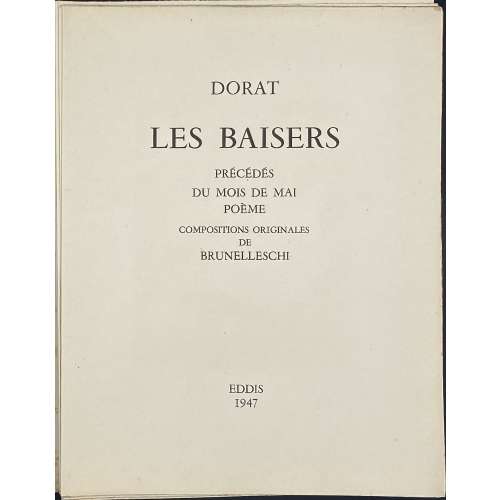 Title-page: DORAT | LES BAISERS | PRÉCÉDÉS | DU MOIS DE MAI | POÈME | COMPOSITIONS ORIGINALES | DE | BRUNELLESCHI | EDDIS | 1947 || Description: 23.3 x 19 cm, French slapped wrappers, sunned and heavy foxed, without a slipcase; [1-6] (h.t. with owner’s inscription / limitation with № 18, t.p., d.t.p.), 7-137 [138] [6] (colophon) plus 23 stencil-coloured (au pochoir) photogravure plates after Umberto Brunelleschi, his head- and tailpieces (total 60 designs). Printed by Gaston Maillet & Cie in Saint-Ouen on April 15, 1947. Photogravure by Deberni and Peignot under direction of R. Perrot. Limitation: 3,000 copies numbered 1 to 3,000 of which 500 copies on Vélin de Luxe (1–500) enriched with two suites of plates, one in colour and one toned, before letters; 2,500 on Vélin de Fabrication Spéciale of which copies numbered 500–1,000 enriched with one suite before letters, and 2,000 copies numbered 1,001–3,000. Besides, there are 200 additional copies numbered with Roman numbers reserved for foreign bibliophiles. This particular copy bears number 18, however, I don’t think it is printed on Vélin de Luxe, whatever it is, and does not have an extra suite of plates. Owner’s inscription pasted to h.t.: A Denise ce livre audacieux | mais qui par son art sait | tout faire pardonner — | Jane Darboy. Provenance: Jane Darboy (French, fl. 1932 – 1948) – a French writer.
Title-page: DORAT | LES BAISERS | PRÉCÉDÉS | DU MOIS DE MAI | POÈME | COMPOSITIONS ORIGINALES | DE | BRUNELLESCHI | EDDIS | 1947 || Description: 23.3 x 19 cm, French slapped wrappers, sunned and heavy foxed, without a slipcase; [1-6] (h.t. with owner’s inscription / limitation with № 18, t.p., d.t.p.), 7-137 [138] [6] (colophon) plus 23 stencil-coloured (au pochoir) photogravure plates after Umberto Brunelleschi, his head- and tailpieces (total 60 designs). Printed by Gaston Maillet & Cie in Saint-Ouen on April 15, 1947. Photogravure by Deberni and Peignot under direction of R. Perrot. Limitation: 3,000 copies numbered 1 to 3,000 of which 500 copies on Vélin de Luxe (1–500) enriched with two suites of plates, one in colour and one toned, before letters; 2,500 on Vélin de Fabrication Spéciale of which copies numbered 500–1,000 enriched with one suite before letters, and 2,000 copies numbered 1,001–3,000. Besides, there are 200 additional copies numbered with Roman numbers reserved for foreign bibliophiles. This particular copy bears number 18, however, I don’t think it is printed on Vélin de Luxe, whatever it is, and does not have an extra suite of plates. Owner’s inscription pasted to h.t.: A Denise ce livre audacieux | mais qui par son art sait | tout faire pardonner — | Jane Darboy. Provenance: Jane Darboy (French, fl. 1932 – 1948) – a French writer. -
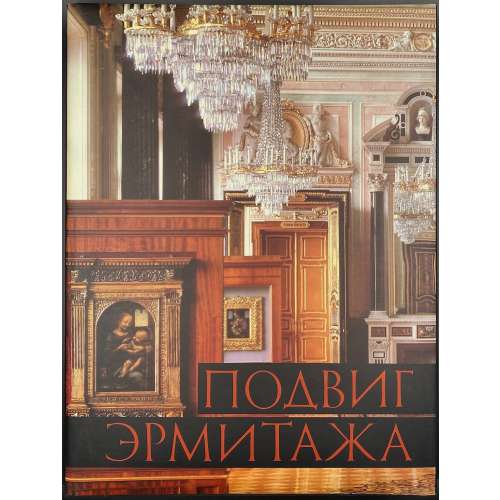 Title-page (in red on pictorial background): ПОДВИГ | ЭРМИТАЖА | ИЗДАТЕЛЬСТВО «АВРОРА» • ЛЕНИНГРАД || Illustrated album in hardcover, 33 x 25 cm, bound in black cloth with gilt and red to front cover and spine, brown endpapers, pictorial dust jacket; pp.: [1-6] 7-273 [274] [30], total 304 pages with 388 b/w and colour illustrations. Text: Sergei Petrovich Varshavsky [Сергей Петрович Варшавский] (Jewish-Russian, 1906 – 1980); B. Rest [Б. Рест; Юлий Исаакович Шапиро] (Jewish-Russian, fl. 1940 – 1980). Preface: Boris Piotrovsky [Борис Борисович Пиотровский] (Russian, 1908 – 1990). Layout by Liubov Rakhmilevich [Л. Рахмилевич]. Photography by Viktor Savik [В. Савик] and Leonid Bogdanov [Л. Богданов]. Design by Valery Ivanov [В. Иванов]. Russian twin edition to [LIB-3043.2022] S. Varshavsky, B. Rest. Saved for humanity: the Hermitage during the siege of Leningrad, 1941-1944. — Leningrad: Aurora Art Publishers, 1985 and [LIB-3042.2022] The ordeal of the Hermitage: The siege of Leningrad, 1941-1944 — Leningrad: Aurora Art Publishers, New York: Harry N. Abrams, Inc., 1985. The text extracted from [LIB-3035.2022] С. Варшавский, Б. Рест. Подвиг Эрмитажа: Государственный Эрмитаж в годы Великой отечественной войны. — М.-Л.: Советский художник, 1965.
Title-page (in red on pictorial background): ПОДВИГ | ЭРМИТАЖА | ИЗДАТЕЛЬСТВО «АВРОРА» • ЛЕНИНГРАД || Illustrated album in hardcover, 33 x 25 cm, bound in black cloth with gilt and red to front cover and spine, brown endpapers, pictorial dust jacket; pp.: [1-6] 7-273 [274] [30], total 304 pages with 388 b/w and colour illustrations. Text: Sergei Petrovich Varshavsky [Сергей Петрович Варшавский] (Jewish-Russian, 1906 – 1980); B. Rest [Б. Рест; Юлий Исаакович Шапиро] (Jewish-Russian, fl. 1940 – 1980). Preface: Boris Piotrovsky [Борис Борисович Пиотровский] (Russian, 1908 – 1990). Layout by Liubov Rakhmilevich [Л. Рахмилевич]. Photography by Viktor Savik [В. Савик] and Leonid Bogdanov [Л. Богданов]. Design by Valery Ivanov [В. Иванов]. Russian twin edition to [LIB-3043.2022] S. Varshavsky, B. Rest. Saved for humanity: the Hermitage during the siege of Leningrad, 1941-1944. — Leningrad: Aurora Art Publishers, 1985 and [LIB-3042.2022] The ordeal of the Hermitage: The siege of Leningrad, 1941-1944 — Leningrad: Aurora Art Publishers, New York: Harry N. Abrams, Inc., 1985. The text extracted from [LIB-3035.2022] С. Варшавский, Б. Рест. Подвиг Эрмитажа: Государственный Эрмитаж в годы Великой отечественной войны. — М.-Л.: Советский художник, 1965. -
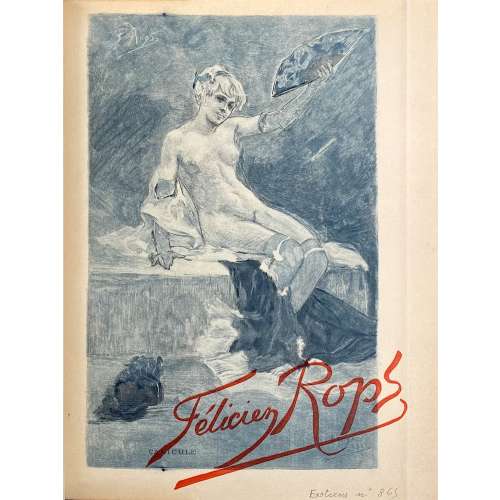 One volume in-4o, 26.5 x 21 x 4 cm, bound by Durvand (signed) in tan quarter morocco over marbled boards, spine with raised bands and gilt lettering, top margin gilt, marbled endpapers, publisher’s wrappers preserved; enriched with 39 original prints after Félicien Rops. Collation: 2 blanks, π5 (original front wrapper ‘Canicule’/blank, 2 blanks, h.t./justification, t.p/blank), 1-294 301 (paginated 1-233 [234]) χ1 (advert.) plus frontispiece (photographic seated portrait of Félicien Rops, collotype, artist unknown) and 39 leaves of bound-in original prints by various printers on different papers, with tissue guards; back wrapper and original spine, 2 blanks; loosely inset a marriage invitation for Dr Robert Fasquelle and Mlle Suzanne Luneau with a partial list of prints, incl. page numbers. Title-page (red and black): Études sur quelques Artistes originaux | — | FÉLICIEN ROPS | par | CAMILLE LEMONNIER | {fleuron} | PARIS | H. FLOURY, ÉDITEUR | 1, Boulevard des Capucines, 1 | – | 1908 || Limitation: 125 copies with two original plates «Canicule» and «Seule» numbered 1-125, of which 100 copies on Japon à la forme, 25 copies on papier de Chine; plus 50 copies on papier vélin with one coloured plate «Canicule», numbered 126-175, printed by Edmond Deman in Brussels. Our copy is on dense wove paper (vélin), without a number. Photographs here represent the original prints only. Camille Lemonnier (Belgian, 1844 – 1913) – author. Félicien Rops (Belgian, 1833 – 1898) – artist. Henri Floury (French, 1862 –1961) – publisher. Edmond Deman (Belgian, 1857–1918) – printer. Lucien Durvand (French, 1852 – 1924) – bookbinder.
One volume in-4o, 26.5 x 21 x 4 cm, bound by Durvand (signed) in tan quarter morocco over marbled boards, spine with raised bands and gilt lettering, top margin gilt, marbled endpapers, publisher’s wrappers preserved; enriched with 39 original prints after Félicien Rops. Collation: 2 blanks, π5 (original front wrapper ‘Canicule’/blank, 2 blanks, h.t./justification, t.p/blank), 1-294 301 (paginated 1-233 [234]) χ1 (advert.) plus frontispiece (photographic seated portrait of Félicien Rops, collotype, artist unknown) and 39 leaves of bound-in original prints by various printers on different papers, with tissue guards; back wrapper and original spine, 2 blanks; loosely inset a marriage invitation for Dr Robert Fasquelle and Mlle Suzanne Luneau with a partial list of prints, incl. page numbers. Title-page (red and black): Études sur quelques Artistes originaux | — | FÉLICIEN ROPS | par | CAMILLE LEMONNIER | {fleuron} | PARIS | H. FLOURY, ÉDITEUR | 1, Boulevard des Capucines, 1 | – | 1908 || Limitation: 125 copies with two original plates «Canicule» and «Seule» numbered 1-125, of which 100 copies on Japon à la forme, 25 copies on papier de Chine; plus 50 copies on papier vélin with one coloured plate «Canicule», numbered 126-175, printed by Edmond Deman in Brussels. Our copy is on dense wove paper (vélin), without a number. Photographs here represent the original prints only. Camille Lemonnier (Belgian, 1844 – 1913) – author. Félicien Rops (Belgian, 1833 – 1898) – artist. Henri Floury (French, 1862 –1961) – publisher. Edmond Deman (Belgian, 1857–1918) – printer. Lucien Durvand (French, 1852 – 1924) – bookbinder. -
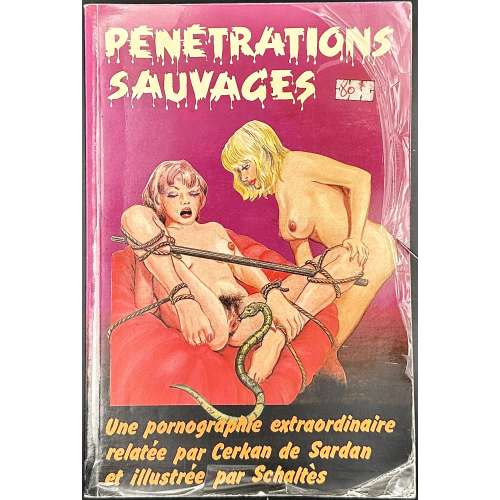 NEWPaperback, 240 x 160 mm, pp. [1-5] 6-156 [4], with black and white illustrations, pictorial front cover: PENETRATIONS SAUVAGES | {vignette} | Une pornographie extraordinaire | relatée par Cerkan de Sardan | et illustrée par Schaltès ||
NEWPaperback, 240 x 160 mm, pp. [1-5] 6-156 [4], with black and white illustrations, pictorial front cover: PENETRATIONS SAUVAGES | {vignette} | Une pornographie extraordinaire | relatée par Cerkan de Sardan | et illustrée par Schaltès || -
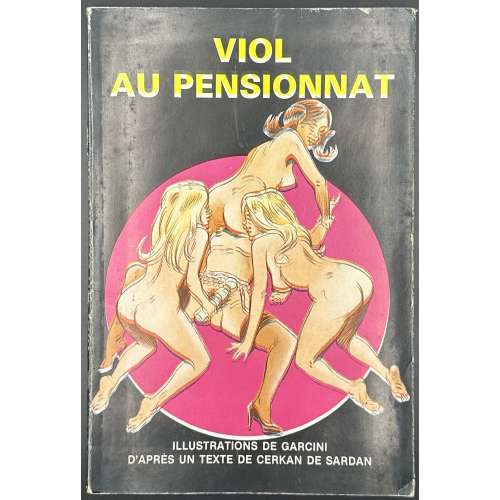 NEWSoftcover, French flapped pictorial wrappers, 240 x 160 mm, translated title: Rape at the boarding school, pp. [1-6] 7-164 [4], 40 black and white illustrations by Garcini. Title-page: D’après un texte de | CERKAN DE SARDAN | VIOL | AU PENSIONNAT | illustrations de | GARCINI ||
NEWSoftcover, French flapped pictorial wrappers, 240 x 160 mm, translated title: Rape at the boarding school, pp. [1-6] 7-164 [4], 40 black and white illustrations by Garcini. Title-page: D’après un texte de | CERKAN DE SARDAN | VIOL | AU PENSIONNAT | illustrations de | GARCINI || -
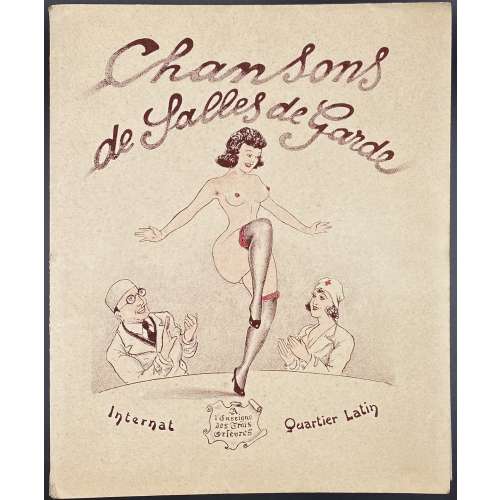 Title: Chansons | de Salles de Garde | {vignette} | Internat { À l’Enseigne des Trois Orfèvres } Quartier Latin || Collation: 21 leaves folded in half (84 pages), unpaginated, unbound, plus 40 plates (two-tone lithography) for 40 songs, in a flapped paper folder, in a green cardstock folder (slipcase without top and bottom?) with gilt diaper ornament. Text, music score, and drawings printed in brick red. Size: 28 x 22.5 cm. Edition: limited to 700 copies of which 100 (№ 1-100) on Vélin Arches, 650 (№ 101-650) on Vélin Spécial, and 50 without numbering marked “Exemplaire d’interne” on Vélin Supérieur. This copy is № 27. Catalogue raisonné: Dutel 1920 – 1970: 1192.
Title: Chansons | de Salles de Garde | {vignette} | Internat { À l’Enseigne des Trois Orfèvres } Quartier Latin || Collation: 21 leaves folded in half (84 pages), unpaginated, unbound, plus 40 plates (two-tone lithography) for 40 songs, in a flapped paper folder, in a green cardstock folder (slipcase without top and bottom?) with gilt diaper ornament. Text, music score, and drawings printed in brick red. Size: 28 x 22.5 cm. Edition: limited to 700 copies of which 100 (№ 1-100) on Vélin Arches, 650 (№ 101-650) on Vélin Spécial, and 50 without numbering marked “Exemplaire d’interne” on Vélin Supérieur. This copy is № 27. Catalogue raisonné: Dutel 1920 – 1970: 1192. -
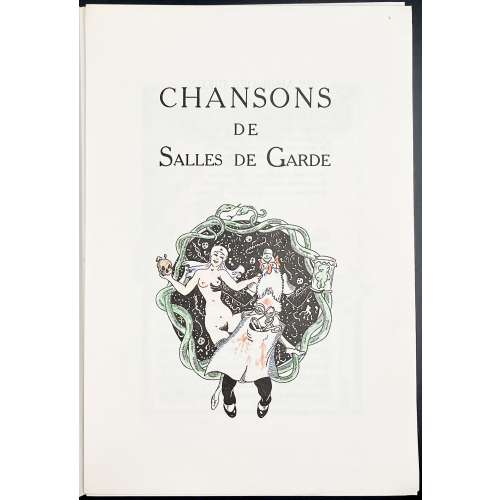 Title-page: CHANSONS | DE | SALLES DE GARDE | {vignette} || Description: 27.5 x 18.5 cm, in pictorial French flapped wrapper and in a green cloth folder, vertically lettered to spine “CHANSONS” in black letters, a flute benith. Pagination: [1-3] 4-140 [4] plus 52 plates extraneous to collation (Dutel provides for 142 pp.) Illustrations: plates, headbands, vignettes to front wrapper, title-page and limitation page, as well as the vignette at the end, reproduced after drawings by Morvan (according to J.-P. Dutel) and hand-coloured with crayons (the question remains, is it Hervé Morvan, French, 1917 – 1980?) Limitation: 950 copies of which 25 marked A to Z; 25 copies consist of an additional suite and one original drawing (№ 1-25); 25 copies have an original drawing (№ 26-50), and 875 copies numbered 51 to 950. This copy is № 697. Catalogue raisonné: Dutel (1920-1970): № 1186.
Title-page: CHANSONS | DE | SALLES DE GARDE | {vignette} || Description: 27.5 x 18.5 cm, in pictorial French flapped wrapper and in a green cloth folder, vertically lettered to spine “CHANSONS” in black letters, a flute benith. Pagination: [1-3] 4-140 [4] plus 52 plates extraneous to collation (Dutel provides for 142 pp.) Illustrations: plates, headbands, vignettes to front wrapper, title-page and limitation page, as well as the vignette at the end, reproduced after drawings by Morvan (according to J.-P. Dutel) and hand-coloured with crayons (the question remains, is it Hervé Morvan, French, 1917 – 1980?) Limitation: 950 copies of which 25 marked A to Z; 25 copies consist of an additional suite and one original drawing (№ 1-25); 25 copies have an original drawing (№ 26-50), and 875 copies numbered 51 to 950. This copy is № 697. Catalogue raisonné: Dutel (1920-1970): № 1186. -
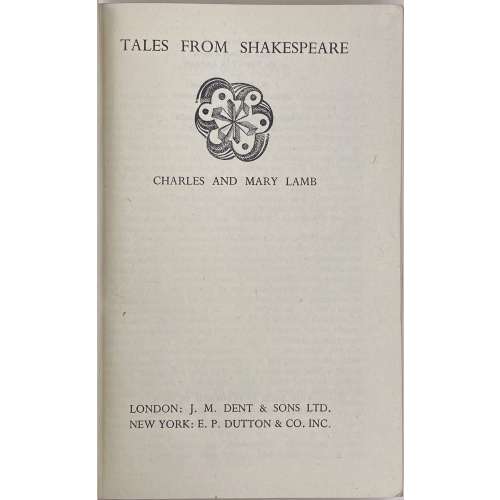 Description: 17.4 x 11 cm, blue publisher’s cloth, blind device to front board, gilt lettering to spine, no DJ, pink abstract diaper endpapers, owner’s ink inscription to ffep, dated June 28, 1945. Serial t.p.: Everyman, I will go with thee, and be thy guide, | In thy most need to go by the side. | — | EVERYMAN'S LIBRARY | EDITED BY ERNEST RHYS | No. 8 | FOR YOUNG PEOPLE | TALES FROM SHAKESPEARE | BY CHARLES AND MARY LAMB | ILLUSTRATIONS BY ARTHUR | RACKHAM || Title-page: TALES FROM SHAKESPEARE | {device} | CHARLES AND MARY LAMB | LONDON: J. M. DENT & SONS LTD. | NEW YORK: E. P. DUTTON & CO. INC. || T.p verso: All rights reserved | Made in Great Britain | at The Temple Press Letchworth | for | J. M. Dent & Sons Ltd. | Aldine House Bedford St. London | First published 1807 | First published in this edition 1906 | Last reprint (reset) 1944 | [blank] | THIS BOOK IS PRODUCED IN COM- | PLETE CONFORMITY WITH THE | AUTHORIZED ECONOMY STANDARDS || Collation: 16mo; [A]-K16; total 160 leaves, 9 full-page illustrations after Arthur Rackham, within collation (text on the other side). Pagination: [i-iv] v-viii, 1-312, total 320 pages, ils. Contributors: William Shakespeare (English, 1564 – 1616) Mary Ann Lamb (British, 1764 – 1847) – author. Charles Lamb (British, 1775 – 1834) – author. Ernest Percival Rhys (British, 1859 – 1946) – editor. Arthur Rackham (British, 1867 – 1939) – artist.
Description: 17.4 x 11 cm, blue publisher’s cloth, blind device to front board, gilt lettering to spine, no DJ, pink abstract diaper endpapers, owner’s ink inscription to ffep, dated June 28, 1945. Serial t.p.: Everyman, I will go with thee, and be thy guide, | In thy most need to go by the side. | — | EVERYMAN'S LIBRARY | EDITED BY ERNEST RHYS | No. 8 | FOR YOUNG PEOPLE | TALES FROM SHAKESPEARE | BY CHARLES AND MARY LAMB | ILLUSTRATIONS BY ARTHUR | RACKHAM || Title-page: TALES FROM SHAKESPEARE | {device} | CHARLES AND MARY LAMB | LONDON: J. M. DENT & SONS LTD. | NEW YORK: E. P. DUTTON & CO. INC. || T.p verso: All rights reserved | Made in Great Britain | at The Temple Press Letchworth | for | J. M. Dent & Sons Ltd. | Aldine House Bedford St. London | First published 1807 | First published in this edition 1906 | Last reprint (reset) 1944 | [blank] | THIS BOOK IS PRODUCED IN COM- | PLETE CONFORMITY WITH THE | AUTHORIZED ECONOMY STANDARDS || Collation: 16mo; [A]-K16; total 160 leaves, 9 full-page illustrations after Arthur Rackham, within collation (text on the other side). Pagination: [i-iv] v-viii, 1-312, total 320 pages, ils. Contributors: William Shakespeare (English, 1564 – 1616) Mary Ann Lamb (British, 1764 – 1847) – author. Charles Lamb (British, 1775 – 1834) – author. Ernest Percival Rhys (British, 1859 – 1946) – editor. Arthur Rackham (British, 1867 – 1939) – artist.Temple Press, Letchworth, England – printer.
Joseph Malaby Dent (British, 1849 – 1926) – publisher. Note: “On the writing desk were two books – identical copies of Lamb’s Tales From Shakespeare. […] — Why did you choose Lamb? — It was the only book I could find in duplicate except Uncle Tom’s Cabin…” Graham Greene. Our Man in Havana. -
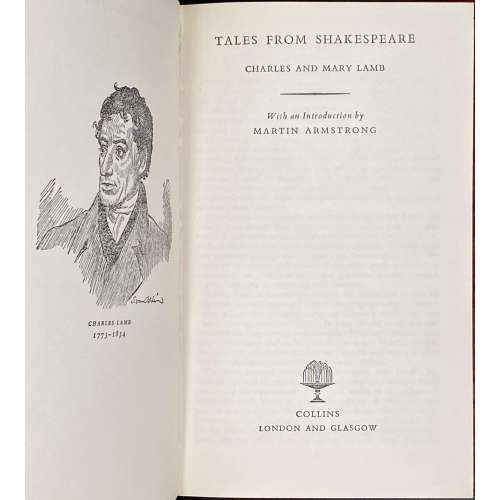 Title-page: TALES FROM SHAKESPEARE | CHARLES AND MARY LAMB | — | With an Introduction by | MARTIN ARMSTRONG | {space} | {publisher’s device} | COLLINS | LONDON AND GLASGOW || Pagination: [1-4] 5-256, frontispiece: reproduction of portrait of Charles Lamb. Edition: reprint of 1953 edition (WorldCat); in Collins Classics series. Binding: 18.5 x 11 cm, semi-soft, crimson faux morocco, blind-stamped fillet border, gilt lettering to spine, TEG, slipcase. Contributors: William Shakespeare (English, 1564 – 1616) Mary Ann Lamb (British, 1764 – 1847) – author. Charles Lamb (British, 1775 – 1834) – author. Collins Clear-Type Press & Publisher (London; Glasgow) – printer and publisher. Note: “On the writing desk were two books – identical copies of Lamb’s Tales From Shakespeare. […] — Why did you choose Lamb? — It was the only book I could find in duplicate except Uncle Tom’s Cabin…” Graham Greene. Our Man in Havana.
Title-page: TALES FROM SHAKESPEARE | CHARLES AND MARY LAMB | — | With an Introduction by | MARTIN ARMSTRONG | {space} | {publisher’s device} | COLLINS | LONDON AND GLASGOW || Pagination: [1-4] 5-256, frontispiece: reproduction of portrait of Charles Lamb. Edition: reprint of 1953 edition (WorldCat); in Collins Classics series. Binding: 18.5 x 11 cm, semi-soft, crimson faux morocco, blind-stamped fillet border, gilt lettering to spine, TEG, slipcase. Contributors: William Shakespeare (English, 1564 – 1616) Mary Ann Lamb (British, 1764 – 1847) – author. Charles Lamb (British, 1775 – 1834) – author. Collins Clear-Type Press & Publisher (London; Glasgow) – printer and publisher. Note: “On the writing desk were two books – identical copies of Lamb’s Tales From Shakespeare. […] — Why did you choose Lamb? — It was the only book I could find in duplicate except Uncle Tom’s Cabin…” Graham Greene. Our Man in Havana. -
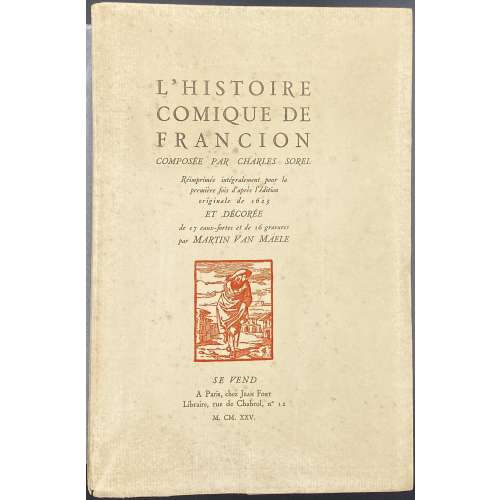 Description: One volume in cream French flapped wrappers, collated 8vo, 22.5 x 14.8 cm, lettered to front (device in red), printed on wove paper, margins untrimmed, some pages uncut, illustrated with tail- and headpieces and 17 sets of plates (4 of each plate) with tissue guards, after Martin van Maele. Front wrapper (red and black): L'HISTOIRE | COMIQUE DE | FRANCION | COMPOSÉE PAR CHARLES SOREL | Réimprimée intégralement pour la | première fois d'après l'édition | originale de 1623 | ET DÉCORÉE | de 17 eaux-fortes et de 16 gravures | par MARTIN VAN MAELE | {device} | SE VEND | A Paris, chez Jean Fort | Libraire, rue de Chabrol, no 12 | M. CM. XXV. || Title-page (red and black): L'HISTOIRE | COMIQUE DE | FRANCION | En laquelle sont découvertes les plus subtiles | finesses et trompeuses inventions tant des hommes | que des femmes de toutes sortes de conditions et | d’âges. Non moins profitable pour s’en | garder, que plaisante à la lecture. | Nouvelle édition conforme à | l’édition princeps de 1623, et | ornée de 17 eaux-fortes et | de 16 compositions par | MARTIN VAN MAELE | {device} | A PARIS | Chez Jean Fort, libraire, | Rue de Chabrol, no 12 | M. CM. XXV. || Collation: π3 (blank, h.t., t.p.), 1-268 χ3 (colophon, 2 blanks), total 214 leaves plus 17 sets of plates (4 of each). Pagination: [6] i-v [vi], 1-411 [412] [4], total 428 pages, ils. Illustrations: 16 tail- and headpieces, and one full-page vignette etched after drawings by Martin van Maële; 17 gravures coloured à la poupée after van Maële’s watercolours, each accompanied with three b/w plates in a different state of the same, incl. frontispiece; unpaginated. Limitation: The run of 1,203 copies printed on October 2, 1925, by Maurice Darantiere in Dijon; 1 copy (№ 1) on Japon Impérial is unique with the original drawings and three additional suites of plates; 10 copies (2-11) on Japon Impérial with three additional suites of plates; 31 copies (12-42) on Hollande with two additional suites of plates; 61 copies (43-103) on Madagascar with one additional suite of plates; 1,100 copies (104-1203) on Enoshima. This copy is № 10 on Japon Impérial with three additional suites of plates. Catalogue raisonné: S. A. Perry (2015) № 28, p. 31. Contributors: Charles Sorel, sieur de Souvigny (French, c. 1602 – 1674) – author Maurice François Alfred Martin van Maële [Martin van Maële] (French, 1863 – 1926) – artist. Maurice Darantiere (French, 1882 – 1962) – printer. Jean-Marie Fort (French, 20th century) – publisher.
Description: One volume in cream French flapped wrappers, collated 8vo, 22.5 x 14.8 cm, lettered to front (device in red), printed on wove paper, margins untrimmed, some pages uncut, illustrated with tail- and headpieces and 17 sets of plates (4 of each plate) with tissue guards, after Martin van Maele. Front wrapper (red and black): L'HISTOIRE | COMIQUE DE | FRANCION | COMPOSÉE PAR CHARLES SOREL | Réimprimée intégralement pour la | première fois d'après l'édition | originale de 1623 | ET DÉCORÉE | de 17 eaux-fortes et de 16 gravures | par MARTIN VAN MAELE | {device} | SE VEND | A Paris, chez Jean Fort | Libraire, rue de Chabrol, no 12 | M. CM. XXV. || Title-page (red and black): L'HISTOIRE | COMIQUE DE | FRANCION | En laquelle sont découvertes les plus subtiles | finesses et trompeuses inventions tant des hommes | que des femmes de toutes sortes de conditions et | d’âges. Non moins profitable pour s’en | garder, que plaisante à la lecture. | Nouvelle édition conforme à | l’édition princeps de 1623, et | ornée de 17 eaux-fortes et | de 16 compositions par | MARTIN VAN MAELE | {device} | A PARIS | Chez Jean Fort, libraire, | Rue de Chabrol, no 12 | M. CM. XXV. || Collation: π3 (blank, h.t., t.p.), 1-268 χ3 (colophon, 2 blanks), total 214 leaves plus 17 sets of plates (4 of each). Pagination: [6] i-v [vi], 1-411 [412] [4], total 428 pages, ils. Illustrations: 16 tail- and headpieces, and one full-page vignette etched after drawings by Martin van Maële; 17 gravures coloured à la poupée after van Maële’s watercolours, each accompanied with three b/w plates in a different state of the same, incl. frontispiece; unpaginated. Limitation: The run of 1,203 copies printed on October 2, 1925, by Maurice Darantiere in Dijon; 1 copy (№ 1) on Japon Impérial is unique with the original drawings and three additional suites of plates; 10 copies (2-11) on Japon Impérial with three additional suites of plates; 31 copies (12-42) on Hollande with two additional suites of plates; 61 copies (43-103) on Madagascar with one additional suite of plates; 1,100 copies (104-1203) on Enoshima. This copy is № 10 on Japon Impérial with three additional suites of plates. Catalogue raisonné: S. A. Perry (2015) № 28, p. 31. Contributors: Charles Sorel, sieur de Souvigny (French, c. 1602 – 1674) – author Maurice François Alfred Martin van Maële [Martin van Maële] (French, 1863 – 1926) – artist. Maurice Darantiere (French, 1882 – 1962) – printer. Jean-Marie Fort (French, 20th century) – publisher. -
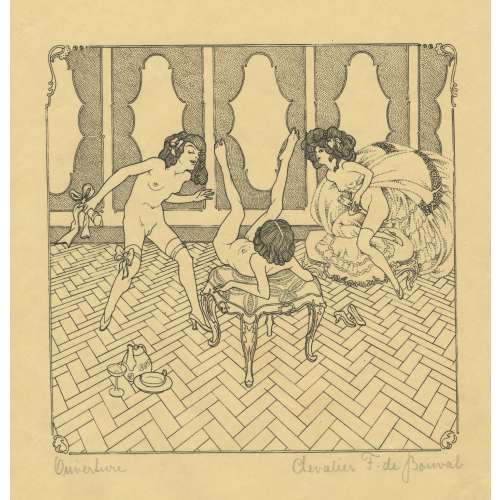 A set of sixteen planographic prints, signed and titled in pencil by owner “Chevalier F. de Bouval” (pseudonym of Franz von Bayros (Austrian, 1866 – 1924). Titles include: 1) Ouverture, 2) champagne brut, 3) maternité, 4) piano, 5) crudité délicieuse, 6. la belle vue, 7) au pensionnat, 8) le collier, 9) languelles pénètrelles, 10) introduction, 11) le sourrogat, 12) variation amoureuse, 13) la surprise, 14) le clef délicat, 15) le monstre gomme, 16) fruits de sud. Printed on wove paper, possibly engraved on wood after ink drawings by Franz von Bayros (Austrian, 1866 – 1924) under the pseudonym Chevalier F. de Bouval. Size: sheet 30 x 24 cm, image 18 x 17.5 cm. In another source, there are two more images from the same set: le passe-partout and la doublette, making 18 images altogether; the set is titled “Lesbia: XVIII sujets”, signed by Chevalier François René de Bouval.
A set of sixteen planographic prints, signed and titled in pencil by owner “Chevalier F. de Bouval” (pseudonym of Franz von Bayros (Austrian, 1866 – 1924). Titles include: 1) Ouverture, 2) champagne brut, 3) maternité, 4) piano, 5) crudité délicieuse, 6. la belle vue, 7) au pensionnat, 8) le collier, 9) languelles pénètrelles, 10) introduction, 11) le sourrogat, 12) variation amoureuse, 13) la surprise, 14) le clef délicat, 15) le monstre gomme, 16) fruits de sud. Printed on wove paper, possibly engraved on wood after ink drawings by Franz von Bayros (Austrian, 1866 – 1924) under the pseudonym Chevalier F. de Bouval. Size: sheet 30 x 24 cm, image 18 x 17.5 cm. In another source, there are two more images from the same set: le passe-partout and la doublette, making 18 images altogether; the set is titled “Lesbia: XVIII sujets”, signed by Chevalier François René de Bouval. -
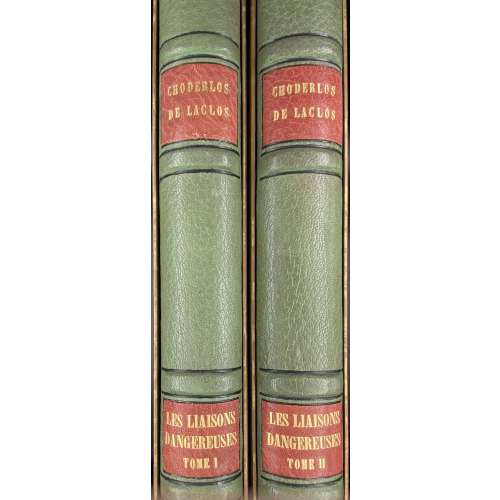 Description: Two volumes 34 x 26.5 cm each, each in a green/gilt marbled in a slipcase, bound in green morocco, spine with raised bands and two gilt-lettered brown labels, original wrappers bound in, marbled endpapers; printed on Montval watermarked wove paper, top margin gilt, outer and bottom margins untrimmed. Front wrapper (in oval red frame): CH. De LACLOS | LES | LIAISONS | DANGEREUSES | {fleuron} | TOME PREMIER (TOME SECOND) | — | CHEZ SYLVAIN SAUVAGE | 16 RUE CASSINI A PARIS | ANNO DOMINI | MCMXXX || Title-page (black and red): ~ CHODERLOS DE LACLOS ~ | LES | LIAISONS | DANGEREUSES | OU | LETTRES | RECUEILLIES DANS UNE SOCIETE ET | PUBLIEES POUR L’INSTRUCTION | DE QUELQUES AUTRES | {vignette} | TOME PREMIER (TOME SECOND) | AVEC DES FIGURES DE S. SAUVAGE | GRAVEES SUR CUIVRE AVEC LA COLLABORATION DE D.A.MAILLART | A PARIS EN L’AN GRACE | MCMXXX || Vol. 1: Collation: 2 blanks, 1 front wrapper, 1 blank/limitation, 1 h.t./frontis., 1 t.p., 3 advert., 1 d.t.p. première partie, 106 leaves, 1 blank, 1 back wrapper, 1 blank/spine, 1 blank; total within wrappers 114 leaves with woodcut fleurons and tailpieces, and 23 engraved and coloured plates, incl. frontispiece, full-page and in-text, some with tissue guards. Pagination: [14] [1] 2-211 [212] [2], ils. Vol. 2: 2 blanks, 1 front wrapper, 1 blank, 1 h.t./frontis., 1 t.p., 1 d.t.p., 109 leaves, 1 plate, 1 colophon, 1 back wrapper, 1 blank/spine, 1 blank; total within wrappers 115 leaves, with woodcut fleurons and tailpieces, and 25 engraved plates, engraved and coloured plates, incl. frontispiece, full-page and in-text, some with tissue guards. Pagination: [8] [1] 2-218 [4], ils. Limitation: Printed on September 29, 1930, 165 copies (1-165), the first four enriched with a suite of b/w plates and one original drawing; 10 copies for collaborators marked I-X. This is copy № 129. Contributors: Choderlos de Laclos, Pierre Ambroise François (French, 1741 – 1803) – author. Sylvain Sauvage [Félix Roy] (French, 1888 – 1948) – artist, publisher. Pierre Bouchet (text), Paul Haasen (plates) – printers.
Description: Two volumes 34 x 26.5 cm each, each in a green/gilt marbled in a slipcase, bound in green morocco, spine with raised bands and two gilt-lettered brown labels, original wrappers bound in, marbled endpapers; printed on Montval watermarked wove paper, top margin gilt, outer and bottom margins untrimmed. Front wrapper (in oval red frame): CH. De LACLOS | LES | LIAISONS | DANGEREUSES | {fleuron} | TOME PREMIER (TOME SECOND) | — | CHEZ SYLVAIN SAUVAGE | 16 RUE CASSINI A PARIS | ANNO DOMINI | MCMXXX || Title-page (black and red): ~ CHODERLOS DE LACLOS ~ | LES | LIAISONS | DANGEREUSES | OU | LETTRES | RECUEILLIES DANS UNE SOCIETE ET | PUBLIEES POUR L’INSTRUCTION | DE QUELQUES AUTRES | {vignette} | TOME PREMIER (TOME SECOND) | AVEC DES FIGURES DE S. SAUVAGE | GRAVEES SUR CUIVRE AVEC LA COLLABORATION DE D.A.MAILLART | A PARIS EN L’AN GRACE | MCMXXX || Vol. 1: Collation: 2 blanks, 1 front wrapper, 1 blank/limitation, 1 h.t./frontis., 1 t.p., 3 advert., 1 d.t.p. première partie, 106 leaves, 1 blank, 1 back wrapper, 1 blank/spine, 1 blank; total within wrappers 114 leaves with woodcut fleurons and tailpieces, and 23 engraved and coloured plates, incl. frontispiece, full-page and in-text, some with tissue guards. Pagination: [14] [1] 2-211 [212] [2], ils. Vol. 2: 2 blanks, 1 front wrapper, 1 blank, 1 h.t./frontis., 1 t.p., 1 d.t.p., 109 leaves, 1 plate, 1 colophon, 1 back wrapper, 1 blank/spine, 1 blank; total within wrappers 115 leaves, with woodcut fleurons and tailpieces, and 25 engraved plates, engraved and coloured plates, incl. frontispiece, full-page and in-text, some with tissue guards. Pagination: [8] [1] 2-218 [4], ils. Limitation: Printed on September 29, 1930, 165 copies (1-165), the first four enriched with a suite of b/w plates and one original drawing; 10 copies for collaborators marked I-X. This is copy № 129. Contributors: Choderlos de Laclos, Pierre Ambroise François (French, 1741 – 1803) – author. Sylvain Sauvage [Félix Roy] (French, 1888 – 1948) – artist, publisher. Pierre Bouchet (text), Paul Haasen (plates) – printers. -
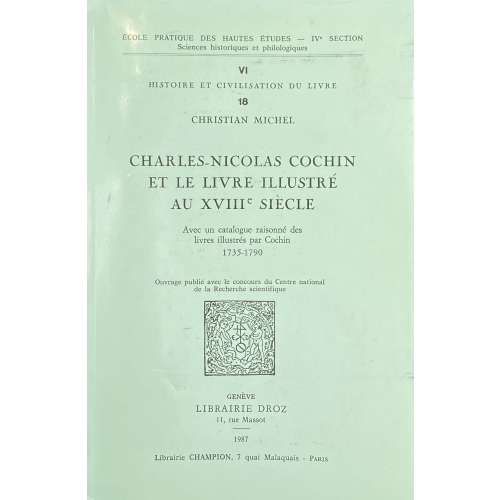 Description: 24.4 x 15.9 cm, softcover in-8vo, light-green publisher's wrappers, lettered in black to both covers and and spine; bookplate pasted to verso of the front wrapper: “LE GÉNIE DE LA GRAVURE | CONSOLE LE GÉNIE DU DESSIN | {vignette} | BIBLIOTHÈQUE DE CLAUDETTE HOULD || Title-page: ÉCOLE PRATIQUE DES HAUTES ÉTUDES — IVe SECTION | Sciences historiques et philologiques | — | VI | HISTOIRE ET CIVILISATION DU LIVRE | 18 | CHRISTIAN MICHEL | CHARLES-NICOLAS COCHIN | ET LE LIVRE ILLUSTRÉ | AU XVIIIe SIÈCLE | Avec un catalogue raisonné des | livres illustrés par Cochin | 1735-1790 | Ouvrage publié avec le concours du Centre national | de la Recherche scientifique | {device} | GENÈVE | LIBRAIRIE DROZ | 11, rue Massot | 1987 ||; front wrapper also has in the bottom: Librairie CHAMPION, 7 quai Malaquais – Paris || Collation: 8vo; [1]-258, 26 leaves of plates (fig. 1-169) extraneous to collation, 26+[27]14 288; plates: unpaginated photo reproduction of Cochin’s 169 drawings and engravings; quire 27 unsigned, together with quire 26 makes 14 leaves. Pagination: [i-vii] viii-x, [1] 2-431 [423 colophon] [2 blank], 26 leaves of plates. Provenance: Claudette Hould, Montréal, Quebec, Canada, spécialiste d’histoire de l’art français. Ref.: British Museum. Publisher: Droz Charles-Nicolas Cochin (French, 1715 – 1790) See Cochin's illustrated books in this collection: LIB-2941.2021, LIB-2766.2021; LIB-2640.2021; LIB-2529.2020.
Description: 24.4 x 15.9 cm, softcover in-8vo, light-green publisher's wrappers, lettered in black to both covers and and spine; bookplate pasted to verso of the front wrapper: “LE GÉNIE DE LA GRAVURE | CONSOLE LE GÉNIE DU DESSIN | {vignette} | BIBLIOTHÈQUE DE CLAUDETTE HOULD || Title-page: ÉCOLE PRATIQUE DES HAUTES ÉTUDES — IVe SECTION | Sciences historiques et philologiques | — | VI | HISTOIRE ET CIVILISATION DU LIVRE | 18 | CHRISTIAN MICHEL | CHARLES-NICOLAS COCHIN | ET LE LIVRE ILLUSTRÉ | AU XVIIIe SIÈCLE | Avec un catalogue raisonné des | livres illustrés par Cochin | 1735-1790 | Ouvrage publié avec le concours du Centre national | de la Recherche scientifique | {device} | GENÈVE | LIBRAIRIE DROZ | 11, rue Massot | 1987 ||; front wrapper also has in the bottom: Librairie CHAMPION, 7 quai Malaquais – Paris || Collation: 8vo; [1]-258, 26 leaves of plates (fig. 1-169) extraneous to collation, 26+[27]14 288; plates: unpaginated photo reproduction of Cochin’s 169 drawings and engravings; quire 27 unsigned, together with quire 26 makes 14 leaves. Pagination: [i-vii] viii-x, [1] 2-431 [423 colophon] [2 blank], 26 leaves of plates. Provenance: Claudette Hould, Montréal, Quebec, Canada, spécialiste d’histoire de l’art français. Ref.: British Museum. Publisher: Droz Charles-Nicolas Cochin (French, 1715 – 1790) See Cochin's illustrated books in this collection: LIB-2941.2021, LIB-2766.2021; LIB-2640.2021; LIB-2529.2020. -
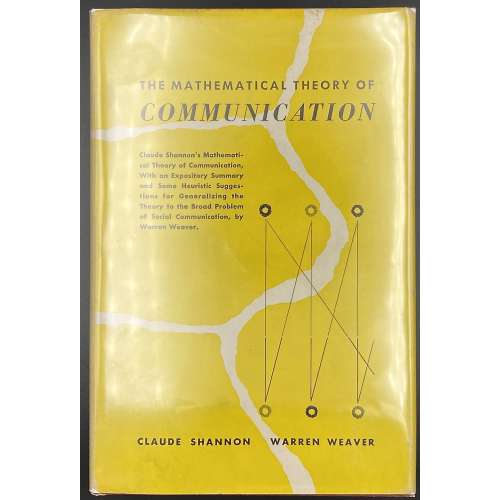 Title page: The Mathematical Theory | Of Communication | By CLAUDE E. SHANNON | and WARREN WEAVER | THE UNIVERSITY OF ILLINOIS PRESS: URBANA | 1949 || Pagination: [8] [2] 3-117 [3 blanks]. Size: 23.5 x 16 cm Binding: Publisher’s burgundy cloth, silver lettering to spine, yellow pictorial DJ with lettering: THE MATHEMATICAL THEORY OF | COMMUNICATION | {8 lines of text} {graph} | CLAUDE SHANNON WARREN WEAVER || Contributors: Shannon, Claude Elwood (American, 1916 – 2001) Weaver, Warren (American, 1894 – 1978)
Title page: The Mathematical Theory | Of Communication | By CLAUDE E. SHANNON | and WARREN WEAVER | THE UNIVERSITY OF ILLINOIS PRESS: URBANA | 1949 || Pagination: [8] [2] 3-117 [3 blanks]. Size: 23.5 x 16 cm Binding: Publisher’s burgundy cloth, silver lettering to spine, yellow pictorial DJ with lettering: THE MATHEMATICAL THEORY OF | COMMUNICATION | {8 lines of text} {graph} | CLAUDE SHANNON WARREN WEAVER || Contributors: Shannon, Claude Elwood (American, 1916 – 2001) Weaver, Warren (American, 1894 – 1978) -
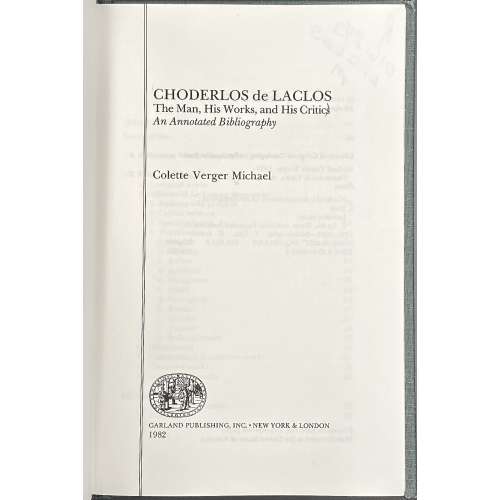 One volume 22.3 x 14.4 cm, green buckram, gilt lettering to spine, Brooklyn public library copy with stamps and sticker; [i-iv] v-xi [xii blank], [1-2] 3-144 [4 blank], total 160 pages, 80 leaves; 620 entries + index. Title-page (vertical double-rule, left indent): CHODERLOS de LACLOS | The Man, His Works, and His Critics | An Annotated Bibliography | Colette Verger Michael | {publisher’s device} | GARLAND PUBLISHING INC. • NEW YORK & LONDON | 1982 || Contributors: Michael, Colette Verger (American, b. 1937) Choderlos de Laclos, Pierre Ambroise François (French, 1741 – 1803) – author. Ref.: WorldCat.
One volume 22.3 x 14.4 cm, green buckram, gilt lettering to spine, Brooklyn public library copy with stamps and sticker; [i-iv] v-xi [xii blank], [1-2] 3-144 [4 blank], total 160 pages, 80 leaves; 620 entries + index. Title-page (vertical double-rule, left indent): CHODERLOS de LACLOS | The Man, His Works, and His Critics | An Annotated Bibliography | Colette Verger Michael | {publisher’s device} | GARLAND PUBLISHING INC. • NEW YORK & LONDON | 1982 || Contributors: Michael, Colette Verger (American, b. 1937) Choderlos de Laclos, Pierre Ambroise François (French, 1741 – 1803) – author. Ref.: WorldCat. -
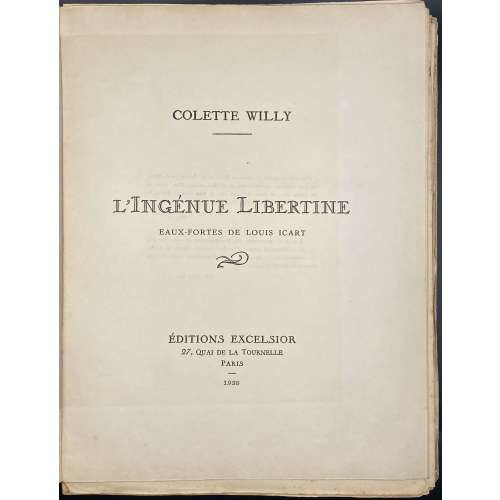 Title-page: COLETTE WILLY | — | L'ingénue libertine | EAUX-FORTES DE LOUIS ICART | ❧ | ÉDITIONS EXCELSIOR | 27, Quai de la Tournelle | Paris | 1926 || Description: French cream flapped wrappers 33.5 x 26 cm with gilt lettering to front and spine, printed on wove paper (Japon Impérial), [2] blank, [1-4] h.t. / limitation, t.p. / citations, 5-191 [3] colophon, plus 20 plates of coloured etchings and 20 plates of b/w etchings, incl. frontispiece. Edition enriched with an autograph letter signed by Colette tipped in after limitation. Edition: limited to 546 copies of which one (№ UN) is unique, printed on Papier de Chine with original colour drawings, 55 (№ 1-50 + 5 H.C.) on Japon Impérial, 65 (№ 51-100 +15 H.C.) on Hollande van Gelder, and 425 (№ 101-500 + 25 H.C.) on vergé paper BFK Rives. This copy is № 48, enriched with Colette a.l.s. and an extra suite of plates. Printed on December 3, 1926, at Arrault et Cie in Tours. Transcript of a.l.s.: "De deux romans (Minne et Les égarements de Minne) qui ne portèrent pas ma signature, j’en ai fait un seul : l’Ingénue libertine. La première partie trouve encore grâce à mes yeux ; je suis plus sévère pour la deuxième et dernière, [mot rayé] superflue et qui sent le travail. Cette libertine aurait bien dû en rester à l’ingénuité. — Colette" Contributors: Sidonie-Gabrielle Colette [a.k.a. Colette] (French, 1873 – 1954) – author. Henry Gauthier-Villars [a.k.a. Willy] (French, 1859 – 1931) – author. Louis Icart (French, 1888 – 1950) – artist.
Title-page: COLETTE WILLY | — | L'ingénue libertine | EAUX-FORTES DE LOUIS ICART | ❧ | ÉDITIONS EXCELSIOR | 27, Quai de la Tournelle | Paris | 1926 || Description: French cream flapped wrappers 33.5 x 26 cm with gilt lettering to front and spine, printed on wove paper (Japon Impérial), [2] blank, [1-4] h.t. / limitation, t.p. / citations, 5-191 [3] colophon, plus 20 plates of coloured etchings and 20 plates of b/w etchings, incl. frontispiece. Edition enriched with an autograph letter signed by Colette tipped in after limitation. Edition: limited to 546 copies of which one (№ UN) is unique, printed on Papier de Chine with original colour drawings, 55 (№ 1-50 + 5 H.C.) on Japon Impérial, 65 (№ 51-100 +15 H.C.) on Hollande van Gelder, and 425 (№ 101-500 + 25 H.C.) on vergé paper BFK Rives. This copy is № 48, enriched with Colette a.l.s. and an extra suite of plates. Printed on December 3, 1926, at Arrault et Cie in Tours. Transcript of a.l.s.: "De deux romans (Minne et Les égarements de Minne) qui ne portèrent pas ma signature, j’en ai fait un seul : l’Ingénue libertine. La première partie trouve encore grâce à mes yeux ; je suis plus sévère pour la deuxième et dernière, [mot rayé] superflue et qui sent le travail. Cette libertine aurait bien dû en rester à l’ingénuité. — Colette" Contributors: Sidonie-Gabrielle Colette [a.k.a. Colette] (French, 1873 – 1954) – author. Henry Gauthier-Villars [a.k.a. Willy] (French, 1859 – 1931) – author. Louis Icart (French, 1888 – 1950) – artist. -
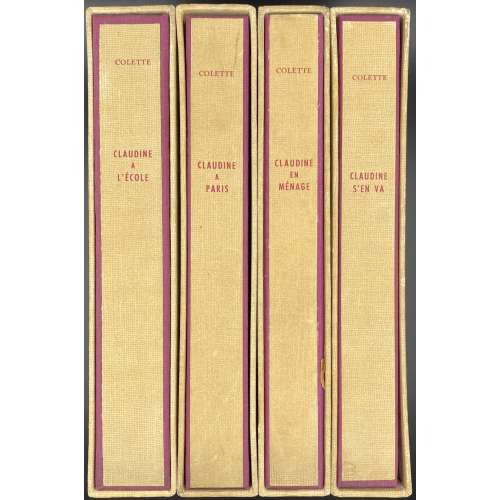 (1) Claudine à l'école: 1st blank and limitation leaves uncut, t.p. / blank ; [1-6] 7-206 [2], colophon "IMPRIMÉ EN BELGIQUE"; 208 pages (104 leaves) plus 12 plates. COLETTE | Claudine | {vignette} | à l'école | ILLUSTRÉE PAR | RENÉE RINGEL | « Leurs Chefs-d'œuvre » | AUX ÉDITIONS TERRES LATINES || (2) Claudine à Paris: 1st blank and limitation leaves uncut, t.p. / blank ; [1-6] 7-153 [3], colophon "IMPRIMÉ EN BELGIQUE"; 156 pages (78 leaves) plus 12 plates. COLETTE | Claudine | {vignette} | à Paris | ILLUSTRÉE PAR | RENÉE RINGEL | « Leurs Chefs-d'œuvre » | AUX ÉDITIONS TERRES LATINES || (3) Claudine en ménage: 1st blank and limitation leaves uncut, t.p. / blank ; [1-6] 7-150 [2], colophon "IMPRIMÉ EN BELGIQUE"; 152 pages (76 leaves) plus 12 plates. COLETTE | Claudine | {vignette} | en ménage | ILLUSTRÉE PAR | RENÉE RINGEL | « Leurs Chefs-d'œuvre » | AUX ÉDITIONS TERRES LATINES || (4) Claudine s'en va: 1st blank and limitation leaves uncut, t.p. / blank ; [1-6] 7-128 [4], colophon "IMPRIMÉ EN BELGIQUE"; 132 pages (66 leaves) plus 12 plates. COLETTE | Claudine | {vignette} | s'en va | ILLUSTRÉE PAR | RENÉE RINGEL | « Leurs Chefs-d'œuvre » | AUX ÉDITIONS TERRES LATINES || Illustrations: in each volume, there are 12 plates extraneous to collation, incl. frontispiece, stencil-coloured (au pochoir) collotype reproductions after drawings by Renée Ringel, and numerous in-text b/w illustrations. Binding: 4 volumes uniformly bound in French flapped pictorial wrappers, spine with lettering and vignette, each in a canvas double slipcase 22 x 17.5 cm, with lettering to spine. Edition: Limited to 1800 copies, of which this is copy № 365, printed by Jean de Clercq, plates printed by Thill, colouring by Ateliers du coloris d’art. Contributors: Sidonie-Gabrielle Colette [a.k.a. Colette] (French, 1873 – 1954) Renée Ringel – nothing is known so far.
(1) Claudine à l'école: 1st blank and limitation leaves uncut, t.p. / blank ; [1-6] 7-206 [2], colophon "IMPRIMÉ EN BELGIQUE"; 208 pages (104 leaves) plus 12 plates. COLETTE | Claudine | {vignette} | à l'école | ILLUSTRÉE PAR | RENÉE RINGEL | « Leurs Chefs-d'œuvre » | AUX ÉDITIONS TERRES LATINES || (2) Claudine à Paris: 1st blank and limitation leaves uncut, t.p. / blank ; [1-6] 7-153 [3], colophon "IMPRIMÉ EN BELGIQUE"; 156 pages (78 leaves) plus 12 plates. COLETTE | Claudine | {vignette} | à Paris | ILLUSTRÉE PAR | RENÉE RINGEL | « Leurs Chefs-d'œuvre » | AUX ÉDITIONS TERRES LATINES || (3) Claudine en ménage: 1st blank and limitation leaves uncut, t.p. / blank ; [1-6] 7-150 [2], colophon "IMPRIMÉ EN BELGIQUE"; 152 pages (76 leaves) plus 12 plates. COLETTE | Claudine | {vignette} | en ménage | ILLUSTRÉE PAR | RENÉE RINGEL | « Leurs Chefs-d'œuvre » | AUX ÉDITIONS TERRES LATINES || (4) Claudine s'en va: 1st blank and limitation leaves uncut, t.p. / blank ; [1-6] 7-128 [4], colophon "IMPRIMÉ EN BELGIQUE"; 132 pages (66 leaves) plus 12 plates. COLETTE | Claudine | {vignette} | s'en va | ILLUSTRÉE PAR | RENÉE RINGEL | « Leurs Chefs-d'œuvre » | AUX ÉDITIONS TERRES LATINES || Illustrations: in each volume, there are 12 plates extraneous to collation, incl. frontispiece, stencil-coloured (au pochoir) collotype reproductions after drawings by Renée Ringel, and numerous in-text b/w illustrations. Binding: 4 volumes uniformly bound in French flapped pictorial wrappers, spine with lettering and vignette, each in a canvas double slipcase 22 x 17.5 cm, with lettering to spine. Edition: Limited to 1800 copies, of which this is copy № 365, printed by Jean de Clercq, plates printed by Thill, colouring by Ateliers du coloris d’art. Contributors: Sidonie-Gabrielle Colette [a.k.a. Colette] (French, 1873 – 1954) Renée Ringel – nothing is known so far. -
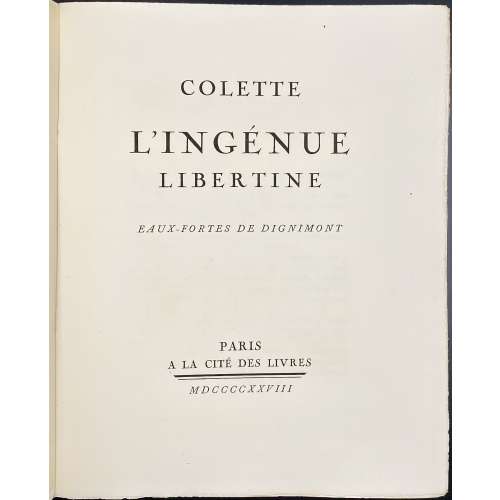 Title-page: COLETTE | L'INGÉNUE | LIBERTINE | EAUX-FORTES DE DIGNIMONT | PARIS | A LA CITÉ DES LIVRES | — | MDCCCCXXVIII || Cover (front wrapper): Similar to t.p. but in red and black: COLETTE | L'INGÉNUE | LIBERTINE | EAUX-FORTES DE DIGNIMONT | PARIS | A LA CITÉ DES LIVRES | — | MDCCCCXXVIII || Description: French flapped wrapper in a red marbled double slipcase with lettered paper label to spine, 29.5 x 23 x 5.5 cm, in-4to, leaves 28 x 22.5 cm. Collation: π4 (π1 in wrapper, π2 blank, π3 h.t. / limitation, π4 t.p. / blank, 1-304, χ2 (χ1 blank, χ2 in wrapper), plus 15 plates extraneous to collation, with tissue-guards, incl. frontispiece. Pagination: [8] [1] 2-237 [238] [6], ils. Plates: 15 etchings in sepia by André Dignimont. Enrichment: Additional full suite of 15 plates in sanguine. Limitation: Edition is limited to 215 copies, 150 of them printed on thick wove paper (Vélin de Hollande), numbered 41 – 190, with one additional suite of plates. This copy is № 168. Printed on October 14, 1928. Contributors: Sidonie-Gabrielle Colette [a.k.a. Colette] (French, 1873 – 1954) André Dignimont (French, 1891 – 1965) – artist. La cité des livres – publishers. R. Coulouma (Argenteuil, director H. Barthélemy) – printer, typography. Atelier de la Roseraie – printer, etchings.
Title-page: COLETTE | L'INGÉNUE | LIBERTINE | EAUX-FORTES DE DIGNIMONT | PARIS | A LA CITÉ DES LIVRES | — | MDCCCCXXVIII || Cover (front wrapper): Similar to t.p. but in red and black: COLETTE | L'INGÉNUE | LIBERTINE | EAUX-FORTES DE DIGNIMONT | PARIS | A LA CITÉ DES LIVRES | — | MDCCCCXXVIII || Description: French flapped wrapper in a red marbled double slipcase with lettered paper label to spine, 29.5 x 23 x 5.5 cm, in-4to, leaves 28 x 22.5 cm. Collation: π4 (π1 in wrapper, π2 blank, π3 h.t. / limitation, π4 t.p. / blank, 1-304, χ2 (χ1 blank, χ2 in wrapper), plus 15 plates extraneous to collation, with tissue-guards, incl. frontispiece. Pagination: [8] [1] 2-237 [238] [6], ils. Plates: 15 etchings in sepia by André Dignimont. Enrichment: Additional full suite of 15 plates in sanguine. Limitation: Edition is limited to 215 copies, 150 of them printed on thick wove paper (Vélin de Hollande), numbered 41 – 190, with one additional suite of plates. This copy is № 168. Printed on October 14, 1928. Contributors: Sidonie-Gabrielle Colette [a.k.a. Colette] (French, 1873 – 1954) André Dignimont (French, 1891 – 1965) – artist. La cité des livres – publishers. R. Coulouma (Argenteuil, director H. Barthélemy) – printer, typography. Atelier de la Roseraie – printer, etchings. -
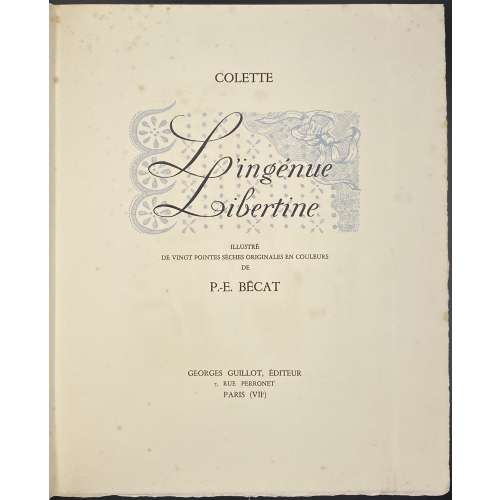 Title-page: COLETTE | L'INGÉNUE | LIBERTINE | ILLUSTRÉ DE VINGT POINTES SÈCHES ORIGINALES EN COULEURS | DE P.-E. BÉCAT | GEORGES GUILLOT, ÉDITEUR | 7, RUE PERRONET | PARIS (VIIe) || French flapped wrapper in a blue double slipcase with dark blue and gilt lettering to spine, 29.5 x 24 x 8 cm, in-folio, leaves 28.5 x 22.5 cm, unbound, with 20 coloured drypoint engravings, with tissue-guards, with 77 initials and tailpieces by Marie Monnier. Limited edition of 420 copies, of which this is copy № XXVII, one of 45 copies marked with Roman numbers and reserved for the artist and collaborators. Printed on November 1st, 1947. Pagination: [16] 1-215 [216] [6], 238 pages (119 leaves) total, incl. plates. Moderate foxing. Contributors: Sidonie-Gabrielle Colette [a.k.a. Colette] (French, 1873 – 1954) Paul-Émile Bécat (French, 1885 – 1960) Marie Monnier (French, 1894 – 1976) Solange et Georges Guillot – publishers. Georges Girard – printer, typography. Manuel Robbe – printer, drypoint engravings.
Title-page: COLETTE | L'INGÉNUE | LIBERTINE | ILLUSTRÉ DE VINGT POINTES SÈCHES ORIGINALES EN COULEURS | DE P.-E. BÉCAT | GEORGES GUILLOT, ÉDITEUR | 7, RUE PERRONET | PARIS (VIIe) || French flapped wrapper in a blue double slipcase with dark blue and gilt lettering to spine, 29.5 x 24 x 8 cm, in-folio, leaves 28.5 x 22.5 cm, unbound, with 20 coloured drypoint engravings, with tissue-guards, with 77 initials and tailpieces by Marie Monnier. Limited edition of 420 copies, of which this is copy № XXVII, one of 45 copies marked with Roman numbers and reserved for the artist and collaborators. Printed on November 1st, 1947. Pagination: [16] 1-215 [216] [6], 238 pages (119 leaves) total, incl. plates. Moderate foxing. Contributors: Sidonie-Gabrielle Colette [a.k.a. Colette] (French, 1873 – 1954) Paul-Émile Bécat (French, 1885 – 1960) Marie Monnier (French, 1894 – 1976) Solange et Georges Guillot – publishers. Georges Girard – printer, typography. Manuel Robbe – printer, drypoint engravings. -
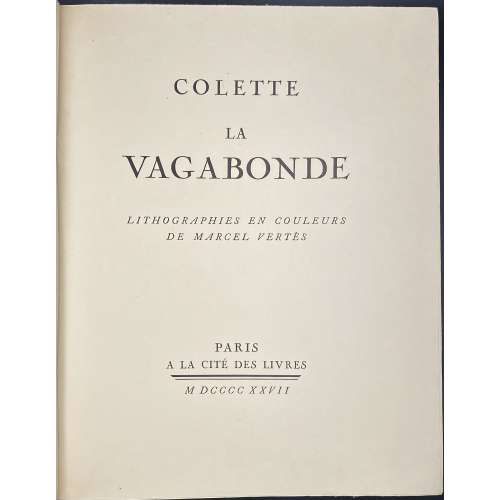 Title-page: COLETTE | LA | VAGABONDE | LITHOGRAPHIES EN COULEURS | DE MARCEL VERTÈS | PARIS | A LA CITE DES LIVRES |—| M DCCCC XXVII || Binding: French flapped wrappers 28.5 x 22.5 cm, in glassine dustcover, front wrapper lettered similarly to title-page but in red and black: COLETTE | LA | VAGABONDE | LITHOGRAPHIES EN COULEURS | DE MARCEL VERTÈS | PARIS | A LA CITE DES LIVRES |—| M DCCCC XXVII ||, in a red marbled cardboard folder 29 x 23 cm with paper label to spine, slipcase missing. Pagination: [2] 1st leaf blank, [2] h.t. / limitation, [2] t.p. / blank, [2] d.t.p. /blank, [3] 4-277 [278 blank], [4 colophon], ils. Collation: π3 1-354 χ1, plus 15 leaves of plates extraneous to collation, incl. frontispiece, chromolithographs by Marcel Vertès. Edition: Limited edition of 305 copies of which this is № 15 (out of numbers 10-24) printed on Japon Impérial paper with three additional suites of plates in black, sanguine and colour, plus 4 refused plates. Printed on the 15th of September 1927: text by Robert Coulouma (Argenteuil, director H. Barthélemy), lithographs by E. Duchatel (Paris) and published by La cité des livres. Missing black versions of LIB-2892.2021-5 and LIB-2892.2021-10 (43 out of 45 prints in place). Refused plates:
Title-page: COLETTE | LA | VAGABONDE | LITHOGRAPHIES EN COULEURS | DE MARCEL VERTÈS | PARIS | A LA CITE DES LIVRES |—| M DCCCC XXVII || Binding: French flapped wrappers 28.5 x 22.5 cm, in glassine dustcover, front wrapper lettered similarly to title-page but in red and black: COLETTE | LA | VAGABONDE | LITHOGRAPHIES EN COULEURS | DE MARCEL VERTÈS | PARIS | A LA CITE DES LIVRES |—| M DCCCC XXVII ||, in a red marbled cardboard folder 29 x 23 cm with paper label to spine, slipcase missing. Pagination: [2] 1st leaf blank, [2] h.t. / limitation, [2] t.p. / blank, [2] d.t.p. /blank, [3] 4-277 [278 blank], [4 colophon], ils. Collation: π3 1-354 χ1, plus 15 leaves of plates extraneous to collation, incl. frontispiece, chromolithographs by Marcel Vertès. Edition: Limited edition of 305 copies of which this is № 15 (out of numbers 10-24) printed on Japon Impérial paper with three additional suites of plates in black, sanguine and colour, plus 4 refused plates. Printed on the 15th of September 1927: text by Robert Coulouma (Argenteuil, director H. Barthélemy), lithographs by E. Duchatel (Paris) and published by La cité des livres. Missing black versions of LIB-2892.2021-5 and LIB-2892.2021-10 (43 out of 45 prints in place). Refused plates:
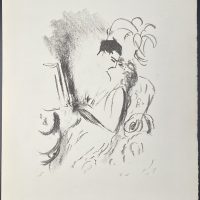

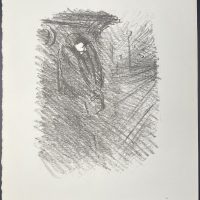 Plates in black, sanguine, and colour.
Plates in black, sanguine, and colour.


 Contributors:
Sidonie-Gabrielle Colette [a.k.a. Colette] (French, 1873 – 1954) – author.
Marcel Vertès [Marcell Vértes] (Jewish-Hungarian-French, 1895 – 1961) – artist.
Other names: Marcel Vertès, Marcel Vertes, Marcell Vértes
Contributors:
Sidonie-Gabrielle Colette [a.k.a. Colette] (French, 1873 – 1954) – author.
Marcel Vertès [Marcell Vértes] (Jewish-Hungarian-French, 1895 – 1961) – artist.
Other names: Marcel Vertès, Marcel Vertes, Marcell Vértes -
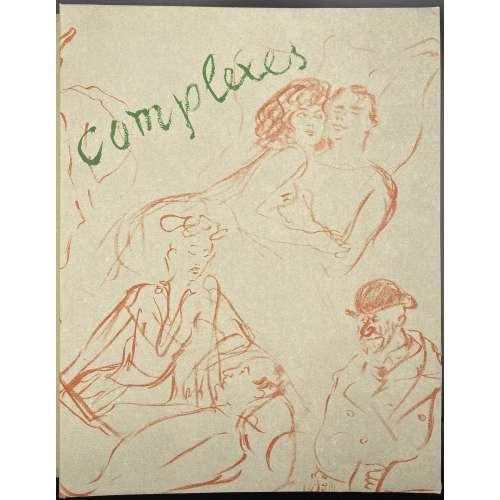 Binding: Grey double-slipcase 34 x 16.5 cm, pictorial folder, French flapped pictorial wrappers, both folder and wrapper with green ms lettering and vignette in sanguine, green ms lettering to spine. Collation: folio in-4to, two leaves in wrappers at the front and back, π8, 104 [11]2, total 50 leaves, incl. plates. Pagination: [4], [2] h.t. / limitation, [2] blank, [1-3] blank, [4-6] frontis., t.p., blank. 7-86 [2] [4] colophon, 100 pages total. Title-page (sanguine and black): COMPLEXES | 40 | DESSINS DE | Vertès | PREFACE DE | PIERRE MAC ORLAN | ANDRÉ SAURET | ÉDITIONS DU LIVRE ★ MONTE-CARLO || Illustrations: One on the front covers, one on the back one headpiece vignette, 37 plates, incl. frontispiece in colour and three on a double-page (full leaf), and one original pencil drawing. Limitation: 890 copies of which 40 (№ 1-40) signed by the artist and contain one original drawing; this copy is № 27. Edition: published by André Sauret, lithographs after Vertès drawings by Georges Duval, printed by Fernand Mourlot; text printed at “La Ruche” under the direction of A. and P. Jarach. Print run completed on November 9, 1948. Contributors: Pierre Mac-Orlan (French, 1882 – 1970) – author. Marcel Vertès [Marcell Vértes] (Jewish-Hungarian-French, 1895 – 1961) – artist. André Sauret (Monaco, fl. 1952 – 1976) – publisher. Other names: Marcel Vertès, Marcel Vertes, Marcell Vértes
Binding: Grey double-slipcase 34 x 16.5 cm, pictorial folder, French flapped pictorial wrappers, both folder and wrapper with green ms lettering and vignette in sanguine, green ms lettering to spine. Collation: folio in-4to, two leaves in wrappers at the front and back, π8, 104 [11]2, total 50 leaves, incl. plates. Pagination: [4], [2] h.t. / limitation, [2] blank, [1-3] blank, [4-6] frontis., t.p., blank. 7-86 [2] [4] colophon, 100 pages total. Title-page (sanguine and black): COMPLEXES | 40 | DESSINS DE | Vertès | PREFACE DE | PIERRE MAC ORLAN | ANDRÉ SAURET | ÉDITIONS DU LIVRE ★ MONTE-CARLO || Illustrations: One on the front covers, one on the back one headpiece vignette, 37 plates, incl. frontispiece in colour and three on a double-page (full leaf), and one original pencil drawing. Limitation: 890 copies of which 40 (№ 1-40) signed by the artist and contain one original drawing; this copy is № 27. Edition: published by André Sauret, lithographs after Vertès drawings by Georges Duval, printed by Fernand Mourlot; text printed at “La Ruche” under the direction of A. and P. Jarach. Print run completed on November 9, 1948. Contributors: Pierre Mac-Orlan (French, 1882 – 1970) – author. Marcel Vertès [Marcell Vértes] (Jewish-Hungarian-French, 1895 – 1961) – artist. André Sauret (Monaco, fl. 1952 – 1976) – publisher. Other names: Marcel Vertès, Marcel Vertes, Marcell Vértes -
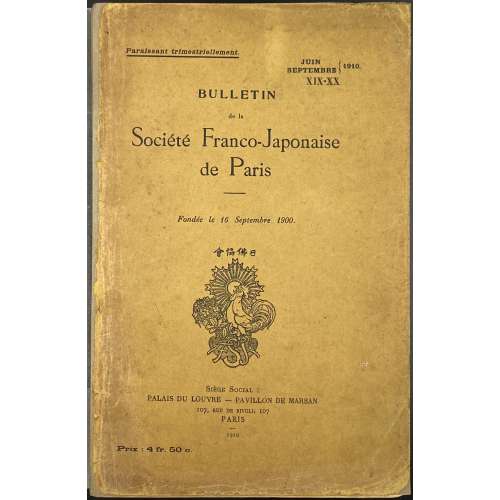 Comte de Tressan. L'évolution de la garde de sabre japonaise de la fin du XVe siècle au commencement du XVIIe (suite), 34 illustr. – pp. 7-35. // Bulletin de la Société Franco-Japonaise de Paris; №№ 19-20, Juin–Septembre 1910, 216 p. — Paris: Société Franco-Japonaise de Paris, Siège Social, 1910. Publisher's original green wrappers with black lettering: On top: Paraissant trimestriellement. | JUIN | SEPTEMBRE | } 1920 | XIX-XX | In the middle: BULLETIN | de la | Société Franco-Japonaise | de Paris | [—] Fondée le 16 Septembre 1900 | [device] | Bottom: Siège Social : | PALAIS DU LOUVRE — PAVILLON DE MARSAN | 107, RUE DE RIVOLI, 107 | Paris | 1910 | Prix : 4 fr 50 c || — Pp.: [4] [1-5] 6-216 [2 - errata / blank] [2 - imprim./ blank] [6]. Size: 27 x 17.5 cm.
Comte de Tressan. L'évolution de la garde de sabre japonaise de la fin du XVe siècle au commencement du XVIIe (suite), 34 illustr. – pp. 7-35. // Bulletin de la Société Franco-Japonaise de Paris; №№ 19-20, Juin–Septembre 1910, 216 p. — Paris: Société Franco-Japonaise de Paris, Siège Social, 1910. Publisher's original green wrappers with black lettering: On top: Paraissant trimestriellement. | JUIN | SEPTEMBRE | } 1920 | XIX-XX | In the middle: BULLETIN | de la | Société Franco-Japonaise | de Paris | [—] Fondée le 16 Septembre 1900 | [device] | Bottom: Siège Social : | PALAIS DU LOUVRE — PAVILLON DE MARSAN | 107, RUE DE RIVOLI, 107 | Paris | 1910 | Prix : 4 fr 50 c || — Pp.: [4] [1-5] 6-216 [2 - errata / blank] [2 - imprim./ blank] [6]. Size: 27 x 17.5 cm. -
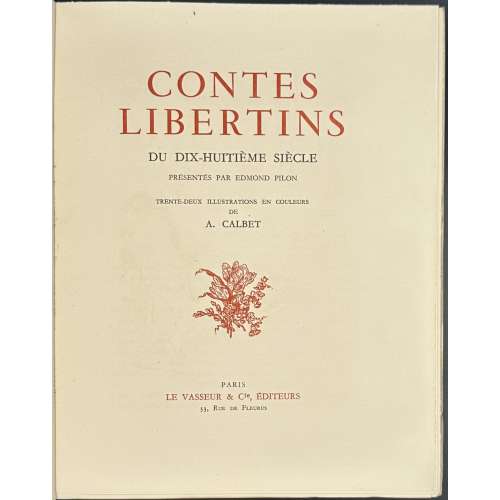 NEWSoftcover, cream French flapped wrappers, 242 x 192 mm, glassine dust jacket, lower and outer margins untrimmed, red lettering to front wrapper CONTES LIBERTINS | DU | DIX-HUITIÈME SIÈCLE; in a double slipcase; 10 full-page colour intaglio prints, incl. frontispiece, and 10 half-page coloured prints after Antoine Calbet; pp.: [1-8] 9-223 [224] [6], total 115 leaves plus ten plates with tissue guards extraneous to collation. Copy enhanced with a full suite of 32 uncoloured intaglio prints, and 12 refused plates:
NEWSoftcover, cream French flapped wrappers, 242 x 192 mm, glassine dust jacket, lower and outer margins untrimmed, red lettering to front wrapper CONTES LIBERTINS | DU | DIX-HUITIÈME SIÈCLE; in a double slipcase; 10 full-page colour intaglio prints, incl. frontispiece, and 10 half-page coloured prints after Antoine Calbet; pp.: [1-8] 9-223 [224] [6], total 115 leaves plus ten plates with tissue guards extraneous to collation. Copy enhanced with a full suite of 32 uncoloured intaglio prints, and 12 refused plates: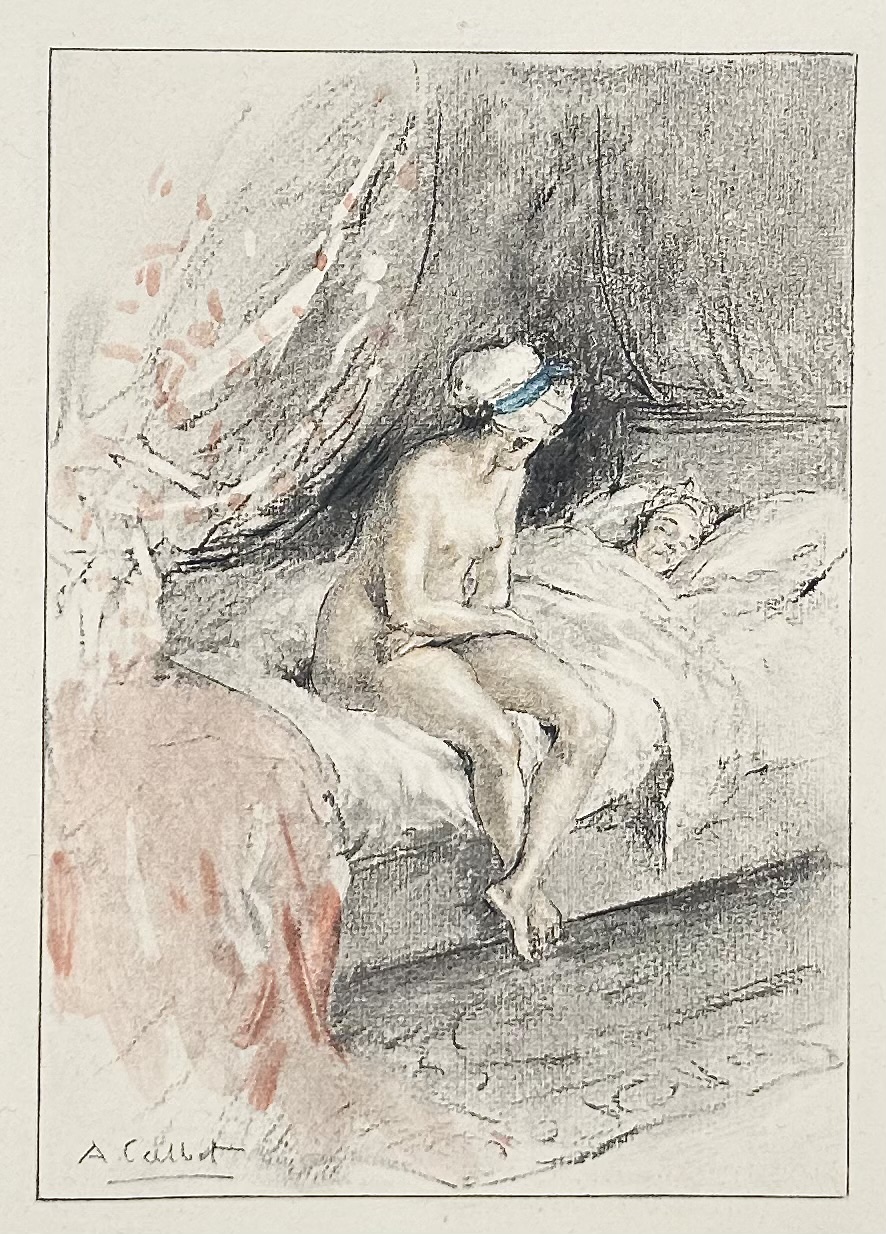
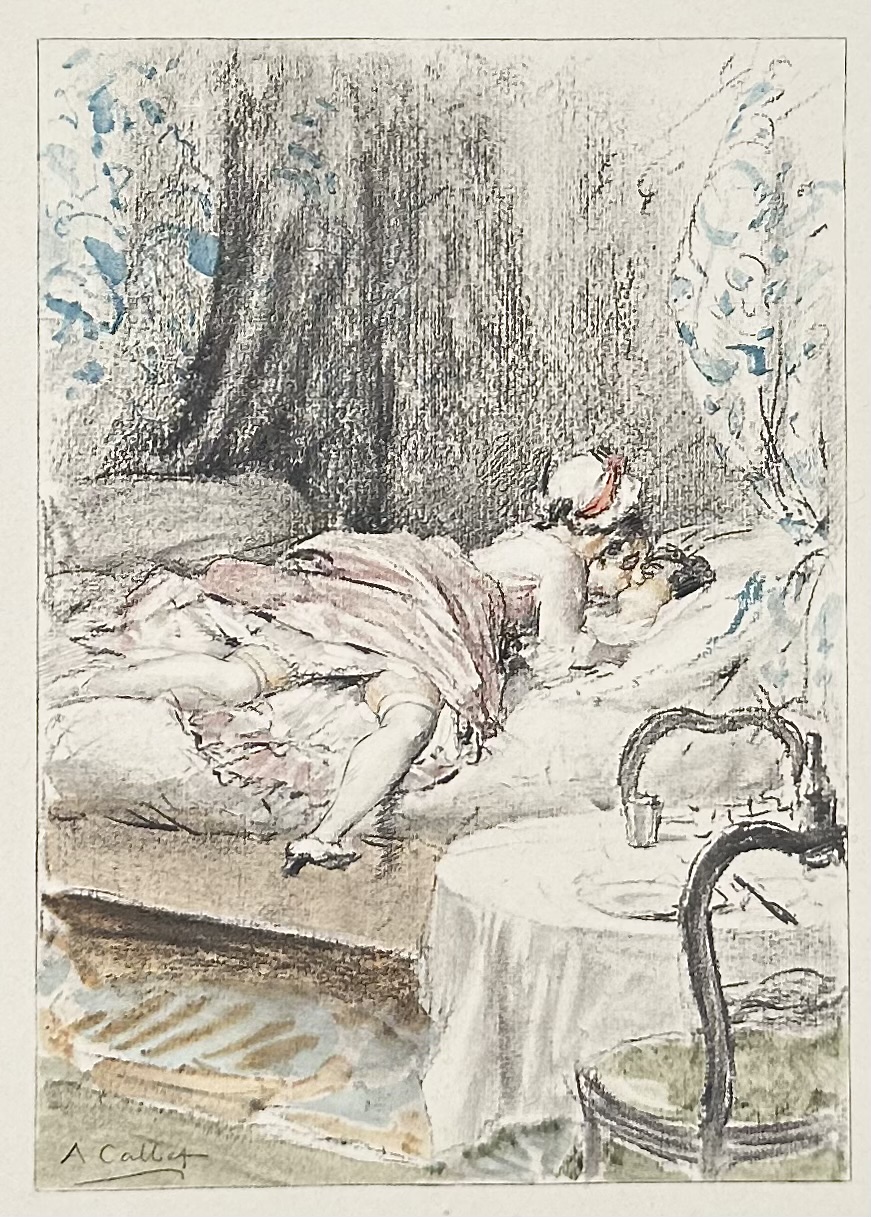
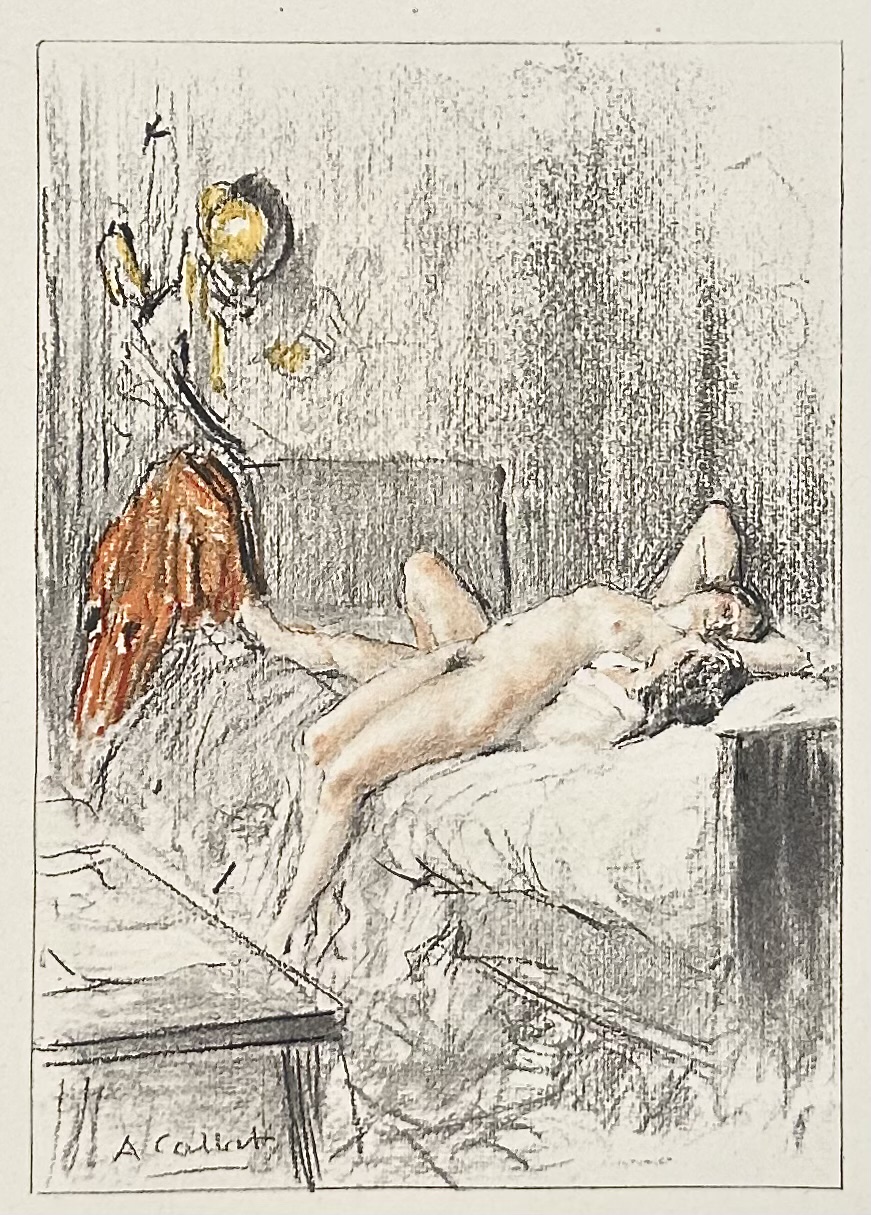
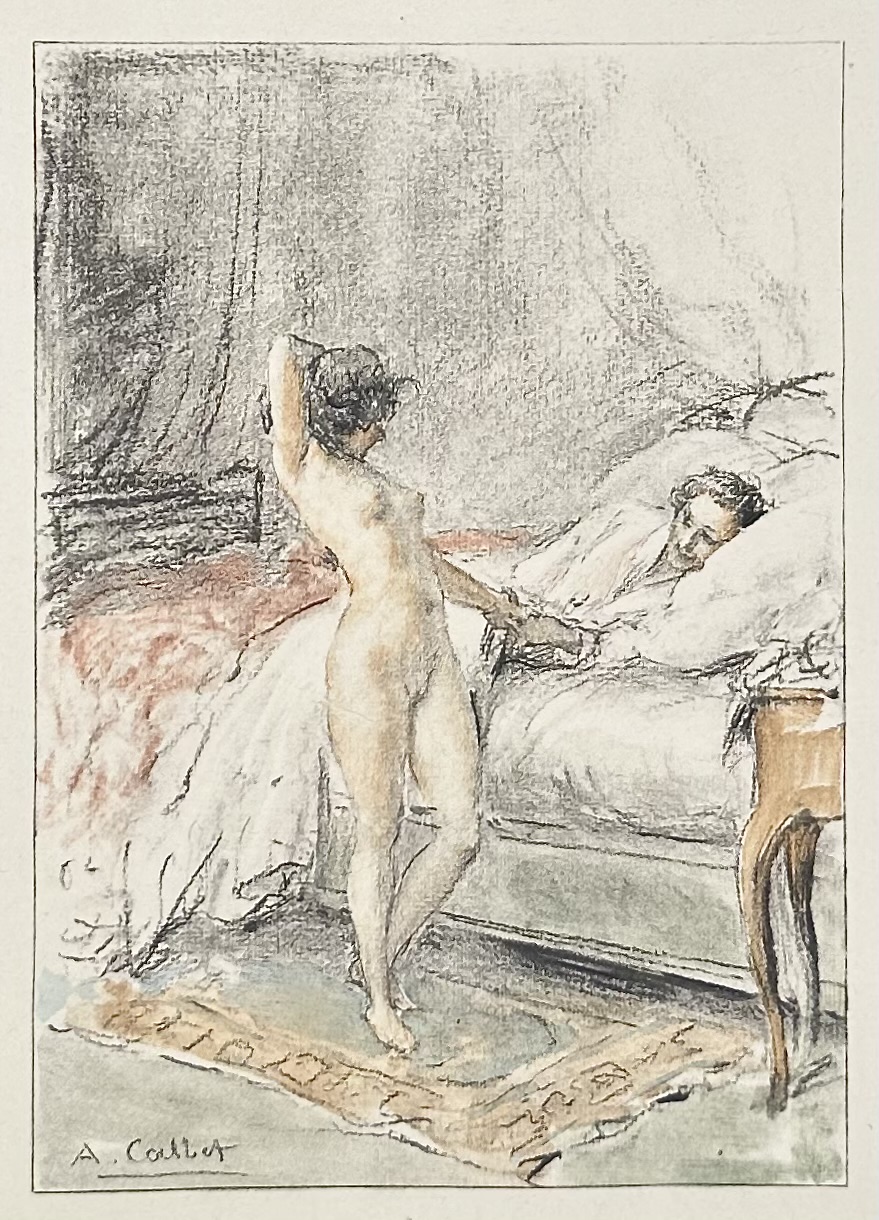
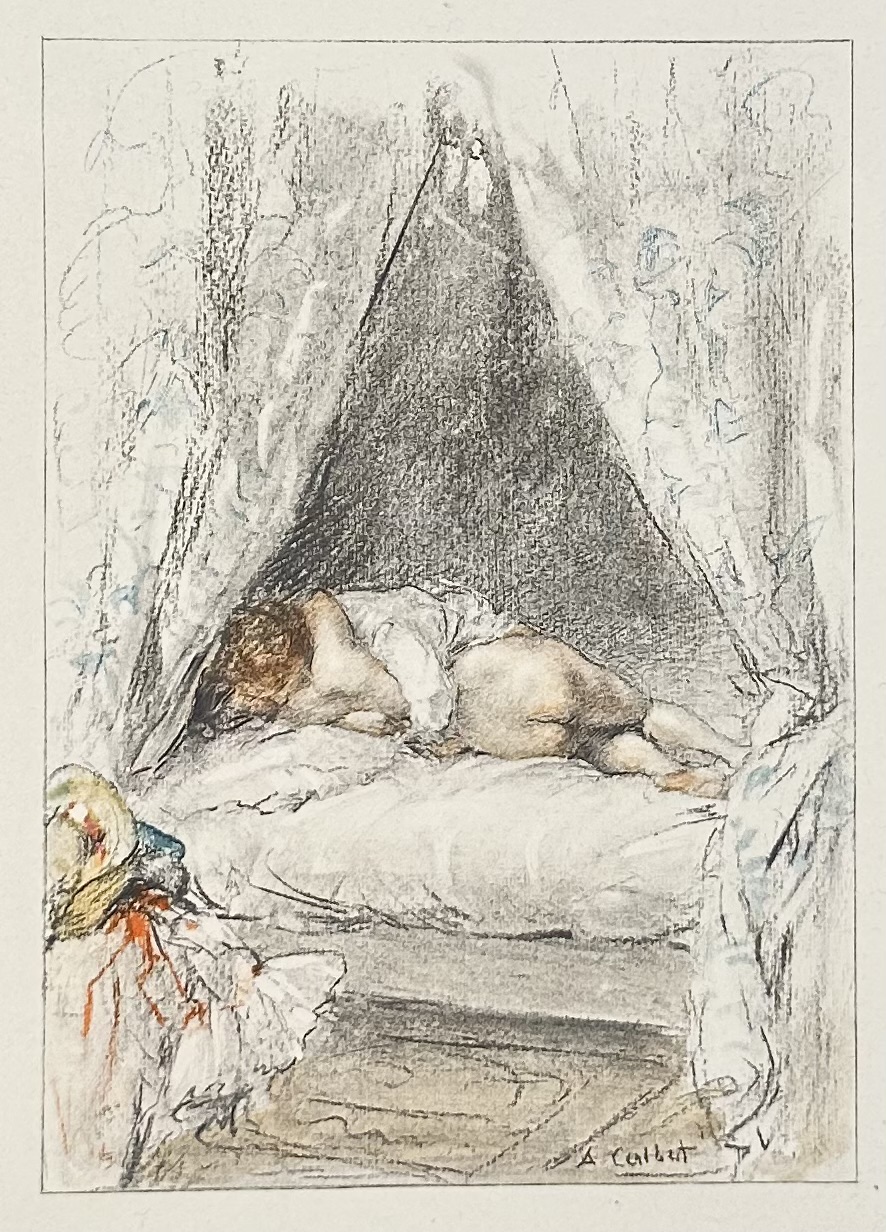
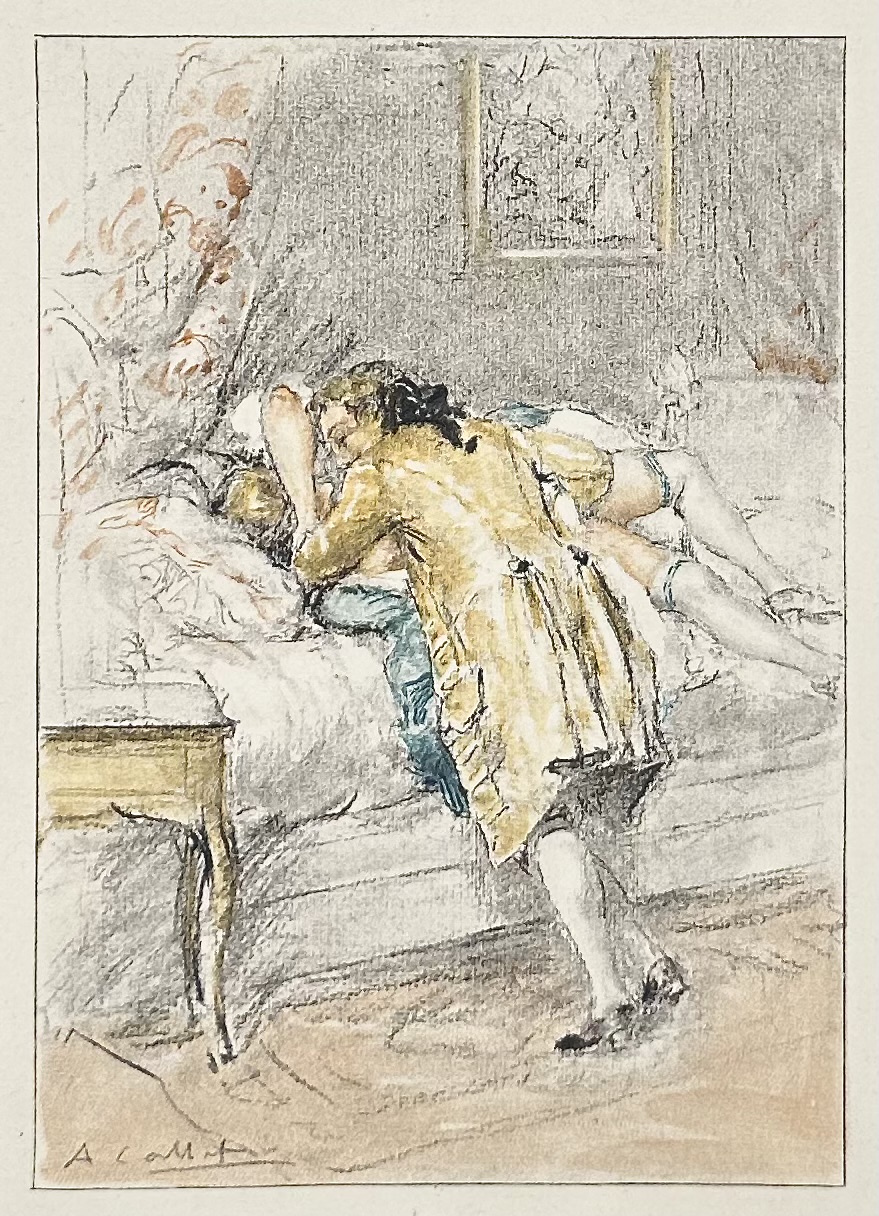
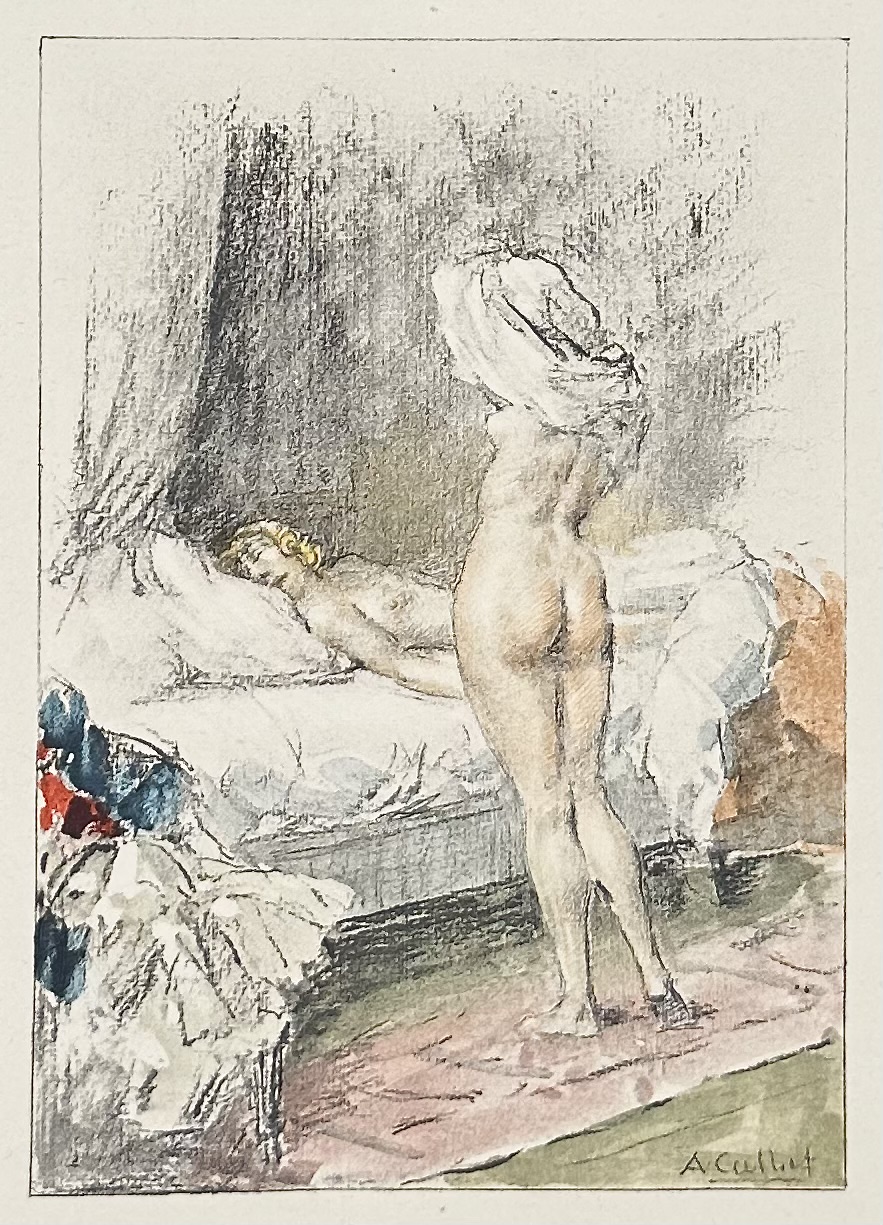
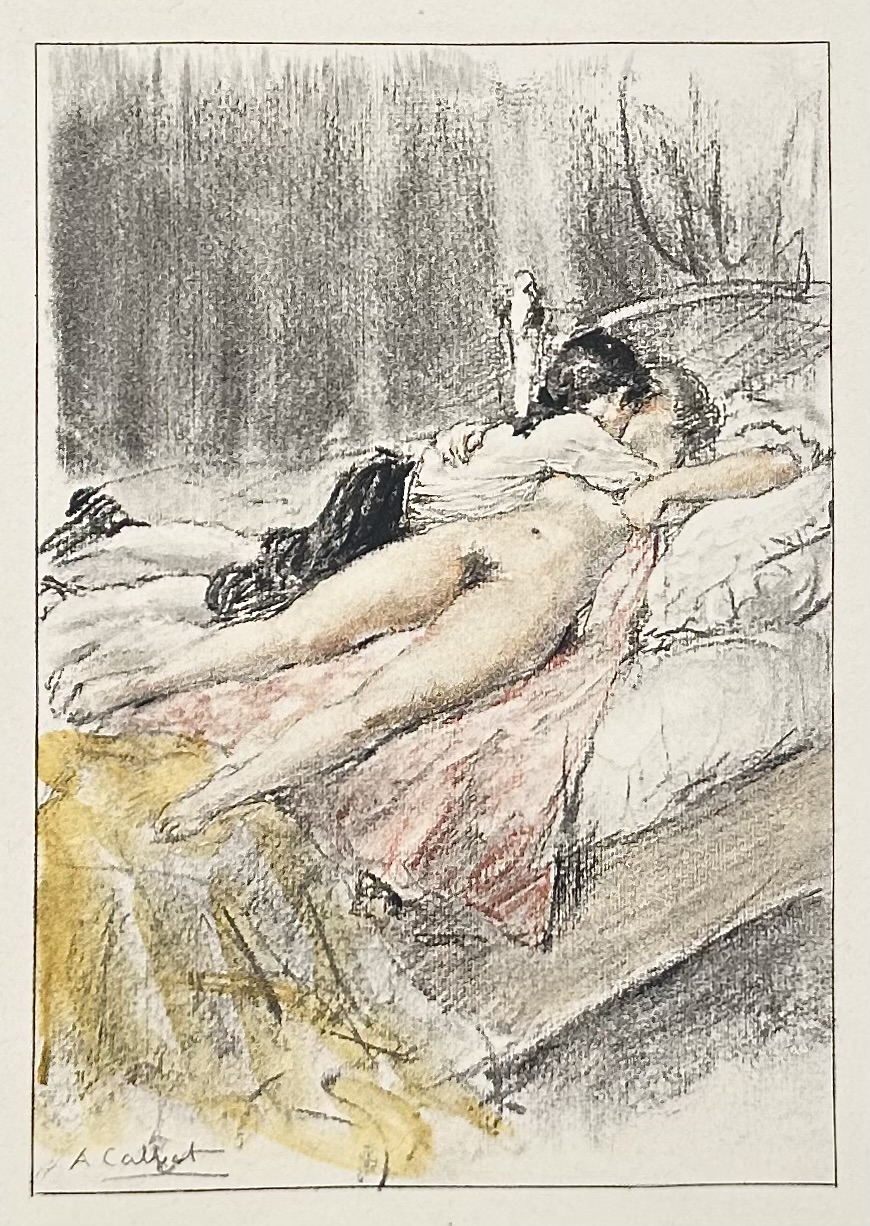
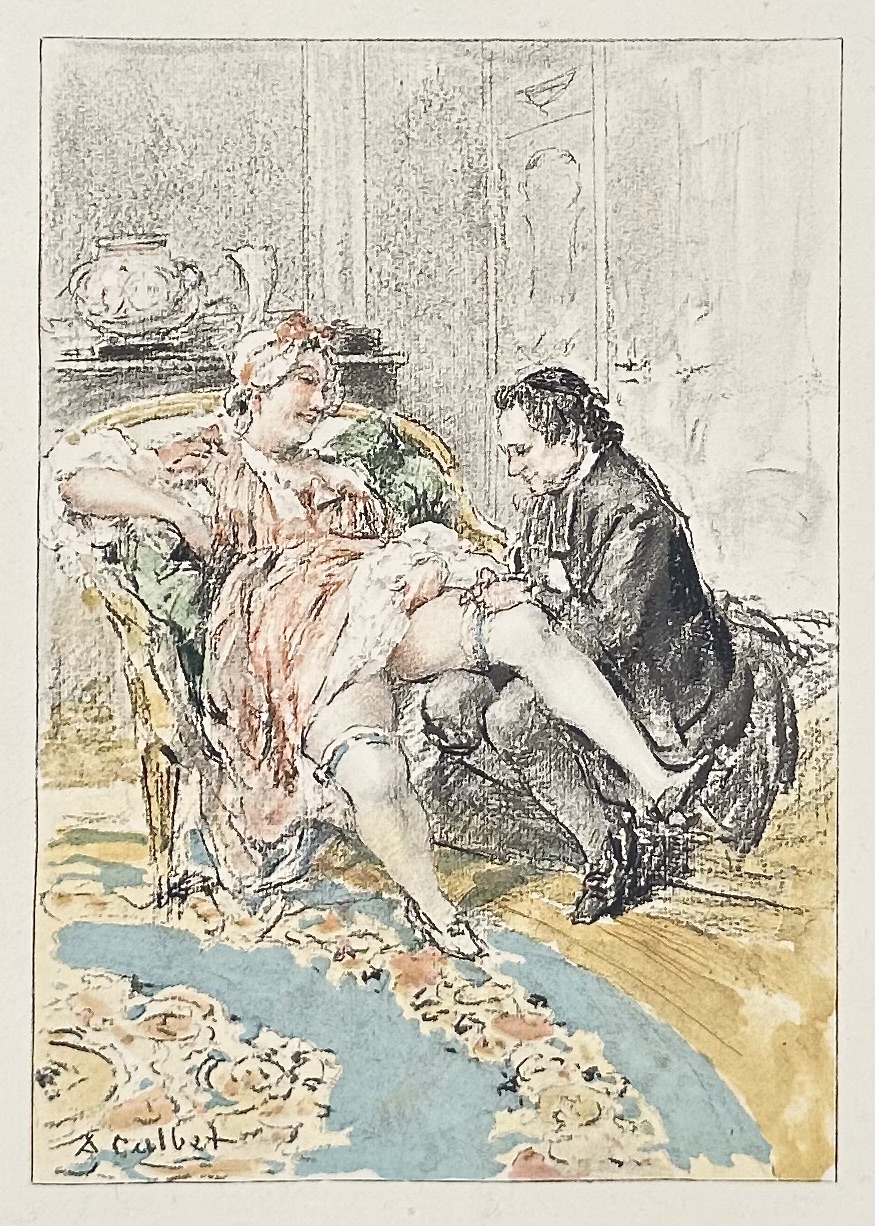
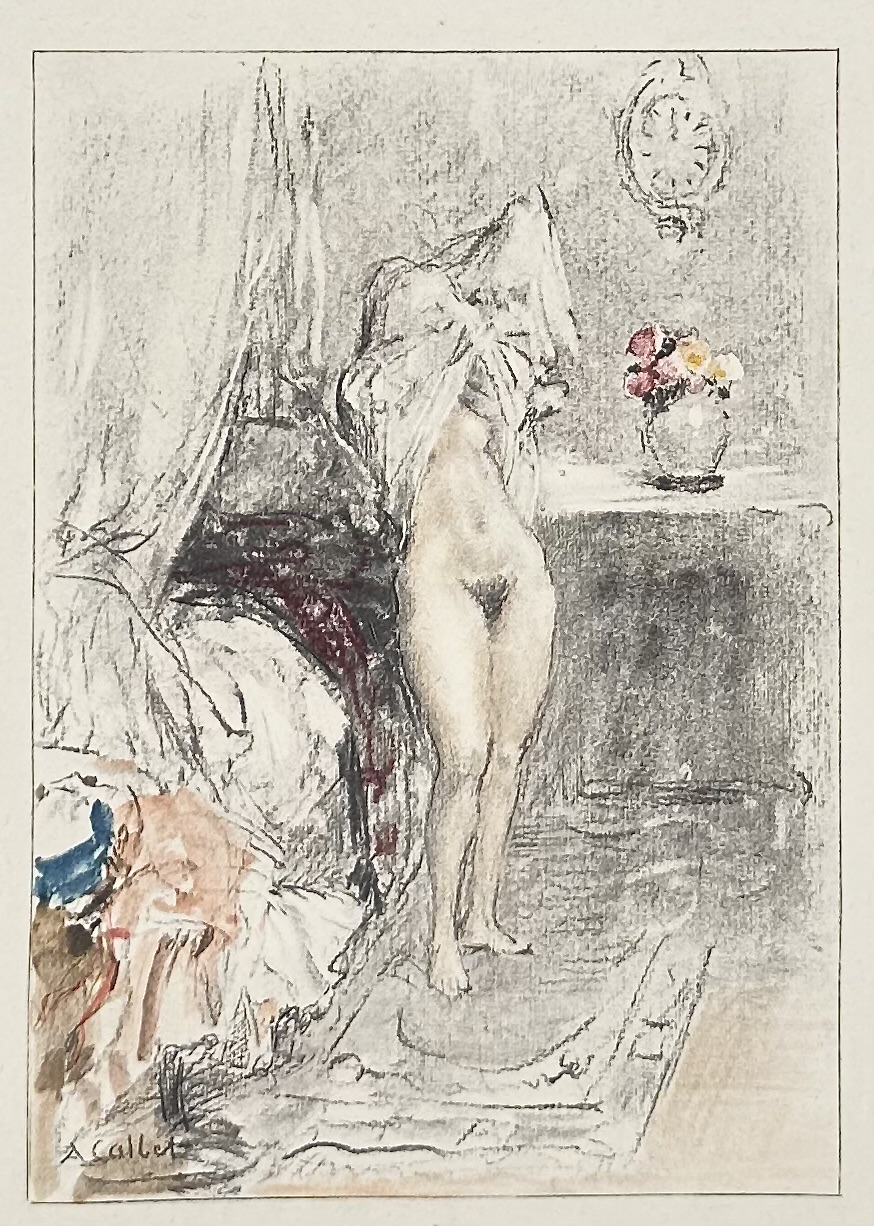
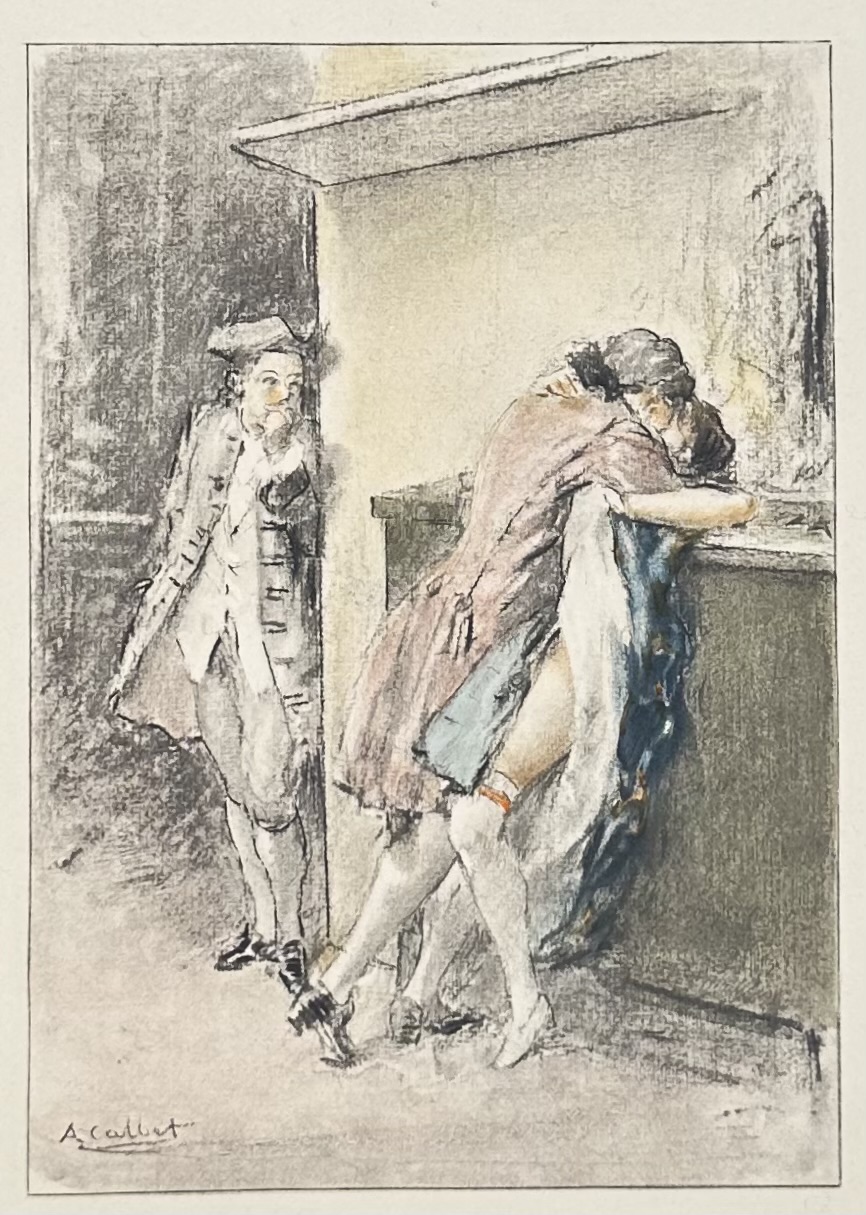
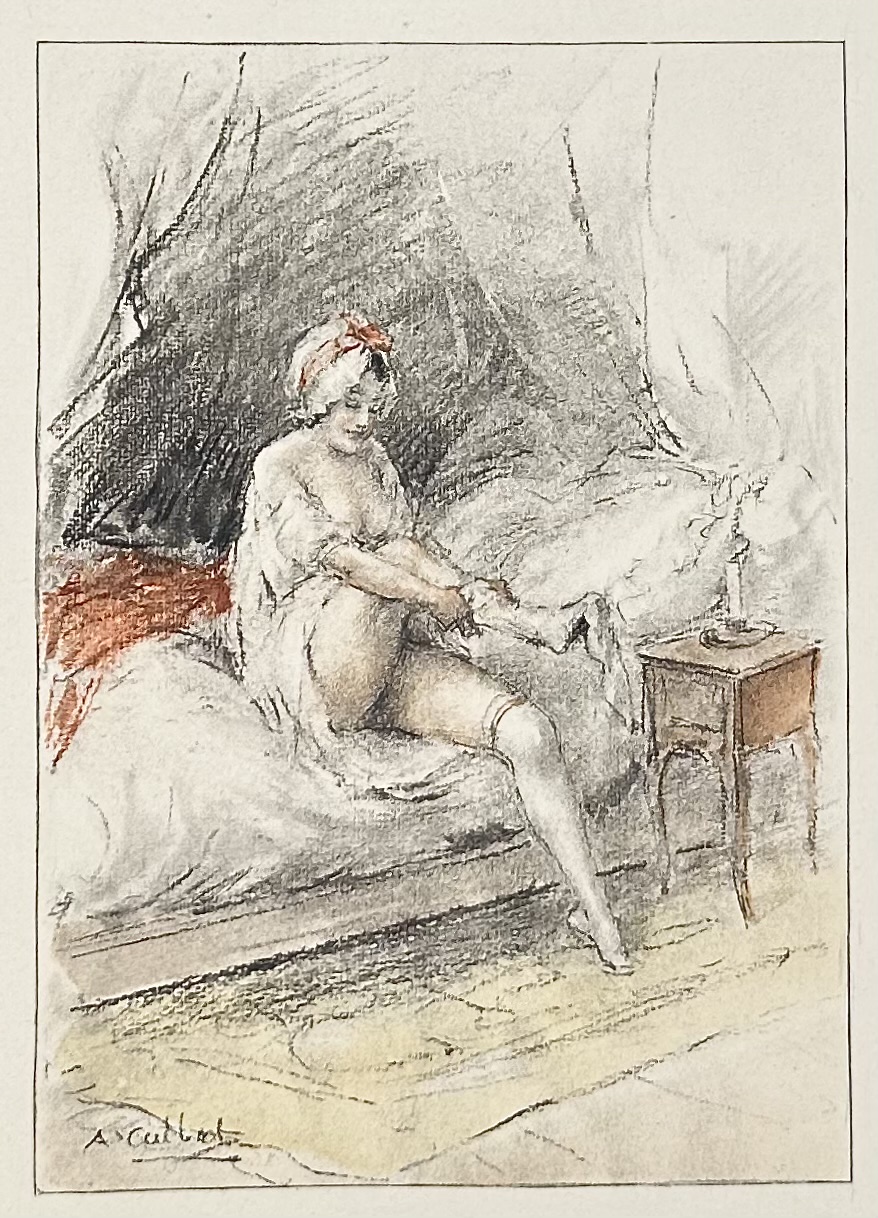 Title-page (red and black): CONTES LIBERTINS | DU DIX-HUITIÈME SIÈCLE | PRÉSENTÉS PAR EDMOND PILON | TRENTE-DEUX ILLUSTRATIONS EN COULEURS | DE | A. CALBET | {fleuron} | PARIS | LE VASSEUR & Cie, ÉDITEURS | 33, Rue de Fleurus ||
Limitation: 587 copies, of which 32 on Japon Impérial (№№ 1-32), 65 on Hollande Van Gilder (№№ 33-97), 490 on Velin a la forme de Rives (№№ 98-587). 25 copies were printed on top of this print run for collaborators, numbered in Roman letters. This copy is № 77 on watermarked Van Gilder Zonnen paper.
Colophon: LE TEXTE DE CET OUVRAGE A | ÉTÉ IMPRIMÉ SUR LES PRESSES | DE CL. JACOUB ET Cie. | LES ILLUSTRATIONS, GRAVÉES PAR L. MACCARD, ONT ÉTÉ | TIRÉES EN TAILLE-DOUCE | PAR A. PORCABEUF ET Cie. | ACHEVÉ D'IMPRIMER, A | PARIS, LE 12 OCTOBRE 1936.
Table of contents:
Histoire de madame Allain – Notice sur le comte de Caylus.
Histoire de Cidal Acmet – Notice sur l'abbé Prevost
Aline, reine de Golconde – Notice sur le chevalier de Boufflers
Cosi-Sancta – notice sur Voltaire.
Cécile, Marine et Bellino – Notice sur Casanova de Seingalt
Histoire de Babet – Notice sur l'abbé Du Laurens
Histoire de Fanny Hill – Notice sur John Cleland.
Louise et Thérèse – Notice sur Rétif de La Bretonne
Contributors:
Pilon, Edmond (French, 1874 – 1945) – compiler
Le Vasseur & Cie – publisher
Calbet, Antoine (French, 1860 – 1942) – artist
Cl. Jacoub et Cie – printer/text
Maccard, Louis (French) – engraver
Porcabeuf, Alfred (French, 1867 – 1952) – printer/plates
Authors:
Caylus, Anne Claude de [comte de Caylus] (French, 1692 – 1765)
Prévost d'Exiles, Antoine François [Abbé Prévost] (French, 1697 – 1763)
Boufflers, Stanislas Jean, chevalier de (French, 1738 – 1815)
Voltaire, François Marie Arouet de (French, 1694 – 1778)
Casanova, Giacomo Girolamo (Italian, 1725 – 1798)
Laurent, Henri-Joseph [Abbé Du Laurens] (French, 1719 – 1793)
Cleland, John (British, c. 1709 – 1789)
Restif [Retif] de la Bretonne, Nicolas Edmé (French, 1734 – 1806)
Title-page (red and black): CONTES LIBERTINS | DU DIX-HUITIÈME SIÈCLE | PRÉSENTÉS PAR EDMOND PILON | TRENTE-DEUX ILLUSTRATIONS EN COULEURS | DE | A. CALBET | {fleuron} | PARIS | LE VASSEUR & Cie, ÉDITEURS | 33, Rue de Fleurus ||
Limitation: 587 copies, of which 32 on Japon Impérial (№№ 1-32), 65 on Hollande Van Gilder (№№ 33-97), 490 on Velin a la forme de Rives (№№ 98-587). 25 copies were printed on top of this print run for collaborators, numbered in Roman letters. This copy is № 77 on watermarked Van Gilder Zonnen paper.
Colophon: LE TEXTE DE CET OUVRAGE A | ÉTÉ IMPRIMÉ SUR LES PRESSES | DE CL. JACOUB ET Cie. | LES ILLUSTRATIONS, GRAVÉES PAR L. MACCARD, ONT ÉTÉ | TIRÉES EN TAILLE-DOUCE | PAR A. PORCABEUF ET Cie. | ACHEVÉ D'IMPRIMER, A | PARIS, LE 12 OCTOBRE 1936.
Table of contents:
Histoire de madame Allain – Notice sur le comte de Caylus.
Histoire de Cidal Acmet – Notice sur l'abbé Prevost
Aline, reine de Golconde – Notice sur le chevalier de Boufflers
Cosi-Sancta – notice sur Voltaire.
Cécile, Marine et Bellino – Notice sur Casanova de Seingalt
Histoire de Babet – Notice sur l'abbé Du Laurens
Histoire de Fanny Hill – Notice sur John Cleland.
Louise et Thérèse – Notice sur Rétif de La Bretonne
Contributors:
Pilon, Edmond (French, 1874 – 1945) – compiler
Le Vasseur & Cie – publisher
Calbet, Antoine (French, 1860 – 1942) – artist
Cl. Jacoub et Cie – printer/text
Maccard, Louis (French) – engraver
Porcabeuf, Alfred (French, 1867 – 1952) – printer/plates
Authors:
Caylus, Anne Claude de [comte de Caylus] (French, 1692 – 1765)
Prévost d'Exiles, Antoine François [Abbé Prévost] (French, 1697 – 1763)
Boufflers, Stanislas Jean, chevalier de (French, 1738 – 1815)
Voltaire, François Marie Arouet de (French, 1694 – 1778)
Casanova, Giacomo Girolamo (Italian, 1725 – 1798)
Laurent, Henri-Joseph [Abbé Du Laurens] (French, 1719 – 1793)
Cleland, John (British, c. 1709 – 1789)
Restif [Retif] de la Bretonne, Nicolas Edmé (French, 1734 – 1806) -
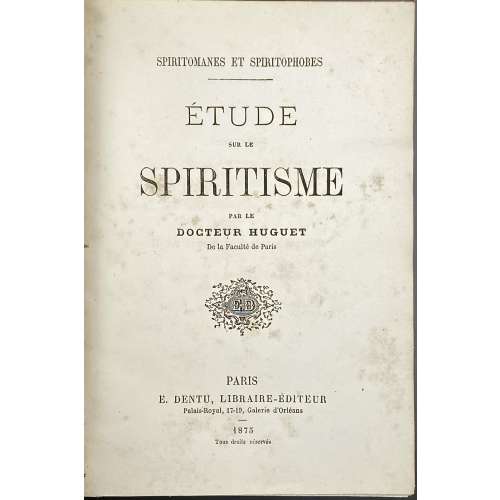 Hardcover volume 20 x 14 cm, bound in burgundy half faux chagrin over brown faux chagrin boards, gilt lettering to spine, marbled endpapers, all margins sprinkled blue. Convolute: 1) SPIRITOMANES ET SPIRITOPHOBES |— | ÉTUDE | SUR LE | SPIRITISME | PAR LE | DOCTEUR HUGUET | De la Faculté de Paris | {« ED » publsiher’s device} | PARIS | E. DENTU, LIBRAIRE-ÉDUTEUR | Palais-Royal, 17-19, Galerie d’Orléans | – | 1875 | Tous droits réservés ||; pp. [1-7] 8-48, with Dr Huguet signature to h.t. verso. Contents: Introduction. I. Le procès du 16 juin 1875; MM. Firman, Buguet, Leymarie. II. Le Spiritisme dans ses rapports avec le dogme, l’histoire, la science. Conclusion. 2) Same, pp. [1-7] 8-48, with Dr Huguet signature to h.t. verso. 3) FÉDÉRATION SPIRITE BELGE | — | Étude critique | DU LIVRE INTITULÉ | L'Hypnotisme | et le Spiritisme | du Docteur Joseph LAPPONI | Médecin de L. L. S. S. LÉON XIII et PIE X. | * | CONFÉRENCE | PAR | J. FRAIKIN | Président de la Fédération Spirite de Liége, | Vice-Président de la Fédération Spirite Belge. | * | Imp. Emile Dumon | Rue Haute-Marexhe, 27, Herstal-Liége. ||; pp. [1-3] 4-50 [51] errata/blank. 4) BUREAU PERMANENT D’ÉTUDE | DES | PHÉNOMÈNES SPIRITES | ANVERS | * | Cours De Doctrine Spirite | — | Imprimerie et Publicité « LA GÉNÉRALE » (SOC. AN.) Anvers. ||; 6 leaves, pagination trimmed out with partly visible numbers 13 and 18 ; includes Deuxième leçon « Du passage de la vie… », t.p., 7 pp. of text, last three pages blank. 5) LA PSYCHOLOGIE EXPERIMENTALE || Manifeste adresse par le « Syndicat de la Presse spiritualiste de France » | au Congres spiritualiste de Londres (Juin 1898); pp. [1] 2-31 [32]. Contents: I. Prolégomènes. II. Télépathie. III. Médiumnité. Conclusion. 6) LE FLUIDE HUMAIN | Son existence/ | Ses lois * Ses propriétés | — | CONFÉRENCE | DONNÉE PAR LE | Sous-Lieutenant DE BACKERE | — ||; pp. [1-3] 4-28. Contributors: Hilarion Huguet (French, ? – ?) Alfred-Henri Firman (American, ? – ?) Édouard Isidore Buguet (1840 – 1901) Pierre-Gaëtan Leymarie (1827 – 1901) Giuseppe Lapponi (Italian, 1851 – 1906) Jacques Fraikin (Belgian, ? – ?) Franz de Backere (Belgian, ? – ?)
Hardcover volume 20 x 14 cm, bound in burgundy half faux chagrin over brown faux chagrin boards, gilt lettering to spine, marbled endpapers, all margins sprinkled blue. Convolute: 1) SPIRITOMANES ET SPIRITOPHOBES |— | ÉTUDE | SUR LE | SPIRITISME | PAR LE | DOCTEUR HUGUET | De la Faculté de Paris | {« ED » publsiher’s device} | PARIS | E. DENTU, LIBRAIRE-ÉDUTEUR | Palais-Royal, 17-19, Galerie d’Orléans | – | 1875 | Tous droits réservés ||; pp. [1-7] 8-48, with Dr Huguet signature to h.t. verso. Contents: Introduction. I. Le procès du 16 juin 1875; MM. Firman, Buguet, Leymarie. II. Le Spiritisme dans ses rapports avec le dogme, l’histoire, la science. Conclusion. 2) Same, pp. [1-7] 8-48, with Dr Huguet signature to h.t. verso. 3) FÉDÉRATION SPIRITE BELGE | — | Étude critique | DU LIVRE INTITULÉ | L'Hypnotisme | et le Spiritisme | du Docteur Joseph LAPPONI | Médecin de L. L. S. S. LÉON XIII et PIE X. | * | CONFÉRENCE | PAR | J. FRAIKIN | Président de la Fédération Spirite de Liége, | Vice-Président de la Fédération Spirite Belge. | * | Imp. Emile Dumon | Rue Haute-Marexhe, 27, Herstal-Liége. ||; pp. [1-3] 4-50 [51] errata/blank. 4) BUREAU PERMANENT D’ÉTUDE | DES | PHÉNOMÈNES SPIRITES | ANVERS | * | Cours De Doctrine Spirite | — | Imprimerie et Publicité « LA GÉNÉRALE » (SOC. AN.) Anvers. ||; 6 leaves, pagination trimmed out with partly visible numbers 13 and 18 ; includes Deuxième leçon « Du passage de la vie… », t.p., 7 pp. of text, last three pages blank. 5) LA PSYCHOLOGIE EXPERIMENTALE || Manifeste adresse par le « Syndicat de la Presse spiritualiste de France » | au Congres spiritualiste de Londres (Juin 1898); pp. [1] 2-31 [32]. Contents: I. Prolégomènes. II. Télépathie. III. Médiumnité. Conclusion. 6) LE FLUIDE HUMAIN | Son existence/ | Ses lois * Ses propriétés | — | CONFÉRENCE | DONNÉE PAR LE | Sous-Lieutenant DE BACKERE | — ||; pp. [1-3] 4-28. Contributors: Hilarion Huguet (French, ? – ?) Alfred-Henri Firman (American, ? – ?) Édouard Isidore Buguet (1840 – 1901) Pierre-Gaëtan Leymarie (1827 – 1901) Giuseppe Lapponi (Italian, 1851 – 1906) Jacques Fraikin (Belgian, ? – ?) Franz de Backere (Belgian, ? – ?) -
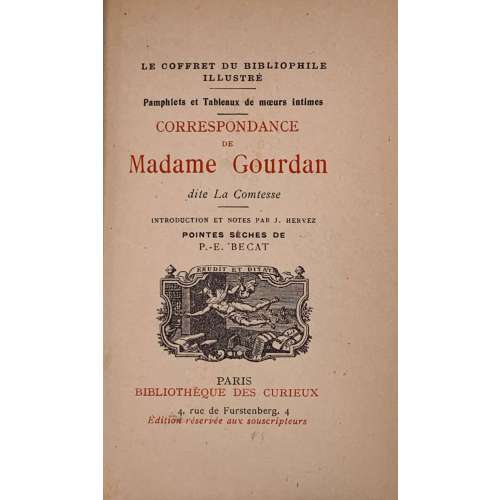 Front wrapper and title-page (in red and black): LE COFFRET DU BIBLIOPHILE ILLUSTRE | Pamphlets et Tableaux de mœurs intimes | CORRESPONDANCE | DE | Madame Gourdan | dite La Comtesse | INTRODUCTION ET NOTES PAR J. HERVEZ. | POINTES SÈCHES DE | P.-E. BECAT | {device} | PARIS | BIBLIOTHÈQUE DES CURIEUX | 4, rue de Furstenberg, 4 | Édition réservée aux souscripteurs || Limitation: L'édition illustrée du "Coffret | du bibliophile" est tirée à 750 | exemplaires, sur vergé de Rives, | – numérotés de 1 à 750 – | № 353 || Limited edition of 750 copies on Rives laid paper, of which this is copy № 353. Collation: fep, 3 blanks, front wrapper, 3 blanks vergé, [2] h.t. / limit., [2] t.p., [5] 6-188, blank, back wrapper, 3 blanks, fep., plus 12 plates, dry-points by P.-É. Bécat, extraneous to collation, incl. frontispiece. Binding: 16 x 10.3 cm, red crushed morocco, gilt lettering to spine, marbled endpapers, printed on laid paper, original wrappers preserved. Contributors: Marguerite Gourdan [Marguerite Alexandrine Ernestine Stock] (French, c. 1730 –1783) – fictional author. Jean Hervez (French, 1864 – ?) – author (preface). Charles Théveneau de Morande (French, 1741 – 1805) – presumable author of the text. Paul-Émile Bécat (French, 1885 – 1960) – artist. Bibliothèque des curieux [Georges & Robert Briffaut], Georges Briffaut (French, 1886 – 1973) – publisher. Previous editions: First published 1783, under the title: "Le portefeuille de Madame Gourdan" in London by Jean Nourse. Bibliothèque des curieux, 1910. Bibliothèque des curieux, 1924.
Front wrapper and title-page (in red and black): LE COFFRET DU BIBLIOPHILE ILLUSTRE | Pamphlets et Tableaux de mœurs intimes | CORRESPONDANCE | DE | Madame Gourdan | dite La Comtesse | INTRODUCTION ET NOTES PAR J. HERVEZ. | POINTES SÈCHES DE | P.-E. BECAT | {device} | PARIS | BIBLIOTHÈQUE DES CURIEUX | 4, rue de Furstenberg, 4 | Édition réservée aux souscripteurs || Limitation: L'édition illustrée du "Coffret | du bibliophile" est tirée à 750 | exemplaires, sur vergé de Rives, | – numérotés de 1 à 750 – | № 353 || Limited edition of 750 copies on Rives laid paper, of which this is copy № 353. Collation: fep, 3 blanks, front wrapper, 3 blanks vergé, [2] h.t. / limit., [2] t.p., [5] 6-188, blank, back wrapper, 3 blanks, fep., plus 12 plates, dry-points by P.-É. Bécat, extraneous to collation, incl. frontispiece. Binding: 16 x 10.3 cm, red crushed morocco, gilt lettering to spine, marbled endpapers, printed on laid paper, original wrappers preserved. Contributors: Marguerite Gourdan [Marguerite Alexandrine Ernestine Stock] (French, c. 1730 –1783) – fictional author. Jean Hervez (French, 1864 – ?) – author (preface). Charles Théveneau de Morande (French, 1741 – 1805) – presumable author of the text. Paul-Émile Bécat (French, 1885 – 1960) – artist. Bibliothèque des curieux [Georges & Robert Briffaut], Georges Briffaut (French, 1886 – 1973) – publisher. Previous editions: First published 1783, under the title: "Le portefeuille de Madame Gourdan" in London by Jean Nourse. Bibliothèque des curieux, 1910. Bibliothèque des curieux, 1924. -
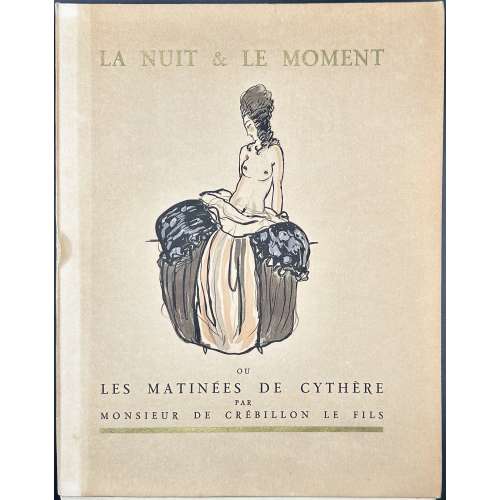 Softcover volume, 33 x 26 cm, collated in folio, not bound, in publisher’s French flapped pictorial wrappers, lettering to spine; printed on thick wove Arches paper watermarked “MBM”, upper edge trimmed, owner’s blind stamp to h.t. “Ex Libris Comte Tony de Vibraye”, glassine dust jacket, in a slipcase. Collation: π2 1-262, total 54 leaves, plus 4 leaves in wrappers, plus 10 plates, incl. frontispiece; coloured aquatints after Sylvain Sauvage; coloured etched vignette to front wrapper, gilt woodcut to back wrapper, woodcut title-page and woodcut headpiece after the same. Pp.: [4] [1] 2-102 [2]. Front wrapper (gilt and black): LA NUIT & LE MOMENT | {vignette} | OU | LES MATINÉES DE CYTHÈRE | PAR | MONSIEUR DE CRÉBILLON LE FILS | — || Title-page (woodcut): CRÉBILLON LE FILS | — | LA NUIT ET LE MOMENT | OU | LES MATINÉES | DE CYTHÈRE | {vignette} | A PARIS | AUX DEPENS D'UN AMATEUR | — | M CM XXIV || Limitation: De cette édition il a été tiré un exemplaire unique sur japon impérial comportant dix aquarelles originales, deux cents trente exemplaires sur vélin d' Arches numérotés 1 à 230, dont les dix premiers avec une suite de hors texte sur japon. N° 1 [Print run limited to 230 copies on Arches plus a unique copy on Japon with original watercolours, this is copy № 1 on wove paper]. Seller’s description: La Nuit et le moment ou Les Matinées de Cythère. Paris, Au dépens d'un amateur, 1924. In-4, en feuilles, non rogné, couverture illustrée et étui. Ouvrage illustré de 4 gravures sur bois et de 10 eaux-fortes libres en couleurs hors texte de Sylvain Sauvage. Tirage à 231 exemplaires, celui-ci le n°1 sur vélin d'Arches. Manque la suite de hors texte sur japon. De la bibliothèque du Comte Tony de Vibraye, avec cachet à froid. Dutel, n°2062. Catalogue raisonné: honesterotica.com; Dutel III 2062. Contributors: Claude-Prosper Jolyot de Crébillon [Crébillon fils] (French, 1707 – 1777) – author. Sylvain Sauvage [Félix Roy] (French, 1888 – 1948) – artist. Provenance: Antoine Henri Gaston Hurault de Vibraye [Comte Tony de Vibraye] (French, 1893 – 1951)
Softcover volume, 33 x 26 cm, collated in folio, not bound, in publisher’s French flapped pictorial wrappers, lettering to spine; printed on thick wove Arches paper watermarked “MBM”, upper edge trimmed, owner’s blind stamp to h.t. “Ex Libris Comte Tony de Vibraye”, glassine dust jacket, in a slipcase. Collation: π2 1-262, total 54 leaves, plus 4 leaves in wrappers, plus 10 plates, incl. frontispiece; coloured aquatints after Sylvain Sauvage; coloured etched vignette to front wrapper, gilt woodcut to back wrapper, woodcut title-page and woodcut headpiece after the same. Pp.: [4] [1] 2-102 [2]. Front wrapper (gilt and black): LA NUIT & LE MOMENT | {vignette} | OU | LES MATINÉES DE CYTHÈRE | PAR | MONSIEUR DE CRÉBILLON LE FILS | — || Title-page (woodcut): CRÉBILLON LE FILS | — | LA NUIT ET LE MOMENT | OU | LES MATINÉES | DE CYTHÈRE | {vignette} | A PARIS | AUX DEPENS D'UN AMATEUR | — | M CM XXIV || Limitation: De cette édition il a été tiré un exemplaire unique sur japon impérial comportant dix aquarelles originales, deux cents trente exemplaires sur vélin d' Arches numérotés 1 à 230, dont les dix premiers avec une suite de hors texte sur japon. N° 1 [Print run limited to 230 copies on Arches plus a unique copy on Japon with original watercolours, this is copy № 1 on wove paper]. Seller’s description: La Nuit et le moment ou Les Matinées de Cythère. Paris, Au dépens d'un amateur, 1924. In-4, en feuilles, non rogné, couverture illustrée et étui. Ouvrage illustré de 4 gravures sur bois et de 10 eaux-fortes libres en couleurs hors texte de Sylvain Sauvage. Tirage à 231 exemplaires, celui-ci le n°1 sur vélin d'Arches. Manque la suite de hors texte sur japon. De la bibliothèque du Comte Tony de Vibraye, avec cachet à froid. Dutel, n°2062. Catalogue raisonné: honesterotica.com; Dutel III 2062. Contributors: Claude-Prosper Jolyot de Crébillon [Crébillon fils] (French, 1707 – 1777) – author. Sylvain Sauvage [Félix Roy] (French, 1888 – 1948) – artist. Provenance: Antoine Henri Gaston Hurault de Vibraye [Comte Tony de Vibraye] (French, 1893 – 1951) -
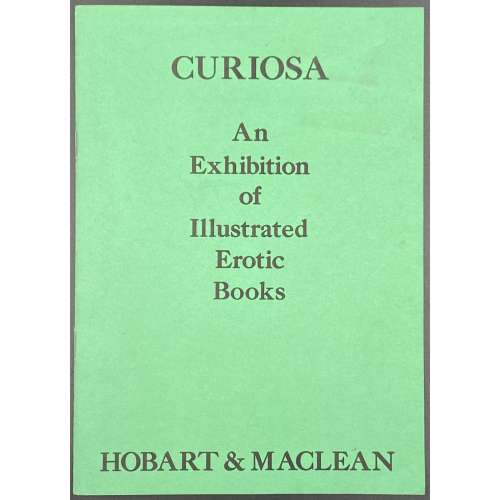 Title: CURIOSA | An | Exhibition | of | Illustrated | Erotic | Books | HOBART & MACLEAN || Pagination: 16 unpaginated pages with bibliography of 49 editions with prices and 51 images. Stapled softcover, original green wrappers with lettering to front and illustration to back. Size: 21 x 15 cm.
Title: CURIOSA | An | Exhibition | of | Illustrated | Erotic | Books | HOBART & MACLEAN || Pagination: 16 unpaginated pages with bibliography of 49 editions with prices and 51 images. Stapled softcover, original green wrappers with lettering to front and illustration to back. Size: 21 x 15 cm. -
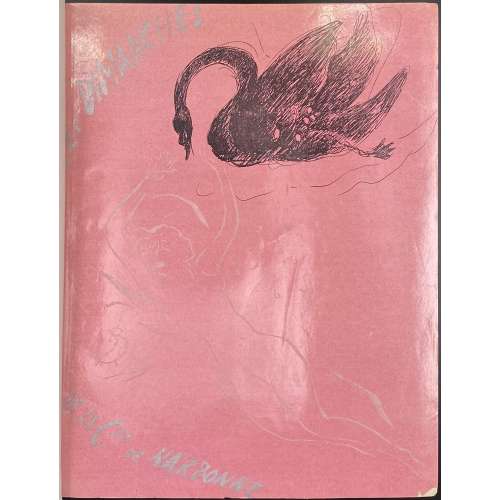 Description: Bound in brown ¾ morocco over marbled boards by R. et R. Mativet (ink stamp to ffep verso), collated 4to, 26.4 x 20.7 cm, raised bands, gilt arabesque and lettering to spine, original glossy pink pictorial wrappers preserved, marbled endpapers, bookplate to front pastedown “ML”, to front fep “EX-LIBRIS | Jacques | Crépineau”; A.L.s. of Marcel Vertès pasted to one of the feps: "Biblis [6] rue Jacques Callot. Cher Monsieur Le Bodo, Voudriez-vous avoir l’amabilité et de céder un exemplaire de « Dimanche » à M. Risler à un prix très réduit? Merci d’avance. Bien à vous, Vertès". Jean Le Bodo – abord gérant de la Librairie Biblis (20, rue du Vieux-Colombier, Paris 6e), et en 1946, libraire au Livre de France, Paris 16e; Risler – probablement Jean-François Risler (1910-1952), fils d’un pianiste Joseph-Édouard Risler (1873 – 1929). Title-page: DAISY FELLOWES | Les | Dimanches | de la | Csse de Narbonne | ILLUSTRATIONS | DE | VERTÈS | ÉDITIONS DE France | 20, AVENUE RAPP, PARIS || Collation: 1 blank, front wrapper, π4 (2 blanks with A.L.s. pasted to the 2nd, h.t., t.p.), 1-244 χ4 (table, colophon, 2 blanks) back wrapper, 1 blank; total 104 leaves within the wrappers, numerous in-text and 7 full-page prints after drawings by Marcel Vertès, within collation. Pagination: [8] [1-2] 3-191 [192] [8], total 208 pages, ils. Limitation: printed on June 25, 1935 by Coulouma (Argenteuil) under the direction of H. Barthélemy, 20 copies (№1-20) on Japon blanc super-nacré + two suites, 80 copies on Japon a la forme (№21-100) + one suite, 900 (№101-1000) on Vélin blanc. This is copy № 598. Catalogue raisonné: Vokaer (Vertès) № 34, p. 15. Provenance: Jacques Crepineau (French, 1932 – 2017). Contributors: Daisy Fellowes [Marguerite Séverine Philippine Decazes de Glücksberg] (French, 1890 – 1962) – author Marcel Vertès [Marcell Vértes] (Jewish-Hungarian-French, 1895 – 1961) – artist.
Description: Bound in brown ¾ morocco over marbled boards by R. et R. Mativet (ink stamp to ffep verso), collated 4to, 26.4 x 20.7 cm, raised bands, gilt arabesque and lettering to spine, original glossy pink pictorial wrappers preserved, marbled endpapers, bookplate to front pastedown “ML”, to front fep “EX-LIBRIS | Jacques | Crépineau”; A.L.s. of Marcel Vertès pasted to one of the feps: "Biblis [6] rue Jacques Callot. Cher Monsieur Le Bodo, Voudriez-vous avoir l’amabilité et de céder un exemplaire de « Dimanche » à M. Risler à un prix très réduit? Merci d’avance. Bien à vous, Vertès". Jean Le Bodo – abord gérant de la Librairie Biblis (20, rue du Vieux-Colombier, Paris 6e), et en 1946, libraire au Livre de France, Paris 16e; Risler – probablement Jean-François Risler (1910-1952), fils d’un pianiste Joseph-Édouard Risler (1873 – 1929). Title-page: DAISY FELLOWES | Les | Dimanches | de la | Csse de Narbonne | ILLUSTRATIONS | DE | VERTÈS | ÉDITIONS DE France | 20, AVENUE RAPP, PARIS || Collation: 1 blank, front wrapper, π4 (2 blanks with A.L.s. pasted to the 2nd, h.t., t.p.), 1-244 χ4 (table, colophon, 2 blanks) back wrapper, 1 blank; total 104 leaves within the wrappers, numerous in-text and 7 full-page prints after drawings by Marcel Vertès, within collation. Pagination: [8] [1-2] 3-191 [192] [8], total 208 pages, ils. Limitation: printed on June 25, 1935 by Coulouma (Argenteuil) under the direction of H. Barthélemy, 20 copies (№1-20) on Japon blanc super-nacré + two suites, 80 copies on Japon a la forme (№21-100) + one suite, 900 (№101-1000) on Vélin blanc. This is copy № 598. Catalogue raisonné: Vokaer (Vertès) № 34, p. 15. Provenance: Jacques Crepineau (French, 1932 – 2017). Contributors: Daisy Fellowes [Marguerite Séverine Philippine Decazes de Glücksberg] (French, 1890 – 1962) – author Marcel Vertès [Marcell Vértes] (Jewish-Hungarian-French, 1895 – 1961) – artist. -
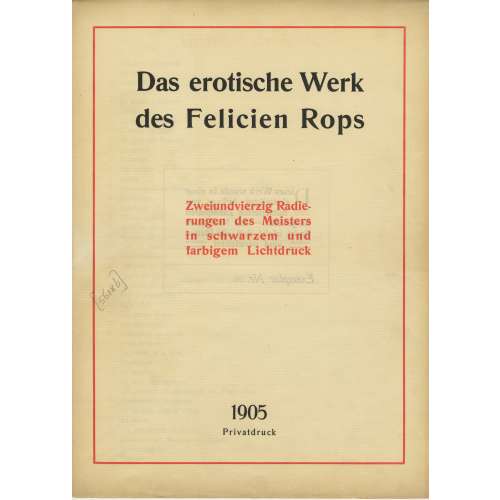
A limited-edition (№26/500) set of 42 etchings and drypoints after Félicien Rops (Belgian, 1833 – 1898), each mounted in a numbered passe-partout, printed posthumously by an anonym in Germany in 1905; in a flapped half faux suede-backed cardboard portfolio with straps, 442 x 335 mm, red embossed lettering to the front cover, bookplate of Richard Teschner (Austrian, 1879 – 1948) pasted inside.
Title-page (in a red frame): Das erotische Werk | des Felicien Rops | Zweiundvierzig Radie- | rungen des Meisters | in schwarzem und | farbigem Lichtdruck | 1905 | Privatdruk ||
Limitation (in a red two-section frame) : Dieses Werk wurde in einer | einmaligen Auflage von | 500 numerierten Exemplaren | hergestellt. — Ein Nachdruck | findet nicht statt, die Platten | == sind vernichtet == | Exemplar Nr. 26 ||
Verzeichnis der Tafeln (Table of Contents): 1. Initiation sentimentale; 2. La croix; 3. Entre-acte; 4. Holocauste; 5. La bonne hollandaise; 6. Étude; 7. La femme au pantin; 8. L’amour de Satan; 9. Au pays des féminies; 10. La volupté; 11. Evocation; 12. De castitate; 13. Joujou; 14. Vengeance d’une femme; 15. Phantasies; 16. Indolence; 17. Théâtre gaillard; 18. Appel au peuple; 19. Masques modernes; 20. Tout est grand chez les rois; 21. Marie-Madeleine; 22. L’amante du Christ; 23. Feuille de vigne; 24. La messe de Guide; 25 Viol et prostitution; 26. Le maillot; 27. Les jeunes France; 28. Les diaboliques; 29. Coquetterie au miroir; 30. Jeune homme; 31. La femme et la mort; 32. Confidence; 33. La bergère; 34. La mère aux satyrions; 35. Les exercices de dévotion de Mr. Henri Roch; 36. Mademoiselle de Maupin; 37. Le bonheur dans le crime; 38. La sirène; 39. Les cabotinages de l’amour; 40. Document sur l’impuissance d’aimer; 41. A cœur perdu; 42. Curieuse.
-
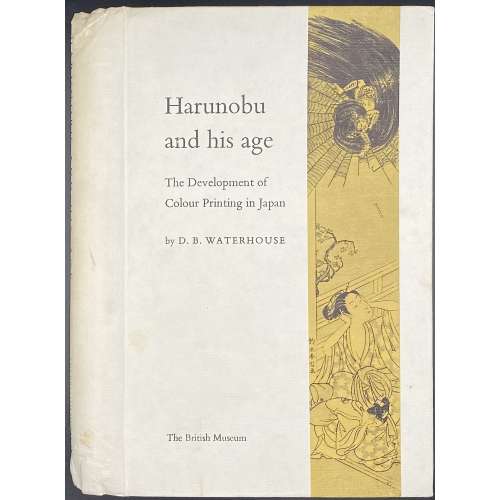
Pictorial cloth boards, spiral-bound, pp.: 3 leaves: h.t., frontis., t.p., 1-326; 123 black & white plates within the pagination.
-
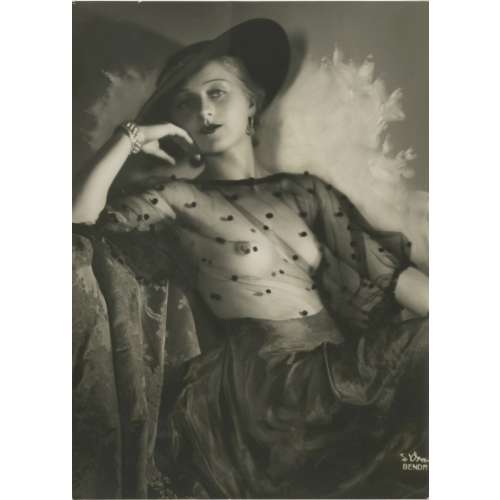 NEWGelatin silver print 212 x 153 mm depicting a sitting woman in a dress with a dotted sheer top and exposed chest, in a hat, with the torso in ¾, turning her head to face the viewer and supporting her head with her right hand. Artist’s device in the bottom-right corner: “d'Ora | Benda”. This is likely a portrait of a Parisian milliner, Madame Agnès, i.e. Agnès Rittener (French, d. 1949).Verso: Blue ink stamp: Copyright | d'ORA | Wien, I. | Arthur Benda | 14160 (ms pencil) || Below pasted a label with blue lettering, framed: AG. SCHOSTAL PARIS | 81, RUE BLANCHE | TEL. TRINITÉ 23.05 | № 7835 (ms red pencil) / WIEN | STARHEMBERGG. 26 | TEL. U-42-0-81 | № 48283 (ms graphite pencil) / MILANO | VIA VIVAIO 24 | Tel. 24,244 | № BEI VERÖFFENTLICHUNG ZU NENNEN: | PLEASE ACKNOWLEDGE: MENTION OBLIGATOIRE: MENZIONE OBBLIGATORIA: | d'Ora Benda, Wien (SCHOSTAL) || Agentur Schostal was an Austrian press photo agency named after its founder, Robert Franz Schostal (German, 1906 - c. 1973). Artist: Kallmus, Dora [Madame d’Ora] (Austrian-Jewish, 1881 – 1963)
NEWGelatin silver print 212 x 153 mm depicting a sitting woman in a dress with a dotted sheer top and exposed chest, in a hat, with the torso in ¾, turning her head to face the viewer and supporting her head with her right hand. Artist’s device in the bottom-right corner: “d'Ora | Benda”. This is likely a portrait of a Parisian milliner, Madame Agnès, i.e. Agnès Rittener (French, d. 1949).Verso: Blue ink stamp: Copyright | d'ORA | Wien, I. | Arthur Benda | 14160 (ms pencil) || Below pasted a label with blue lettering, framed: AG. SCHOSTAL PARIS | 81, RUE BLANCHE | TEL. TRINITÉ 23.05 | № 7835 (ms red pencil) / WIEN | STARHEMBERGG. 26 | TEL. U-42-0-81 | № 48283 (ms graphite pencil) / MILANO | VIA VIVAIO 24 | Tel. 24,244 | № BEI VERÖFFENTLICHUNG ZU NENNEN: | PLEASE ACKNOWLEDGE: MENTION OBLIGATOIRE: MENZIONE OBBLIGATORIA: | d'Ora Benda, Wien (SCHOSTAL) || Agentur Schostal was an Austrian press photo agency named after its founder, Robert Franz Schostal (German, 1906 - c. 1973). Artist: Kallmus, Dora [Madame d’Ora] (Austrian-Jewish, 1881 – 1963)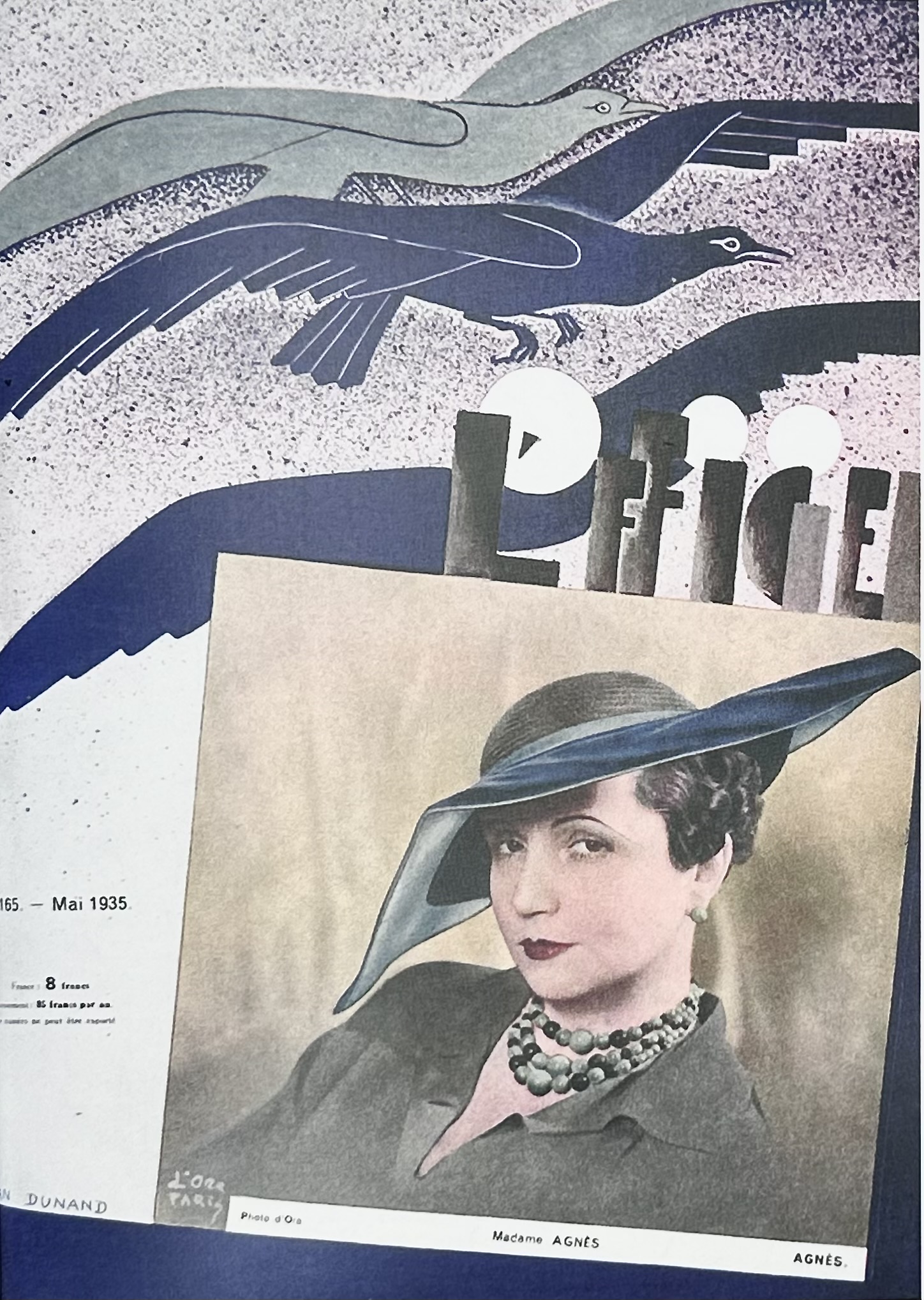
LIB-3351.2024 Madame d’Ora / edited by Monika Faber. – Munich, London, NY: Prestel Verlag / Neue Galerie, 2020, p.101.
-
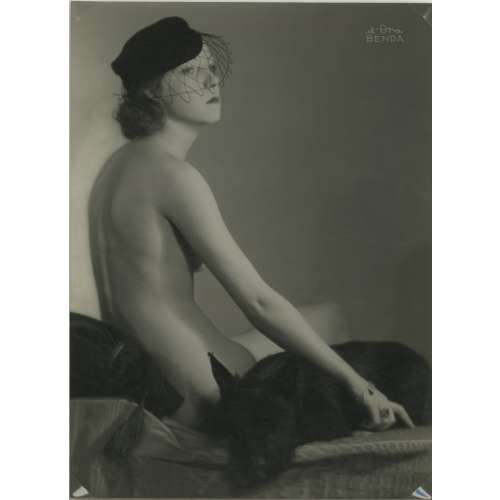 NEWA silver-bromide print 22 x 16 cm depicting a sitting woman, naked, in a veiled hat, with the torso in profile, turning her head ¾ towards the viewer, with a black terrier lying under her right hand. Artist’s device in the top-right corner: “d'Ora | Benda”. According to the seller, it is a portrait of Lisa Petersen, a nude dancer. Artist: Kallmus, Dora [Madame d’Ora] (Austrian-Jewish, 1881 – 1963)
NEWA silver-bromide print 22 x 16 cm depicting a sitting woman, naked, in a veiled hat, with the torso in profile, turning her head ¾ towards the viewer, with a black terrier lying under her right hand. Artist’s device in the top-right corner: “d'Ora | Benda”. According to the seller, it is a portrait of Lisa Petersen, a nude dancer. Artist: Kallmus, Dora [Madame d’Ora] (Austrian-Jewish, 1881 – 1963) -
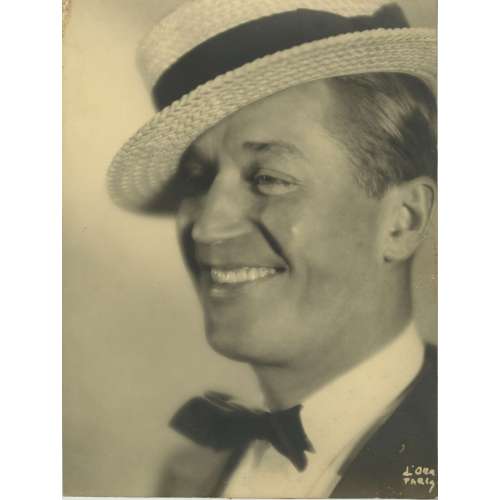 NEWA silver-bromide print 390 x 290 mm depicting actor and singer Maurice Chevalier in a straw hat, smiling, with his head in ¾, facing to the left, dry mounted on cardboard. Signature in white manuscript to the bottom-right corner “d’ORA | PARIS”. Sitter: Chevalier, Maurice Auguste (French, 1888 – 1972) Artist: Kallmus, Dora [Madame d’Ora] (Austrian-Jewish, 1881 – 1963)
NEWA silver-bromide print 390 x 290 mm depicting actor and singer Maurice Chevalier in a straw hat, smiling, with his head in ¾, facing to the left, dry mounted on cardboard. Signature in white manuscript to the bottom-right corner “d’ORA | PARIS”. Sitter: Chevalier, Maurice Auguste (French, 1888 – 1972) Artist: Kallmus, Dora [Madame d’Ora] (Austrian-Jewish, 1881 – 1963) -
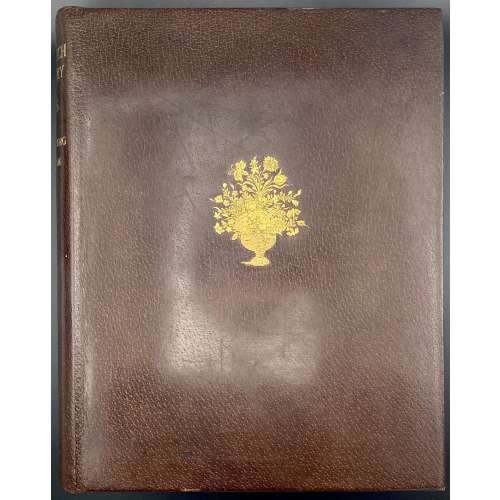 Title: OLD DUTCH | POTTERY AND TILES | BY ELISABETH | NEURDENBURG | LITT. D., READER IN THE HISTORY OF ART AT | THE UNIVERSITY OF GRONINGEN. TRANSLATED | WITH ANNOTATIONS BY | Bernard Rackham | DEPUTY KEEPER, DEPARTMENT | OF CERAMICS, VICTORIA AND | ALBERT MUSEUM | […] | WITH ONE HUNDRED AND TWELVE | ILLUSTRATIONS OF WHICH NINE | ARE IN COLOUR | LONDON: BENN BROTHERS, LIMITED | 8 BOUVERIE STREET, E.C. 4 | 1923 || Verso to half-title: Of this book 100 copies only for sale have been printed on English | hand-made paper, bound in pigskin and signed by the Authoress | and Translator. These copies also contain an extra colour plate. | This in Number “7” (in manuscript) | Two signatures (ink, manuscript) || Pagination: [i, ii] – h.t. / tirage, [iii, iv] – t.p. / imprint, [v, vi] – dedication to Dr. A. Pit / blank, vii-xv [xvi blank] [1, 2] 3-155 [156 blank], frontispiece (colour) and 59 leaves of plates (9 colour) with 112 figures, with lettered protective sheets. Collation: 4to in 8th; [A]8 [B]8 C-K8 L6; frontis., +59 leaves of plates. Binding: 30 x 24 cm, Full dark brown pigskin with gilt ornament to front board and gilt lettering to spine; printed on thick wove paper, top edge gilt, others untrimmed. Contributors: Neurdenburg, Elisabeth (Dutch, 1882 – 1957) – author [autograph]. Rackham, Bernard (British, 1876 – 1964) – translator [autograph]. Brendon, William (British, 1845 – 1928) – printer. Mayflower Press (Plymouth), William Brendon & Son, Ltd. – printer Benn Brothers Ltd. (British company, 1880 – 1987) Benn, Sir John, 1st Baronet (British, 1850 – 1922)
Title: OLD DUTCH | POTTERY AND TILES | BY ELISABETH | NEURDENBURG | LITT. D., READER IN THE HISTORY OF ART AT | THE UNIVERSITY OF GRONINGEN. TRANSLATED | WITH ANNOTATIONS BY | Bernard Rackham | DEPUTY KEEPER, DEPARTMENT | OF CERAMICS, VICTORIA AND | ALBERT MUSEUM | […] | WITH ONE HUNDRED AND TWELVE | ILLUSTRATIONS OF WHICH NINE | ARE IN COLOUR | LONDON: BENN BROTHERS, LIMITED | 8 BOUVERIE STREET, E.C. 4 | 1923 || Verso to half-title: Of this book 100 copies only for sale have been printed on English | hand-made paper, bound in pigskin and signed by the Authoress | and Translator. These copies also contain an extra colour plate. | This in Number “7” (in manuscript) | Two signatures (ink, manuscript) || Pagination: [i, ii] – h.t. / tirage, [iii, iv] – t.p. / imprint, [v, vi] – dedication to Dr. A. Pit / blank, vii-xv [xvi blank] [1, 2] 3-155 [156 blank], frontispiece (colour) and 59 leaves of plates (9 colour) with 112 figures, with lettered protective sheets. Collation: 4to in 8th; [A]8 [B]8 C-K8 L6; frontis., +59 leaves of plates. Binding: 30 x 24 cm, Full dark brown pigskin with gilt ornament to front board and gilt lettering to spine; printed on thick wove paper, top edge gilt, others untrimmed. Contributors: Neurdenburg, Elisabeth (Dutch, 1882 – 1957) – author [autograph]. Rackham, Bernard (British, 1876 – 1964) – translator [autograph]. Brendon, William (British, 1845 – 1928) – printer. Mayflower Press (Plymouth), William Brendon & Son, Ltd. – printer Benn Brothers Ltd. (British company, 1880 – 1987) Benn, Sir John, 1st Baronet (British, 1850 – 1922) -
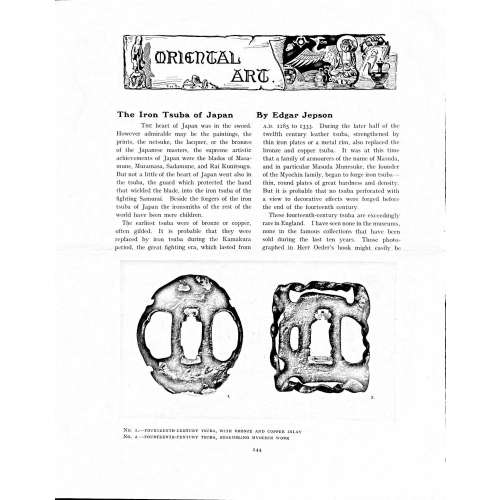 Magazine article by Edgar Jepson: The Iron Tsuba of Japan (Section: Oriental Art), published in volume Vol. 70 (September–December) of The Connoisseur: An Illustrated Magazine for Collectors, Vol. 70 (September–December); pp. 143-152 / C. Reginald Grundy [ed.] — London: Published by the Proprietor, W. CLAUSE JOHNSON, at the Editorial and Advertisement Offices of The Connoisseur, 1924. Owner's half black morocco, gilt lettering to spine, blue cloth boards. Two volumes bound together without original covers. Size 28.5 x 22 cm. Vol. 1: The Connoisseur | An Illustrated Magazine | For Collectors | Edited by C. Reginald Grundy | Vol. LXIX. | (MAY—AUGUST, 1924) | LONDON | Published by the Proprietor, W. CLAUSE JOHNSON, at the | Editorial and Advertisement Offices of The Connoisseur, | at 1, Duke Street, St. James's, S.W. 1 | 1924 || Pp.: [i-ii] iii-xviii [xix] [1, 2 - plate] 3-249 [250]. Vol. 2: The Connoisseur | An Illustrated Magazine | For Collectors | Edited by C. Reginald Grundy | Vol. LXX. | (SEPTEMBER—DECEMBER, 1924) | LONDON | Published by the Proprietor, W. CLAUSE JOHNSON, at the | Editorial and Advertisement Offices of The Connoisseur, | at 1, Duke Street, St. James's, S.W. 1 | 1924 || Pp.: [i-ii] iii-xxii [2 blanks] [1, 2 - plate] 3-261 [262]. The Iron Tsuba of Japan by Edgar Jepson The heart of Japan was in the sword. However admirable may be the paintings, the prints, the netsuke, the lacquer, or the bronzes of the Japanese masters, the supreme artistic achievements of Japan were the blades of Masamune, Muramasa, Sadamune, and Rai Kunitsugu. But not a little of the heart of Japan went also in the tsuba, the guard which protected the hand that wielded the blade, into the iron tsuba of the fighting Samurai. Beside the forgers of the iron tsuba of Japan the ironsmiths of the rest of the world have been mere children. The earliest tsuba were of bronze or copper, often gilded. It is probable that they were replaced by iron tsuba during the Kamakura period, the great fighting era, which lasted from A.D. 1185 to 1333. During the later half of the twelfth century leather tsuba, strengthened by thin iron plates or a metal rim, also replaced the bronze and copper tsuba. It was at this time that a family of armourers of the name of Masuda, and in particular Masuda Munesuke, the founder of the Myochin family, began to forge iron tsuba — thin, round plates of great hardness and density. But it is probable that no tsuba perforated with a view to decorative effects were forged before the end of the fourteenth century. These fourteenth-century tsuba are exceedingly rare in England. I have seen none in the museums, none in the famous collections that have been sold during the last ten years. Those photographed in Herr Oeder's book might easily be the fifteenth century. No. 1 is a curious cup-shape tsuba decorated with a bronze and copper inlay. No. 2, with its edges curiously twisted in the forging, looks like Myochin work. But it is not of the Myochin iron. The Myochin family produced some of the greatest ironsmiths of Japan. Armourers first of all, tsubasmiths, forgers of sake-kettles, articulated reptiles, crustacea, and insects — everything that can be done with iron they did; they pushed their medium to its limit. They were forging iron tsuba in 1160, and they were still forging them in 1860. And it was their own iron, or rather their own steel. They discovered the secret of it early, and they kept that secret in the family for all those hundreds of years. There is no mistaking a Myochin tsuba: balance it on your finger and tap it with a piece of metal, always it gives forth a clear bell-like ring that you get from the work of no other ironsmith, Japanese or European. Always the Myochin tsuba is before everything a protection to the hand of the swordsman; to that everything is, as it should be, subordinated. No. 3 is a Myochin tsuba of the fifteenth century, and probably of the early fifteenth century. No. 4, by Myochin Munetaka, perforated with a grotesque figure, is an example of that twisting and twisting of the iron in the forging till it forms a pattern like the grain of wood. The Myochin smiths invented these wood-grain tsuba, and no other smiths equalled them in their forging. In the sixteenth century, the fighting tsuba was probably at its best. It was a century of great tsubasmiths. Then the first Nobuiye, whose tsuba fetched £100 apiece, circa 1800, in Japan, and the first Kaneiye flourished. No. 5 is a tsuba forged by a great smith, Iyesada of Sotome, in the manner of Nobuiye I, decorated with the karakusa tendrils that Nobuiye delighted in, with lightning and clouds. No. 6 is a guard of Sanada Tembo, the chief smith of the Tembo family, stamped, punning fashion, with the character Tembo. Akin to the Tembo tsuba were those of the Kiami and Hoan smiths. Then also the Heianjo smiths and the Owari smiths, especially those of Nagoya and the Yamakichi family, forged their strongest tsuba. Those of the Yamakichi were tested after the forging by being pounded in iron mortars — at least, so the legend runs. But they were a sternly utilitarian family, and I have never seen a Yamakichi tsuba of any beauty. In the later half of the fifteenth century arose the fashion of decorating tsuba with an inlay, zogan, of bronze. The Heianjo tsuba, forged at Kyoto in the latter half of the fifteenth and the beginning of the sixteenth century, were often thus inlaid. The earliest of them were called "Onin", of which No. 7 is an example. In addition to the bronze inlay around the edge, it is inlaid with a representation, some say, of snow; others say, of the duckweed on a pond. No. 8 is probably a Heianjo tsuba, but I am not quite sure about it. The inlaid acacia branches might be very early Shoami work. But to judge by the iron, it is a fifteenth-century tsuba; and the authorities place the beginning of the Shoami school not later than early in the sixteenth century. No. 10 is an example of the Fushimi-zogan, a flat inlay of a light-coloured bronze. These tsuba took their name from the fact that they were first forged at Fushimi, in Yamashiro, in the sixteenth century. It is of the type known as Mon-zukashi, perforated with crests (mon) à jour. The Yoshiro-zogan tsuba were also first forged at Fushimi by Yoshiro Naomasa. They were distinguished from the Fushimi-zogan by the fact that their inlay was generally a little raised-not always-for the inlay of No. 9, a tsuba forged by a later nineteenth-century Yoshiro, is quite flat. It is an interesting tsuba, for, with its decoration grown florid and excessive, it marks the intermediate stage between the simple and delightful designs of the genuine fighting tsuba and the elaborate pictures in gold and silver on the tsuba of the eighteenth-century smiths of Awa and Kyoto, which have become mere ornaments of the goldsmith. The Gomoku-zogan (No. 11) tsuba were probably first forged earlier than the Fushimi and Yoshiro-zogan tsuba. This inlay, in slight relief, is a representation in a light-coloured bronze and copper of twigs caught in the eddies of streams. The seventeenth century and early eighteenth century were the great periods of perforated tsuba. The designs, and they are often admirable, are for the most part in plain fretwork; but they are also chased. No. 12, a crane under an acacia, is a tsuba of a Higo smith, great forgers of fighting tsuba during this period. These smiths also excelled in nunome zogan, a very thin gold and silver inlay, with which they further decorated their perforated guards. The smiths of the Umetada and Shoami families also forged iron tsuba during this period; but their designs, though sometimes pleasing enough, are rarely fine. The best work of Myoju Umetada is in sentoku, not iron. The Choshu smiths, coming later, surpass the perforated guards of both the Umetada and Shoami smiths in beauty of design. No. 13, a lotus in the round, not only fretwork, but also engraved, is a good example of the admirable balance they so often attained in their designs. It is a sufficiently realistic lotus, but yet of a delightful simplicity. In considerable contrast is No. 14, the dragon by Soheishi Soten — one of the only two authentic tsuba of his forging known — the first forger of hikone-bori tsuba, which were in extraordinary favour in Japan during the eighteenth century, and illustrated every important event in Japanese history. It is on the elaborate side, but fine, strong work, and an excellent guard to the hand, for the lighter and more open part, which gives the design its admirable balance, is on the inside, and not exposed to the full swing of an opponent's blade. A few years ago there was a tendency to decry the Namban tsuba as having sprung too directly from foreign sources. But though the original suggestion may have been Chinese, or, as some say, Portuguese, the Japanese made it entirely their own, as characteristically Japanese as anything can well be, but, it must be admitted, of a decadent period. The school took its rise at the beginning of the seventeenth century, and the early tsuba were forged of a specially hard iron, the Wootz, imported from Southern India. No. 15, the signs of the Zodiac, is an excellent tsuba from the fighting point of view. Both it and No. 16 are of quite charming, if elaborate, design, and both of them, with their delicate scroll-work, so astonishingly undercut, are the very last word in the work of the ironsmith-veritable iron lace. To return to the simpler perforated tsuba, the smiths of Akasaka, a suburb of Tokyo, produced probably the most charming designs. Their style derives considerably from the Higo smiths, and their earlier fighting tsuba are very like the Higo tsuba. But always their work was just a little lighter than that of the Higo smiths, and in the end they moved right away from them and became the forgers of very light guards indeed. No. 17, is a representation of the Hiyokudori, the fabulous double bird, in which were reincarnated the souls of the two lovers, Gompachi and Komurasaki; and No. 18, “the tsuba of a hundred ducks "— there are about forty — are characteristic designs of the school. In the work of the Akasaka smiths the balance, which makes the design of a good tsuba so admirable and delightful, attains its height. This admirable balance seems often to be obtained by a deliberate sacrifice of symmetry. About nine hundred and ninety-nine European ironsmiths out of a thousand would have made the right and left sides of the Hiyoku-dori line by line, and perforation by perforation, exactly alike; he would have cut out exactly as many ducks on the one side of “the tsuba of a hundred ducks” as on the other, and made each duck on the right side correspond exactly in position and attitude with a duck on the left side. By variations the tsubasmith attained a finer balance, almost a higher symmetry. No. 19, often called by collectors the "rose-window" tsuba, but really a stylised chrysanthemum, is a favourite design of the Akasaka smiths, but Hizen work and inlaid in the Hizen manner with gold nunome. No. 20 is a Satsuma tsuba of the middle period. The Satsuma smiths of the nineteenth century produced probably the most ornate of all the iron guards, for the most part calibashes and beans with their leaves and tendrils realistic in the extreme, but of charming design. Few crafts have been carried further than that of the tsubasmith; few crafts working in a difficult medium have handled more subjects with greater feeling for beauty or greater liveliness of fancy. It is interesting to note again and again how school influences school, and smith influences smith. But, as in all the applied arts, the finest tsuba were forged by men who never lost sight of the purpose of a tsuba, that it is before everything a protection to the hand, and never subjected that purpose to a passion for virtuosity. Illustrations: No 1. FOURTEENTH-CENTURY TSUBA, WITH BRONZE AND COPPER INLAY No. 2. FOURTEENTH-CENTURY TSUBA, RESEMBLING MYOCHIN WORK No. 3. MYOCHIN TSUBA, FIFTEENTH CENTURY No. 4. MYOCHIN TSUBA, NINETEENTH CENTURY No. 5. SIXTEENTH-CENTURY TSUBA No. 6. SIXTEENTH-CENTURY TSUBA BY IYESADA OF SOTOME BY SANADA TEMBO No. 7. ONIN TSUBA No. 8. HEIANJO (?) TSUBA No. 9. YOSHIRO TSUBA, NINETEENTH CENTURY No. 10. FUSHIMI-ZOGAN, NINETEENTH CENTURY No. 11.- GOMOKU-ZOGAN, SIXTEENTH CENTURY No. 12. HIGO TSUBA, SEVENTEENTH CENTURY No. 13. CHOSHU TSUBA, SEVENTEENTH CENTURY No. 14. SOTEN TSUBA, SEVENTEENTH CENTURY No. 15. NAMBAN TSUBA, EIGHTEENTH CENTURY No. 16. NAMBAN TSUBA, NINETEENTH CENTURY Nos. 17. AND 18. AKASAKA TSUBA, EIGHTEENTH CENTURY No. 19. HIZEN TSUBA, EIGHTEENTH CENTURY No. 20. SATSUMA TSUBA, EIGHTEENTH CENTURY
Magazine article by Edgar Jepson: The Iron Tsuba of Japan (Section: Oriental Art), published in volume Vol. 70 (September–December) of The Connoisseur: An Illustrated Magazine for Collectors, Vol. 70 (September–December); pp. 143-152 / C. Reginald Grundy [ed.] — London: Published by the Proprietor, W. CLAUSE JOHNSON, at the Editorial and Advertisement Offices of The Connoisseur, 1924. Owner's half black morocco, gilt lettering to spine, blue cloth boards. Two volumes bound together without original covers. Size 28.5 x 22 cm. Vol. 1: The Connoisseur | An Illustrated Magazine | For Collectors | Edited by C. Reginald Grundy | Vol. LXIX. | (MAY—AUGUST, 1924) | LONDON | Published by the Proprietor, W. CLAUSE JOHNSON, at the | Editorial and Advertisement Offices of The Connoisseur, | at 1, Duke Street, St. James's, S.W. 1 | 1924 || Pp.: [i-ii] iii-xviii [xix] [1, 2 - plate] 3-249 [250]. Vol. 2: The Connoisseur | An Illustrated Magazine | For Collectors | Edited by C. Reginald Grundy | Vol. LXX. | (SEPTEMBER—DECEMBER, 1924) | LONDON | Published by the Proprietor, W. CLAUSE JOHNSON, at the | Editorial and Advertisement Offices of The Connoisseur, | at 1, Duke Street, St. James's, S.W. 1 | 1924 || Pp.: [i-ii] iii-xxii [2 blanks] [1, 2 - plate] 3-261 [262]. The Iron Tsuba of Japan by Edgar Jepson The heart of Japan was in the sword. However admirable may be the paintings, the prints, the netsuke, the lacquer, or the bronzes of the Japanese masters, the supreme artistic achievements of Japan were the blades of Masamune, Muramasa, Sadamune, and Rai Kunitsugu. But not a little of the heart of Japan went also in the tsuba, the guard which protected the hand that wielded the blade, into the iron tsuba of the fighting Samurai. Beside the forgers of the iron tsuba of Japan the ironsmiths of the rest of the world have been mere children. The earliest tsuba were of bronze or copper, often gilded. It is probable that they were replaced by iron tsuba during the Kamakura period, the great fighting era, which lasted from A.D. 1185 to 1333. During the later half of the twelfth century leather tsuba, strengthened by thin iron plates or a metal rim, also replaced the bronze and copper tsuba. It was at this time that a family of armourers of the name of Masuda, and in particular Masuda Munesuke, the founder of the Myochin family, began to forge iron tsuba — thin, round plates of great hardness and density. But it is probable that no tsuba perforated with a view to decorative effects were forged before the end of the fourteenth century. These fourteenth-century tsuba are exceedingly rare in England. I have seen none in the museums, none in the famous collections that have been sold during the last ten years. Those photographed in Herr Oeder's book might easily be the fifteenth century. No. 1 is a curious cup-shape tsuba decorated with a bronze and copper inlay. No. 2, with its edges curiously twisted in the forging, looks like Myochin work. But it is not of the Myochin iron. The Myochin family produced some of the greatest ironsmiths of Japan. Armourers first of all, tsubasmiths, forgers of sake-kettles, articulated reptiles, crustacea, and insects — everything that can be done with iron they did; they pushed their medium to its limit. They were forging iron tsuba in 1160, and they were still forging them in 1860. And it was their own iron, or rather their own steel. They discovered the secret of it early, and they kept that secret in the family for all those hundreds of years. There is no mistaking a Myochin tsuba: balance it on your finger and tap it with a piece of metal, always it gives forth a clear bell-like ring that you get from the work of no other ironsmith, Japanese or European. Always the Myochin tsuba is before everything a protection to the hand of the swordsman; to that everything is, as it should be, subordinated. No. 3 is a Myochin tsuba of the fifteenth century, and probably of the early fifteenth century. No. 4, by Myochin Munetaka, perforated with a grotesque figure, is an example of that twisting and twisting of the iron in the forging till it forms a pattern like the grain of wood. The Myochin smiths invented these wood-grain tsuba, and no other smiths equalled them in their forging. In the sixteenth century, the fighting tsuba was probably at its best. It was a century of great tsubasmiths. Then the first Nobuiye, whose tsuba fetched £100 apiece, circa 1800, in Japan, and the first Kaneiye flourished. No. 5 is a tsuba forged by a great smith, Iyesada of Sotome, in the manner of Nobuiye I, decorated with the karakusa tendrils that Nobuiye delighted in, with lightning and clouds. No. 6 is a guard of Sanada Tembo, the chief smith of the Tembo family, stamped, punning fashion, with the character Tembo. Akin to the Tembo tsuba were those of the Kiami and Hoan smiths. Then also the Heianjo smiths and the Owari smiths, especially those of Nagoya and the Yamakichi family, forged their strongest tsuba. Those of the Yamakichi were tested after the forging by being pounded in iron mortars — at least, so the legend runs. But they were a sternly utilitarian family, and I have never seen a Yamakichi tsuba of any beauty. In the later half of the fifteenth century arose the fashion of decorating tsuba with an inlay, zogan, of bronze. The Heianjo tsuba, forged at Kyoto in the latter half of the fifteenth and the beginning of the sixteenth century, were often thus inlaid. The earliest of them were called "Onin", of which No. 7 is an example. In addition to the bronze inlay around the edge, it is inlaid with a representation, some say, of snow; others say, of the duckweed on a pond. No. 8 is probably a Heianjo tsuba, but I am not quite sure about it. The inlaid acacia branches might be very early Shoami work. But to judge by the iron, it is a fifteenth-century tsuba; and the authorities place the beginning of the Shoami school not later than early in the sixteenth century. No. 10 is an example of the Fushimi-zogan, a flat inlay of a light-coloured bronze. These tsuba took their name from the fact that they were first forged at Fushimi, in Yamashiro, in the sixteenth century. It is of the type known as Mon-zukashi, perforated with crests (mon) à jour. The Yoshiro-zogan tsuba were also first forged at Fushimi by Yoshiro Naomasa. They were distinguished from the Fushimi-zogan by the fact that their inlay was generally a little raised-not always-for the inlay of No. 9, a tsuba forged by a later nineteenth-century Yoshiro, is quite flat. It is an interesting tsuba, for, with its decoration grown florid and excessive, it marks the intermediate stage between the simple and delightful designs of the genuine fighting tsuba and the elaborate pictures in gold and silver on the tsuba of the eighteenth-century smiths of Awa and Kyoto, which have become mere ornaments of the goldsmith. The Gomoku-zogan (No. 11) tsuba were probably first forged earlier than the Fushimi and Yoshiro-zogan tsuba. This inlay, in slight relief, is a representation in a light-coloured bronze and copper of twigs caught in the eddies of streams. The seventeenth century and early eighteenth century were the great periods of perforated tsuba. The designs, and they are often admirable, are for the most part in plain fretwork; but they are also chased. No. 12, a crane under an acacia, is a tsuba of a Higo smith, great forgers of fighting tsuba during this period. These smiths also excelled in nunome zogan, a very thin gold and silver inlay, with which they further decorated their perforated guards. The smiths of the Umetada and Shoami families also forged iron tsuba during this period; but their designs, though sometimes pleasing enough, are rarely fine. The best work of Myoju Umetada is in sentoku, not iron. The Choshu smiths, coming later, surpass the perforated guards of both the Umetada and Shoami smiths in beauty of design. No. 13, a lotus in the round, not only fretwork, but also engraved, is a good example of the admirable balance they so often attained in their designs. It is a sufficiently realistic lotus, but yet of a delightful simplicity. In considerable contrast is No. 14, the dragon by Soheishi Soten — one of the only two authentic tsuba of his forging known — the first forger of hikone-bori tsuba, which were in extraordinary favour in Japan during the eighteenth century, and illustrated every important event in Japanese history. It is on the elaborate side, but fine, strong work, and an excellent guard to the hand, for the lighter and more open part, which gives the design its admirable balance, is on the inside, and not exposed to the full swing of an opponent's blade. A few years ago there was a tendency to decry the Namban tsuba as having sprung too directly from foreign sources. But though the original suggestion may have been Chinese, or, as some say, Portuguese, the Japanese made it entirely their own, as characteristically Japanese as anything can well be, but, it must be admitted, of a decadent period. The school took its rise at the beginning of the seventeenth century, and the early tsuba were forged of a specially hard iron, the Wootz, imported from Southern India. No. 15, the signs of the Zodiac, is an excellent tsuba from the fighting point of view. Both it and No. 16 are of quite charming, if elaborate, design, and both of them, with their delicate scroll-work, so astonishingly undercut, are the very last word in the work of the ironsmith-veritable iron lace. To return to the simpler perforated tsuba, the smiths of Akasaka, a suburb of Tokyo, produced probably the most charming designs. Their style derives considerably from the Higo smiths, and their earlier fighting tsuba are very like the Higo tsuba. But always their work was just a little lighter than that of the Higo smiths, and in the end they moved right away from them and became the forgers of very light guards indeed. No. 17, is a representation of the Hiyokudori, the fabulous double bird, in which were reincarnated the souls of the two lovers, Gompachi and Komurasaki; and No. 18, “the tsuba of a hundred ducks "— there are about forty — are characteristic designs of the school. In the work of the Akasaka smiths the balance, which makes the design of a good tsuba so admirable and delightful, attains its height. This admirable balance seems often to be obtained by a deliberate sacrifice of symmetry. About nine hundred and ninety-nine European ironsmiths out of a thousand would have made the right and left sides of the Hiyoku-dori line by line, and perforation by perforation, exactly alike; he would have cut out exactly as many ducks on the one side of “the tsuba of a hundred ducks” as on the other, and made each duck on the right side correspond exactly in position and attitude with a duck on the left side. By variations the tsubasmith attained a finer balance, almost a higher symmetry. No. 19, often called by collectors the "rose-window" tsuba, but really a stylised chrysanthemum, is a favourite design of the Akasaka smiths, but Hizen work and inlaid in the Hizen manner with gold nunome. No. 20 is a Satsuma tsuba of the middle period. The Satsuma smiths of the nineteenth century produced probably the most ornate of all the iron guards, for the most part calibashes and beans with their leaves and tendrils realistic in the extreme, but of charming design. Few crafts have been carried further than that of the tsubasmith; few crafts working in a difficult medium have handled more subjects with greater feeling for beauty or greater liveliness of fancy. It is interesting to note again and again how school influences school, and smith influences smith. But, as in all the applied arts, the finest tsuba were forged by men who never lost sight of the purpose of a tsuba, that it is before everything a protection to the hand, and never subjected that purpose to a passion for virtuosity. Illustrations: No 1. FOURTEENTH-CENTURY TSUBA, WITH BRONZE AND COPPER INLAY No. 2. FOURTEENTH-CENTURY TSUBA, RESEMBLING MYOCHIN WORK No. 3. MYOCHIN TSUBA, FIFTEENTH CENTURY No. 4. MYOCHIN TSUBA, NINETEENTH CENTURY No. 5. SIXTEENTH-CENTURY TSUBA No. 6. SIXTEENTH-CENTURY TSUBA BY IYESADA OF SOTOME BY SANADA TEMBO No. 7. ONIN TSUBA No. 8. HEIANJO (?) TSUBA No. 9. YOSHIRO TSUBA, NINETEENTH CENTURY No. 10. FUSHIMI-ZOGAN, NINETEENTH CENTURY No. 11.- GOMOKU-ZOGAN, SIXTEENTH CENTURY No. 12. HIGO TSUBA, SEVENTEENTH CENTURY No. 13. CHOSHU TSUBA, SEVENTEENTH CENTURY No. 14. SOTEN TSUBA, SEVENTEENTH CENTURY No. 15. NAMBAN TSUBA, EIGHTEENTH CENTURY No. 16. NAMBAN TSUBA, NINETEENTH CENTURY Nos. 17. AND 18. AKASAKA TSUBA, EIGHTEENTH CENTURY No. 19. HIZEN TSUBA, EIGHTEENTH CENTURY No. 20. SATSUMA TSUBA, EIGHTEENTH CENTURY -
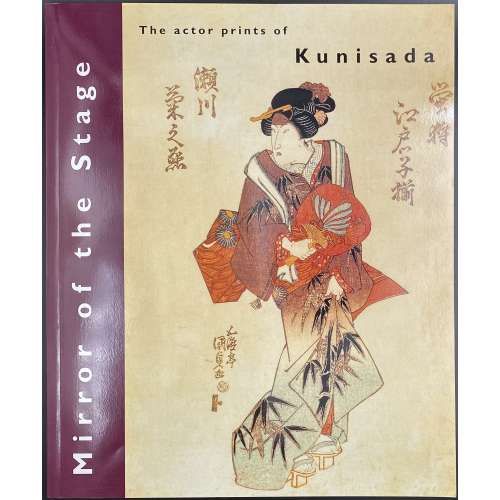 Thin booklet in glossy pictorial wrappers, 29.8 x 24.7 cm, pp.: [1-4] 5-48, 24 leaves total, illustrated. Errata tipped in after the front wrapper. Title-page: Mirror | of the stage | The actor prints of | Kunisada | Ellis Tinios | The University Gallery Leeds || Colophon: Published in March 1996 for the exhibition Mirror of the Stage held at the University Gallery Leeds 24 April-30 May 1996. Introduction: "This book [exhibition catalogue] has been written as an introduction to nineteenth-century Japanese colour woodblock actor prints and to the achievements of the artist Kunisada in that field [as well as to accompany the exhibition of the same name]. It is divided into three sections. In the first, I examine four topics: the social and cultural milieu that gave rise to the production of prints as items of mass consumption; the aesthetic of the actor print; the economics of print production (including consideration of the numbers issued, the prices at which they were sold and their rates of survival); and the process by which prints were produced. The second section consists of sixteen colour plates with commentaries. In the final section, I survey Kunisada's career." Subject: Utagawa, Kunisada, — 1786-1864 — Exhibitions; Ukiyo-e — Exhibitions; Colour prints, Japanese — Edo period, 1600-1868 — Exhibitions. Contributors: Ellis Tinios Utagawa Kunisada [歌川 国貞] a.k.a. Utagawa Toyokuni III [三代歌川豊国] (Japanese, 1786 – 1865). Select illustrations (references in this collection):
Thin booklet in glossy pictorial wrappers, 29.8 x 24.7 cm, pp.: [1-4] 5-48, 24 leaves total, illustrated. Errata tipped in after the front wrapper. Title-page: Mirror | of the stage | The actor prints of | Kunisada | Ellis Tinios | The University Gallery Leeds || Colophon: Published in March 1996 for the exhibition Mirror of the Stage held at the University Gallery Leeds 24 April-30 May 1996. Introduction: "This book [exhibition catalogue] has been written as an introduction to nineteenth-century Japanese colour woodblock actor prints and to the achievements of the artist Kunisada in that field [as well as to accompany the exhibition of the same name]. It is divided into three sections. In the first, I examine four topics: the social and cultural milieu that gave rise to the production of prints as items of mass consumption; the aesthetic of the actor print; the economics of print production (including consideration of the numbers issued, the prices at which they were sold and their rates of survival); and the process by which prints were produced. The second section consists of sixteen colour plates with commentaries. In the final section, I survey Kunisada's career." Subject: Utagawa, Kunisada, — 1786-1864 — Exhibitions; Ukiyo-e — Exhibitions; Colour prints, Japanese — Edo period, 1600-1868 — Exhibitions. Contributors: Ellis Tinios Utagawa Kunisada [歌川 国貞] a.k.a. Utagawa Toyokuni III [三代歌川豊国] (Japanese, 1786 – 1865). Select illustrations (references in this collection):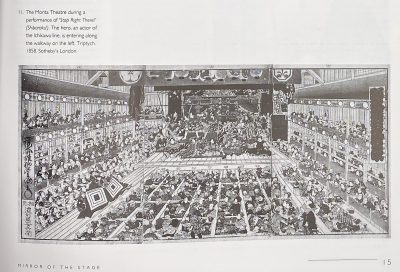
SVJP-0226.2016: Superb Edo pictures illustrating dances, 1858.
-
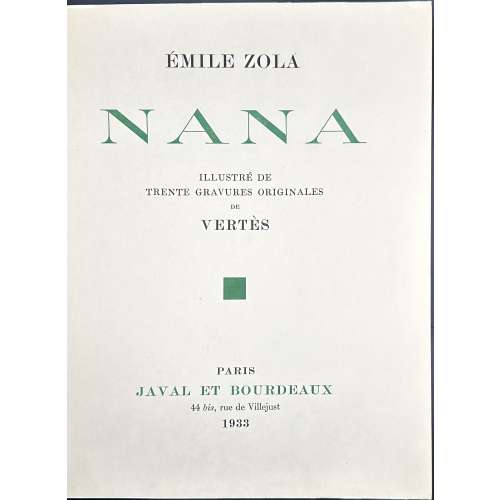 Publisher’s olive French flapped wrappers, in-4to, 33 x 25.3 x 6 cm, green and black lettering to front and spine, in a glassine dust jacket, in a marbled double slipcase 34.5 x 25.5 cm, unbound; pp.: [8] 1-436 [4], plus 30 colour plates with guard tissue, extraneous to collation; edition enriched with a set of 30 uncoloured etchings with guard tissue in a lettered paper folder. Title-page: ÉMILE ZOLA | NANA | ILLUSTRÉ DE | TRENTE GRAVURES ORIGINALES | DE | VERTÈS |◾| PARIS | JAVAL ET BOURDEAUX | 44 bis, rue de Villejust | 1933 || Justification du tirage: il a été tiré de «Nana » d'Émile Zola. Soixante exemplaires sur japon impérial, numérotés de 1 a 60, avec un état en couleurs colorié a la main et un état en noir des trente gravures originales de Vertès. [Edition limited to 60 copies, this is copy № 54]. Colophon: « NANA », D'ÉMILE ZOLA, ÉTÉ ACHEVÉ D'IMPRIMER LE TRENTE AVRIL MIL NEUF CENT TRENTE-TROIS, EN CARACTÈRES ROMAIN ANGLAIS DU CORPS 16, SUR LES PRESSES DU MAITRE IMPRIMEUR COULOUMA, À ARGENTEUIL, H. BARTHÉLEMY, DIRECTEUR. LES COMPOSITIONS DE VERTÈS ONT ÉTÉ REPRODUITES EN FAC-SIMILÉ PAR D. JACOMET & Cie. Printed on April 30, 1933 by Coulouma in Argenteuil, H. Barthélemy, director; illustrations reproduced in facsimile by D. Jacomet & Co. Catalogue raisonné: Vokaer 30. Contributors: Émile Zola (French, 1840 – 1902) – author. Marcel Vertès [Marcell Vértes] (Jewish-Hungarian-French, 1895 – 1961) – artist. Javal et Bourdeaux – publisher. Daniel Jacomet (French, 1894 – 1966) – printer. Seller's description: Nana. Paris, Javal et Bourdeaux, 1933. 2 volumes in-4, en feuilles, non coupé, non rogné, chemise et étui. Ouvrage illustré de 30 gravures originales en couleurs de Marcel Vertès. Tirage à 60 exemplaires sur japon impérial contenant un état des illustrations coloriées à la main en couleurs et un état en noir. Chemise et emboîtage insolés.
Publisher’s olive French flapped wrappers, in-4to, 33 x 25.3 x 6 cm, green and black lettering to front and spine, in a glassine dust jacket, in a marbled double slipcase 34.5 x 25.5 cm, unbound; pp.: [8] 1-436 [4], plus 30 colour plates with guard tissue, extraneous to collation; edition enriched with a set of 30 uncoloured etchings with guard tissue in a lettered paper folder. Title-page: ÉMILE ZOLA | NANA | ILLUSTRÉ DE | TRENTE GRAVURES ORIGINALES | DE | VERTÈS |◾| PARIS | JAVAL ET BOURDEAUX | 44 bis, rue de Villejust | 1933 || Justification du tirage: il a été tiré de «Nana » d'Émile Zola. Soixante exemplaires sur japon impérial, numérotés de 1 a 60, avec un état en couleurs colorié a la main et un état en noir des trente gravures originales de Vertès. [Edition limited to 60 copies, this is copy № 54]. Colophon: « NANA », D'ÉMILE ZOLA, ÉTÉ ACHEVÉ D'IMPRIMER LE TRENTE AVRIL MIL NEUF CENT TRENTE-TROIS, EN CARACTÈRES ROMAIN ANGLAIS DU CORPS 16, SUR LES PRESSES DU MAITRE IMPRIMEUR COULOUMA, À ARGENTEUIL, H. BARTHÉLEMY, DIRECTEUR. LES COMPOSITIONS DE VERTÈS ONT ÉTÉ REPRODUITES EN FAC-SIMILÉ PAR D. JACOMET & Cie. Printed on April 30, 1933 by Coulouma in Argenteuil, H. Barthélemy, director; illustrations reproduced in facsimile by D. Jacomet & Co. Catalogue raisonné: Vokaer 30. Contributors: Émile Zola (French, 1840 – 1902) – author. Marcel Vertès [Marcell Vértes] (Jewish-Hungarian-French, 1895 – 1961) – artist. Javal et Bourdeaux – publisher. Daniel Jacomet (French, 1894 – 1966) – printer. Seller's description: Nana. Paris, Javal et Bourdeaux, 1933. 2 volumes in-4, en feuilles, non coupé, non rogné, chemise et étui. Ouvrage illustré de 30 gravures originales en couleurs de Marcel Vertès. Tirage à 60 exemplaires sur japon impérial contenant un état des illustrations coloriées à la main en couleurs et un état en noir. Chemise et emboîtage insolés. -
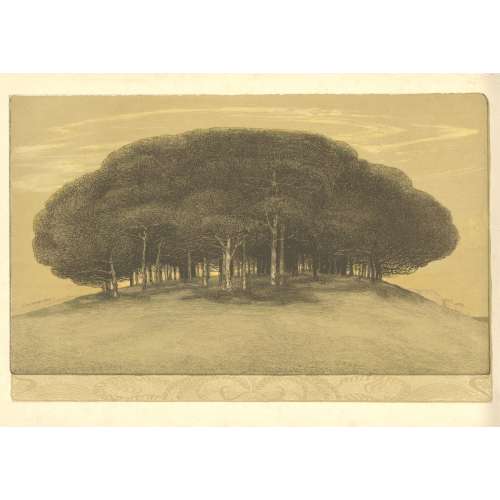 Colour (tone) lithography, image 268 x 410 mm, sheet 317 x 470 mm; signed on bottom-left of the image “Pelikan 1905”, and pencil ms inscription: E. Pelikan to the lower-right corner of the sheet. Contributor: Emilie Mediz-Pelikan (Austrian, 1861 – 1908) – artist. Seller's description: Austrian-German painter and graphic artist. Emilie Mediz-Pelikan was born in Vöcklabruck in 1861. She studied at the Vienna Academy and followed her teacher Albert Zimmermann to Salzburg and in 1885 to Munich. In 1891 she married the painter and graphic artist Karl Mediz (1868 - 1945), with whom she lived in Vienna and from 1894 in Dresden. She was in contact with the Dachau Artists' Colony and went on study trips to Paris, Belgium, Hungary and Italy. In the Dachau artists' colony she was friends with Adolf Hölzel and Fritz von Uhde. In 1889 and 1890 she spent time in Paris and in the Belgian artists' colony Knokke. In 1898 she was represented at the first art exhibition of the Vienna Secession, and in 1901 at the International Art Exhibition in Dresden. In 1903 she and her husband had a group exhibition, at the Hagenbund in Vienna. In 1904, she showed graphic works at the Dresden royal court art dealer Richter, and in 1905 and 1906 she exhibited at the Berlin Künstlerhaus. It was not until around 1900 that she achieved her artistic breakthrough with her landscape paintings. Since the estate of the artist, who died prematurely in Dresden in 1908, was lost in the former GDR until the 1980s, it was quite late that the artist was rediscovered and revalued both in Austrian art history and on the art market. In 1986, the first major exhibitions took place at the Upper Austrian State Museum and the University of Applied Arts in Vienna, followed by numerous smaller exhibitions in private galleries in Vienna, Linz and Munich. The artist received recognition during her lifetime from numerous prominent fellow painters as well as from the art critic Ludwig Hevesi. Together with Tina Blau, Herbert Boeckl, Marie Egner, Theodor von Hörmann, Franz Jaschke, Eugen Jettel, Ludwig Heinrich Jungnickel, Rudolf Junk, Gustav Klimt, Oskar Kokoschka, Johann Victor Krämer, Heinrich Kühn, Carl Moll, Rudolf Quittner, Rudolf Ribarz, Emil Jakob Schindler, Max Suppantschitsch, Max Weiler, Olga Wisinger-Florian and Alfred Zoff, she was a protagonist of the reception of Impressionism in Austria. This style went down in Austrian art history under the term "Stimmungsimpressionismus".
Colour (tone) lithography, image 268 x 410 mm, sheet 317 x 470 mm; signed on bottom-left of the image “Pelikan 1905”, and pencil ms inscription: E. Pelikan to the lower-right corner of the sheet. Contributor: Emilie Mediz-Pelikan (Austrian, 1861 – 1908) – artist. Seller's description: Austrian-German painter and graphic artist. Emilie Mediz-Pelikan was born in Vöcklabruck in 1861. She studied at the Vienna Academy and followed her teacher Albert Zimmermann to Salzburg and in 1885 to Munich. In 1891 she married the painter and graphic artist Karl Mediz (1868 - 1945), with whom she lived in Vienna and from 1894 in Dresden. She was in contact with the Dachau Artists' Colony and went on study trips to Paris, Belgium, Hungary and Italy. In the Dachau artists' colony she was friends with Adolf Hölzel and Fritz von Uhde. In 1889 and 1890 she spent time in Paris and in the Belgian artists' colony Knokke. In 1898 she was represented at the first art exhibition of the Vienna Secession, and in 1901 at the International Art Exhibition in Dresden. In 1903 she and her husband had a group exhibition, at the Hagenbund in Vienna. In 1904, she showed graphic works at the Dresden royal court art dealer Richter, and in 1905 and 1906 she exhibited at the Berlin Künstlerhaus. It was not until around 1900 that she achieved her artistic breakthrough with her landscape paintings. Since the estate of the artist, who died prematurely in Dresden in 1908, was lost in the former GDR until the 1980s, it was quite late that the artist was rediscovered and revalued both in Austrian art history and on the art market. In 1986, the first major exhibitions took place at the Upper Austrian State Museum and the University of Applied Arts in Vienna, followed by numerous smaller exhibitions in private galleries in Vienna, Linz and Munich. The artist received recognition during her lifetime from numerous prominent fellow painters as well as from the art critic Ludwig Hevesi. Together with Tina Blau, Herbert Boeckl, Marie Egner, Theodor von Hörmann, Franz Jaschke, Eugen Jettel, Ludwig Heinrich Jungnickel, Rudolf Junk, Gustav Klimt, Oskar Kokoschka, Johann Victor Krämer, Heinrich Kühn, Carl Moll, Rudolf Quittner, Rudolf Ribarz, Emil Jakob Schindler, Max Suppantschitsch, Max Weiler, Olga Wisinger-Florian and Alfred Zoff, she was a protagonist of the reception of Impressionism in Austria. This style went down in Austrian art history under the term "Stimmungsimpressionismus". -
 Colour (tone) lithography, image 396 x 508 mm, sheet 532 x 654 mm; before signature, undated; pencil ms inscription: Föhrenhain — E. Pelikan / 200M to the lower-right corner of the sheet. Contributor: Emilie Mediz-Pelikan (Austrian, 1861 – 1908) – artist. Seller's description: Austrian-German painter and graphic artist. Emilie Mediz-Pelikan was born in Vöcklabruck in 1861. She studied at the Vienna Academy and followed her teacher Albert Zimmermann to Salzburg and in 1885 to Munich. In 1891 she married the painter and graphic artist Karl Mediz (1868 - 1945), with whom she lived in Vienna and from 1894 in Dresden. She was in contact with the Dachau Artists' Colony and went on study trips to Paris, Belgium, Hungary and Italy. In the Dachau artists' colony she was friends with Adolf Hölzel and Fritz von Uhde. In 1889 and 1890 she spent time in Paris and in the Belgian artists' colony Knokke. In 1898 she was represented at the first art exhibition of the Vienna Secession, and in 1901 at the International Art Exhibition in Dresden. In 1903 she and her husband had a group exhibition, at the Hagenbund in Vienna. In 1904, she showed graphic works at the Dresden royal court art dealer Richter, and in 1905 and 1906 she exhibited at the Berlin Künstlerhaus. It was not until around 1900 that she achieved her artistic breakthrough with her landscape paintings. Since the estate of the artist, who died prematurely in Dresden in 1908, was lost in the former GDR until the 1980s, it was quite late that the artist was rediscovered and revalued both in Austrian art history and on the art market. In 1986, the first major exhibitions took place at the Upper Austrian State Museum and the University of Applied Arts in Vienna, followed by numerous smaller exhibitions in private galleries in Vienna, Linz and Munich. The artist received recognition during her lifetime from numerous prominent fellow painters as well as from the art critic Ludwig Hevesi. Together with Tina Blau, Herbert Boeckl, Marie Egner, Theodor von Hörmann, Franz Jaschke, Eugen Jettel, Ludwig Heinrich Jungnickel, Rudolf Junk, Gustav Klimt, Oskar Kokoschka, Johann Victor Krämer, Heinrich Kühn, Carl Moll, Rudolf Quittner, Rudolf Ribarz, Emil Jakob Schindler, Max Suppantschitsch, Max Weiler, Olga Wisinger-Florian and Alfred Zoff, she was a protagonist of the reception of Impressionism in Austria. This style went down in Austrian art history under the term "Stimmungsimpressionismus".
Colour (tone) lithography, image 396 x 508 mm, sheet 532 x 654 mm; before signature, undated; pencil ms inscription: Föhrenhain — E. Pelikan / 200M to the lower-right corner of the sheet. Contributor: Emilie Mediz-Pelikan (Austrian, 1861 – 1908) – artist. Seller's description: Austrian-German painter and graphic artist. Emilie Mediz-Pelikan was born in Vöcklabruck in 1861. She studied at the Vienna Academy and followed her teacher Albert Zimmermann to Salzburg and in 1885 to Munich. In 1891 she married the painter and graphic artist Karl Mediz (1868 - 1945), with whom she lived in Vienna and from 1894 in Dresden. She was in contact with the Dachau Artists' Colony and went on study trips to Paris, Belgium, Hungary and Italy. In the Dachau artists' colony she was friends with Adolf Hölzel and Fritz von Uhde. In 1889 and 1890 she spent time in Paris and in the Belgian artists' colony Knokke. In 1898 she was represented at the first art exhibition of the Vienna Secession, and in 1901 at the International Art Exhibition in Dresden. In 1903 she and her husband had a group exhibition, at the Hagenbund in Vienna. In 1904, she showed graphic works at the Dresden royal court art dealer Richter, and in 1905 and 1906 she exhibited at the Berlin Künstlerhaus. It was not until around 1900 that she achieved her artistic breakthrough with her landscape paintings. Since the estate of the artist, who died prematurely in Dresden in 1908, was lost in the former GDR until the 1980s, it was quite late that the artist was rediscovered and revalued both in Austrian art history and on the art market. In 1986, the first major exhibitions took place at the Upper Austrian State Museum and the University of Applied Arts in Vienna, followed by numerous smaller exhibitions in private galleries in Vienna, Linz and Munich. The artist received recognition during her lifetime from numerous prominent fellow painters as well as from the art critic Ludwig Hevesi. Together with Tina Blau, Herbert Boeckl, Marie Egner, Theodor von Hörmann, Franz Jaschke, Eugen Jettel, Ludwig Heinrich Jungnickel, Rudolf Junk, Gustav Klimt, Oskar Kokoschka, Johann Victor Krämer, Heinrich Kühn, Carl Moll, Rudolf Quittner, Rudolf Ribarz, Emil Jakob Schindler, Max Suppantschitsch, Max Weiler, Olga Wisinger-Florian and Alfred Zoff, she was a protagonist of the reception of Impressionism in Austria. This style went down in Austrian art history under the term "Stimmungsimpressionismus". -
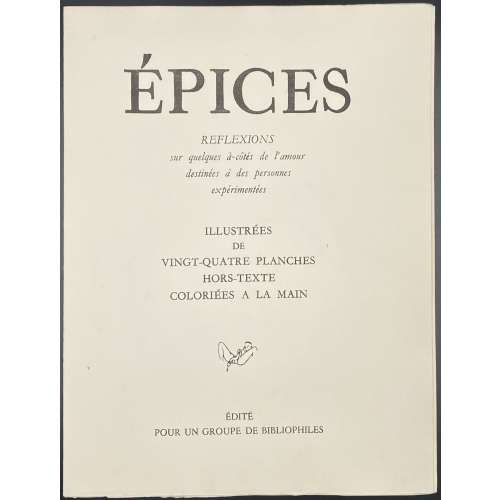 Description: French flapped wrappers, 27 x 20.5 cm, 134 gatherings, plus two leaves (blank, h.t. / limitation) at the beginning (54 leaves total), the first and the last two leaves blank, two pages in each of 12 gatherings (24 total) are hand-painted photogravures after etchings by an anonymous artist, attributed to Santippa, pseudonym of Georges or Gaston Hoffmann, or, possibly, of André Collot; the gatherings are unbound, pp. [1-10] 11-99 [100] [8] (108 pages total). Title-page: ÉPICES | REFLEXIONS | sur quelques à-côtés de l'amour | destinées à des personnes | expérimentées | ILLUSTREES | DE | VINGT-QUATRE PLANCHES | HORS-TEXTE | COLORIÉES A LA MAIN | {vignette} | ÉDITÉ | POUR UN GROUPE DE BIBLIOPHILES || Edition: limited to 500 copies numbered from 1 to 480 + 20 hand-numbered with Roman numbers. This is copy № 273. Enrichment: one original sketch (for Coucou… ou l’erreur de porte), one etching before letters and the same after letters and coloured (Le petit coin tranquille.. 19/20), and a full suite of 24 original etchings in sepia on cream paper, 20 of them on Arches and 4 on BFK Rives) printed for the first 17 copies of the 1950 edition (55 copies were printed then). In addition: one graphite pencil sketch which is not part of the suite. Catalogue raisonné: Dutel 1920 – 1970: № 1490 (for 1950), № 1491 (for 1955).
Description: French flapped wrappers, 27 x 20.5 cm, 134 gatherings, plus two leaves (blank, h.t. / limitation) at the beginning (54 leaves total), the first and the last two leaves blank, two pages in each of 12 gatherings (24 total) are hand-painted photogravures after etchings by an anonymous artist, attributed to Santippa, pseudonym of Georges or Gaston Hoffmann, or, possibly, of André Collot; the gatherings are unbound, pp. [1-10] 11-99 [100] [8] (108 pages total). Title-page: ÉPICES | REFLEXIONS | sur quelques à-côtés de l'amour | destinées à des personnes | expérimentées | ILLUSTREES | DE | VINGT-QUATRE PLANCHES | HORS-TEXTE | COLORIÉES A LA MAIN | {vignette} | ÉDITÉ | POUR UN GROUPE DE BIBLIOPHILES || Edition: limited to 500 copies numbered from 1 to 480 + 20 hand-numbered with Roman numbers. This is copy № 273. Enrichment: one original sketch (for Coucou… ou l’erreur de porte), one etching before letters and the same after letters and coloured (Le petit coin tranquille.. 19/20), and a full suite of 24 original etchings in sepia on cream paper, 20 of them on Arches and 4 on BFK Rives) printed for the first 17 copies of the 1950 edition (55 copies were printed then). In addition: one graphite pencil sketch which is not part of the suite. Catalogue raisonné: Dutel 1920 – 1970: № 1490 (for 1950), № 1491 (for 1955).

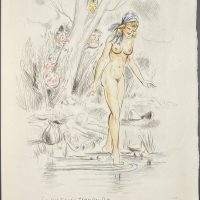
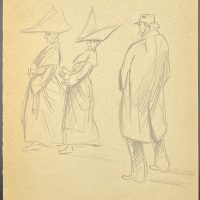
-
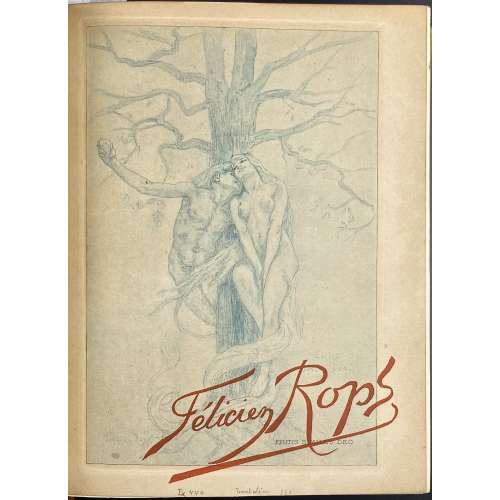 One volume in-4o, 26.5 x 21 x 4.4 cm, bound by Durvand (signed) in yellow ¾ morocco over marbled boards outlined in gilt, spine with raised bands, gilt lettering, vignettes after Félicien Rops in compartments, top margin gilt, marbled endpapers, publisher’s wrappers preserved; enriched with 57 original prints after Félicien Rops and an etched portrait of Félicien Rops by Robert Kastor. Collation: 3 blanks, π4 (orig. front wrapper ‘En souscription…./Etudes sur…’, La tentation…/Érastène Ramiro..., h.t./justification, t.p/blank), 1-274 (paginated 1-215 [216]) χ2 plus 58 leaves of bound-in original prints by various printers on different papers, some on India paper pasted on vergé, with tissue guards, and 1 leave of manuscript ‘Table de gravures dans le texte’; back wrapper with ‘Table des gravures ajoutées’ manuscript to recto, original spine, 2 blanks. Title-page (red and black): Études sur quelques Artistes originaux | — | FÉLICIEN ROPS | par | ÉRASTÈNE RAMIRO | {fleuron} | PARIS | (left): G. PELLET | 51, Rue Le Peletier, 51 | (right): H. FLOURY | 1, Boulevard des Capucines, 1 | 1905 || Limitation: 125 copies, of which 100 copies on Japon à la forme and 25 copies 0n papier de Chine. Photographs here represent the original prints only. Contributors: Eugène Rodrigues-Henriques [Eugène Rodrigues, Erastène Ramiro] (French, 1853 –1928) – author. Félicien Rops (Belgian, 1833 – 1898) – artist. Robert Kastor (French, 1872 – 1935) – artist. Imprimerie Charles Hérissey (Évreux) – printer Gustave Pellet (French, 1859 – 1919) – publisher. Henri Floury (French, 1862 –1961) – publisher. Lucien Durvand (French, 1852 – 1924) – bookbinder.
One volume in-4o, 26.5 x 21 x 4.4 cm, bound by Durvand (signed) in yellow ¾ morocco over marbled boards outlined in gilt, spine with raised bands, gilt lettering, vignettes after Félicien Rops in compartments, top margin gilt, marbled endpapers, publisher’s wrappers preserved; enriched with 57 original prints after Félicien Rops and an etched portrait of Félicien Rops by Robert Kastor. Collation: 3 blanks, π4 (orig. front wrapper ‘En souscription…./Etudes sur…’, La tentation…/Érastène Ramiro..., h.t./justification, t.p/blank), 1-274 (paginated 1-215 [216]) χ2 plus 58 leaves of bound-in original prints by various printers on different papers, some on India paper pasted on vergé, with tissue guards, and 1 leave of manuscript ‘Table de gravures dans le texte’; back wrapper with ‘Table des gravures ajoutées’ manuscript to recto, original spine, 2 blanks. Title-page (red and black): Études sur quelques Artistes originaux | — | FÉLICIEN ROPS | par | ÉRASTÈNE RAMIRO | {fleuron} | PARIS | (left): G. PELLET | 51, Rue Le Peletier, 51 | (right): H. FLOURY | 1, Boulevard des Capucines, 1 | 1905 || Limitation: 125 copies, of which 100 copies on Japon à la forme and 25 copies 0n papier de Chine. Photographs here represent the original prints only. Contributors: Eugène Rodrigues-Henriques [Eugène Rodrigues, Erastène Ramiro] (French, 1853 –1928) – author. Félicien Rops (Belgian, 1833 – 1898) – artist. Robert Kastor (French, 1872 – 1935) – artist. Imprimerie Charles Hérissey (Évreux) – printer Gustave Pellet (French, 1859 – 1919) – publisher. Henri Floury (French, 1862 –1961) – publisher. Lucien Durvand (French, 1852 – 1924) – bookbinder.


